第六模块:WEB框架开发 第1章·Django框架开发88~128
- 88-Ajax简介
- 89-Ajax的简单实现
- 90-基于Ajax的传递数据
- 91-基于Ajax的登录验证
- 92-基于Form表单的文件上传
- 93-请求头之contentType
- 94-Ajax传递json数据
- 95-基于Ajax的文件上传
- 96-分页器1
- 97-分页器2
- 98-分页器3
- 99-分页器4
- 100-form组件的校验功能
- 101-form组件的渲染标签功能1
- 102-form组件的渲染标签功能2
- 103-form组件的渲染错误信息
- 104-form组件的参数配置
- 105-form组件检验的局部钩子
- 106-组件之全局钩子校验
- 107-HTTP协议的无状态保存
- 108-Cookie简介
- 109-Cookie的设置与读取
- 110-设置Cookie的超时参数
- 111-设置Cookie的有效路径
- 112-Cookie应用之保存上次访问时间
- 113-session的流程简介
- 114-session之保存登录状态
- 115-session应用之保存上次登录时间
- 116-session的更新操作
- 117-基于session的注销功能
- 118-session的总结
- 119-用户认证组件简介
- 120-基于用户认证组件的登录验证信息存储
- 121-基于用户认证组件的注销功能
- 122-基于用户认证组件的注册用户功能
- 123-基于用户认证组件的认证装饰器
- 124-中间件的实现流程
- 125-中间件的process_request和process_response方法
- 126-中间件之process_view方法
- 127-中间件之process_exception
- 128-中间之应用
88-Ajax简介
1、什么是Ajax?
AJAX(Asynchronous Javascript And XML)翻译成中文就是“异步Javascript和XML”。即使用Javascript语言与服务器进行异步交互,传输的数据为XML(当然,传输的数据不只是XML,现在更多使用json数据);
-
同步交互:客户端发出一个请求后,需要等待服务器响应结束后,才能发出第二个请求;
-
异步交互:客户端发出一个请求后,无需等待服务器响应结束,就可以发出第二个请求;
AJAX除了异步的特点外,还有一个就是:浏览器页面局部刷新;(这一特点给用户的感受是在不知不觉中完成请求和响应过程);
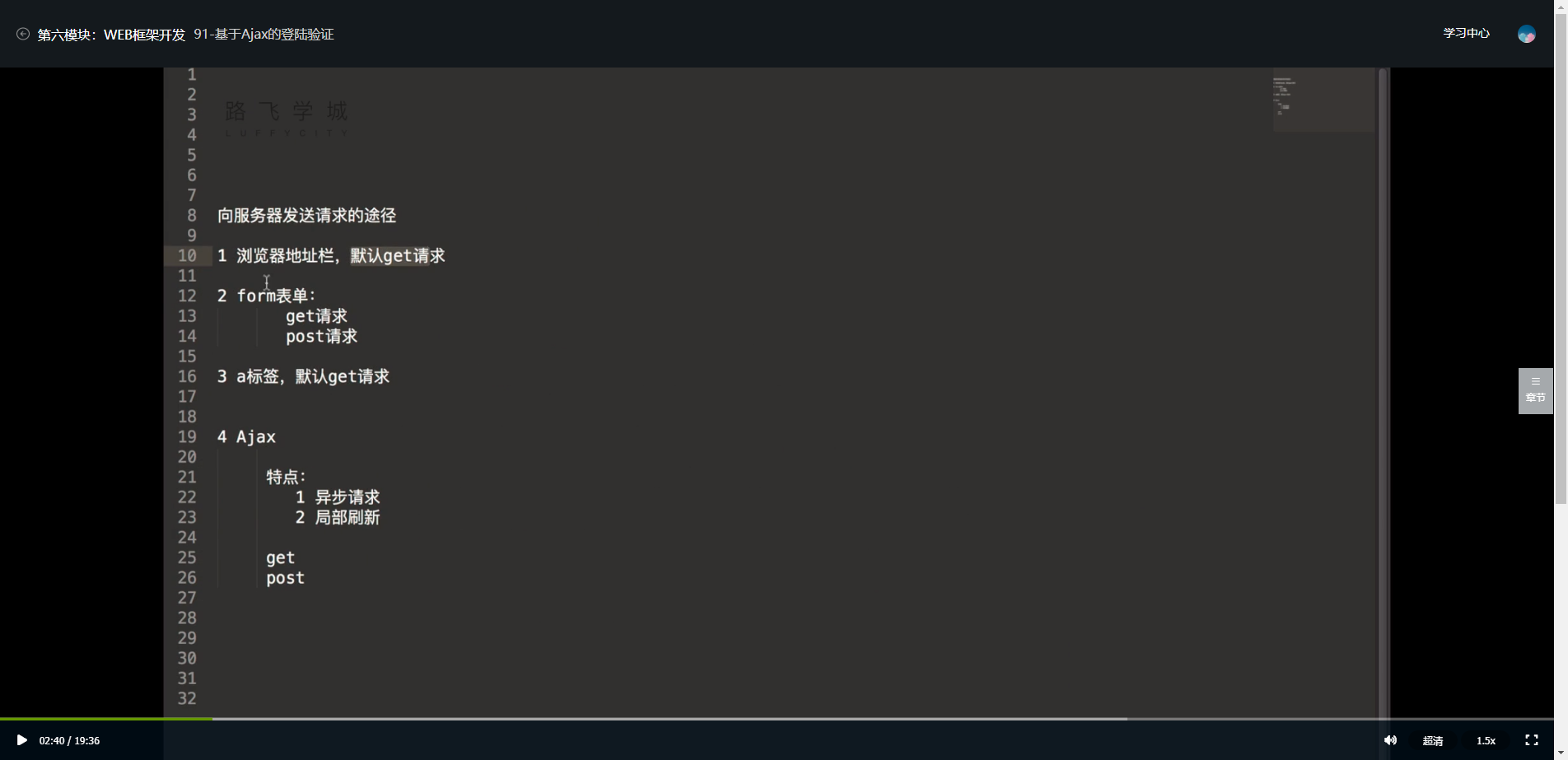
2、Ajax的使用场景;

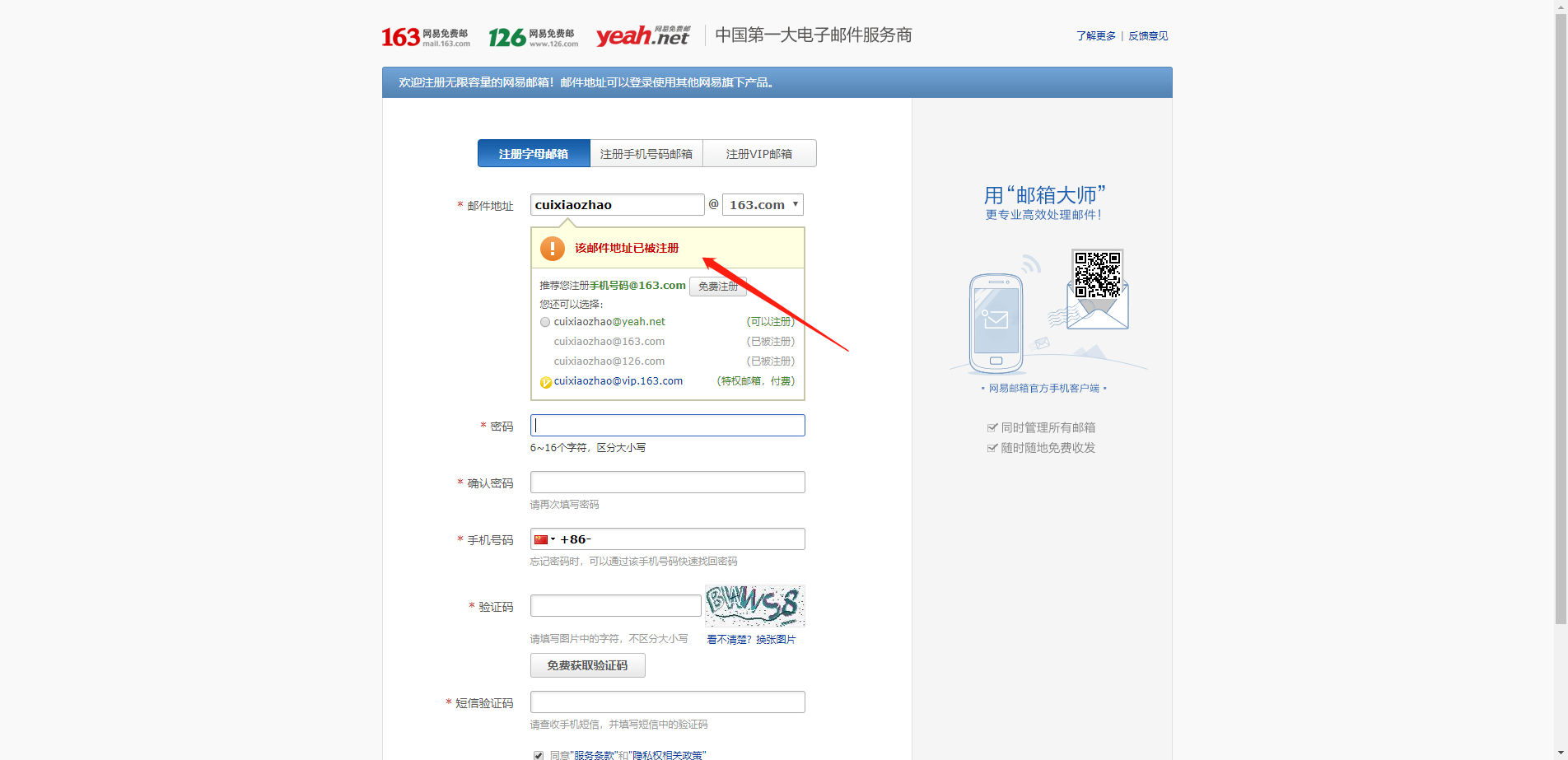
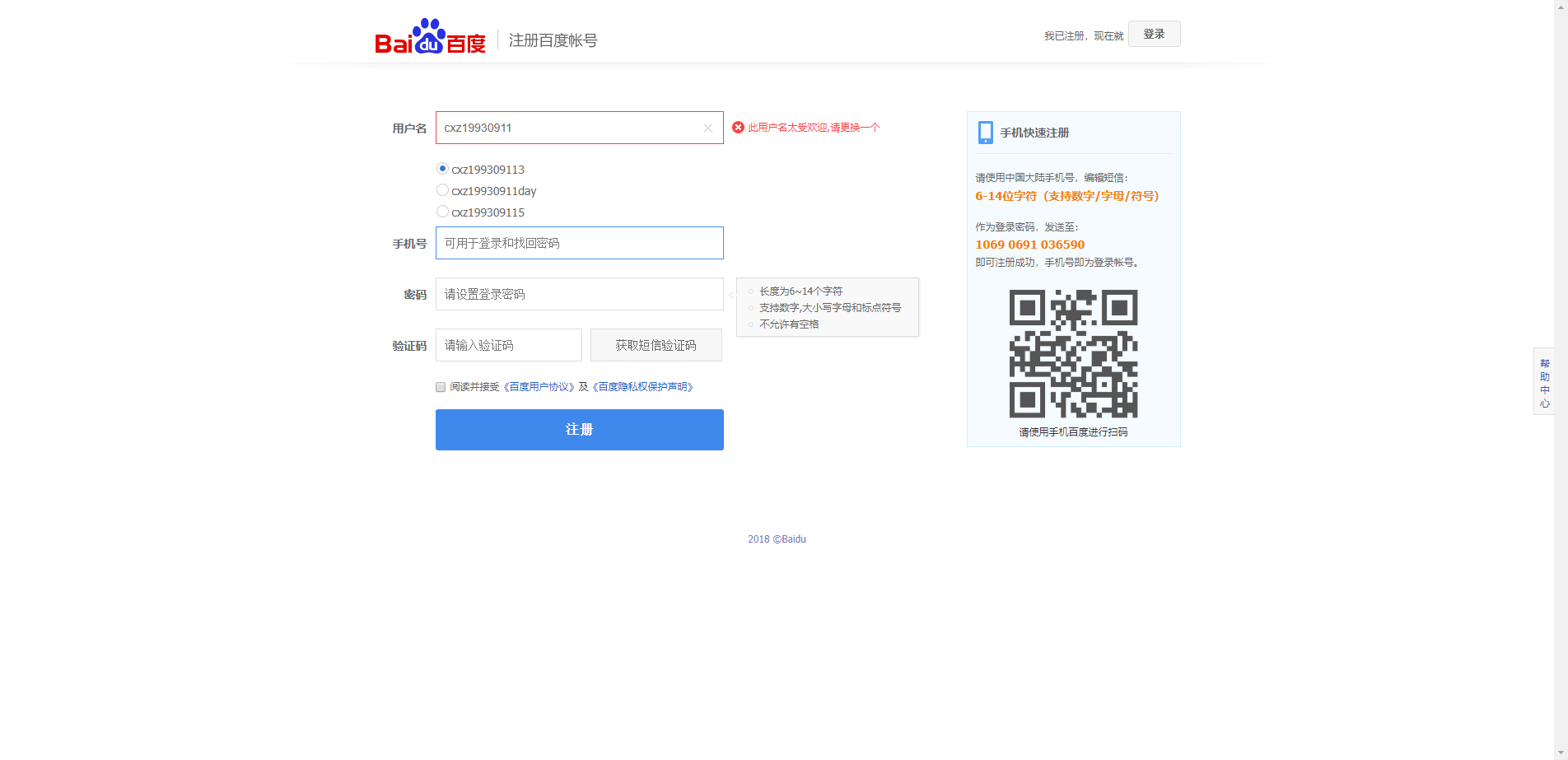
3、Ajax的优点;
-
AJAX使用Javascript技术向服务器发送异步请求;
-
Ajax无须刷新整个页面;
89-Ajax的简单实现
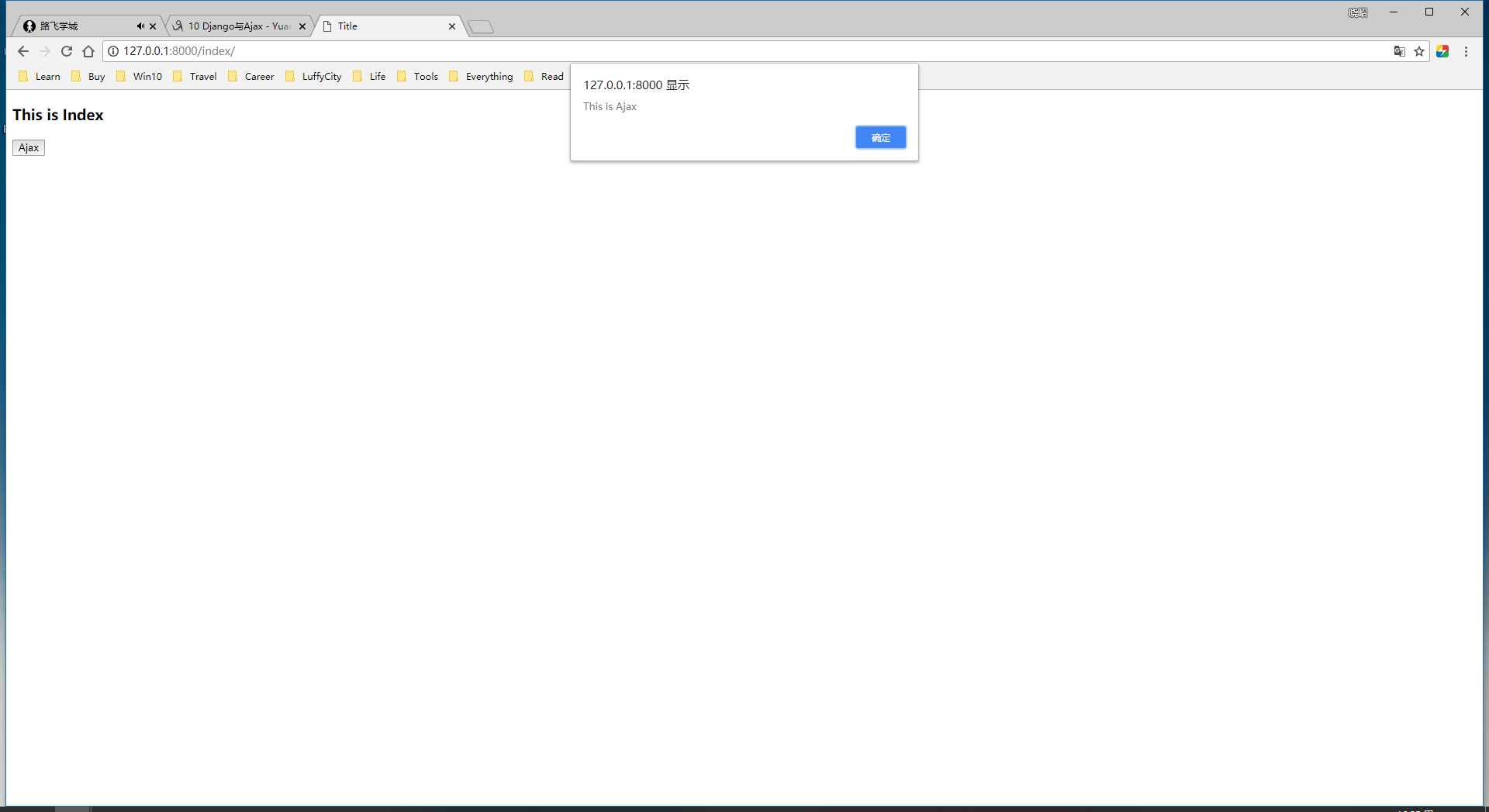
1、创建Django项目-AjaxDemo;
2、配置urls.py;
"""AjaxDemo URL Configuration The `urlpatterns` list routes URLs to views. For more information please see: https://docs.djangoproject.com/en/2.1/topics/http/urls/ Examples: Function views 1. Add an import: from my_app import views 2. Add a URL to urlpatterns: path('', views.home, name='home') Class-based views 1. Add an import: from other_app.views import Home 2. Add a URL to urlpatterns: path('', Home.as_view(), name='home') Including another URLconf 1. Import the include() function: from django.urls import include, path 2. Add a URL to urlpatterns: path('blog/', include('blog.urls')) """ from django.contrib import admin from django.urls import path from app01 import views urlpatterns = [ path('admin/', admin.site.urls), path('index/', views.index), path('test_ajax/', views.test_ajax), ]
3、编写视图函数views.py;
from django.shortcuts import render,HttpResponse # Create your views here. def index(request): return render(request,"index.html") def test_ajax(request): return HttpResponse("Hello cuixiaozhao!")
4、编写templates下的index.html文件;
<!DOCTYPE html> <html lang="en"> <head> <meta charset="UTF-8"> <title>Title</title> <script src="https://cdn.bootcss.com/jquery/3.3.1/jquery.js"></script> <style type="text/css"> </style> </head> <body> <h3>This is Index</h3> <button class="Ajax">Ajax</button> <p class="content"></p> </body> <script> $(".Ajax").click(function () { //alert("This is Ajax") //发送Ajax请求; $.ajax({ url:"/test_ajax/",//请求的URL; type:"get",//请求方式post; success:function (data) {//回调函数,某个事件执行完之后,再去执行的函数; console.log(data); $(".content").html(data) } }) }) </script> </html>
5、引入CDN类型的jQuery文件;
<script src="https://cdn.bootcss.com/jquery/3.3.1/jquery.js"></script>
各版本的jQuery的CDN地址;https://www.bootcdn.cn/jquery/
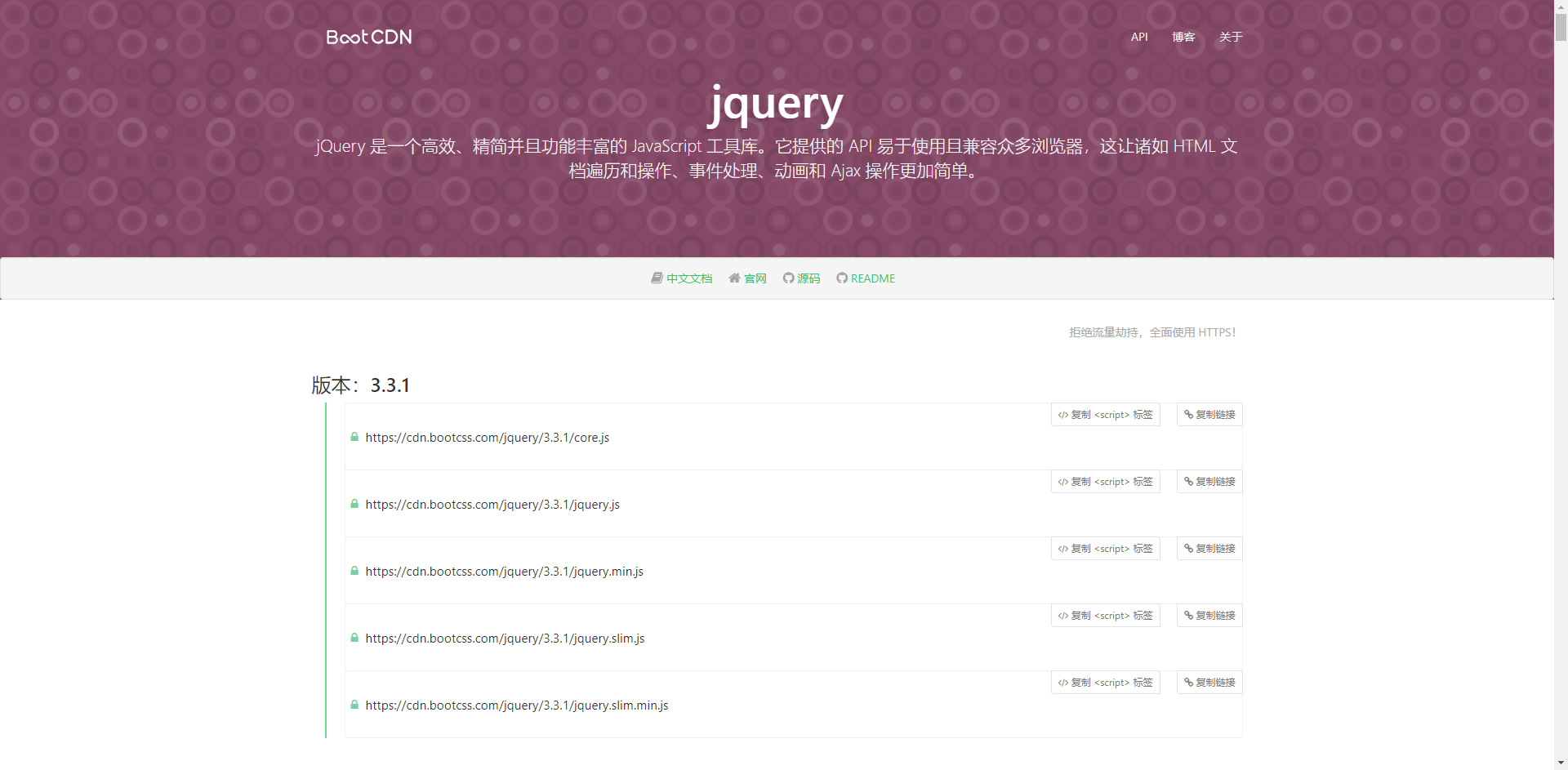
6、编写Ajax请求的js;
<script> $(".Ajax").click(function () { //alert("This is Ajax") //发送Ajax请求; $.ajax({ url:"/test_ajax/",//请求的URL; type:"get",//请求方式post; success:function (data) {//回调函数,某个事件执行完之后,再去执行的函数; console.log(data); $(".content").html(data) } }) }) </script>
7、进行验证;
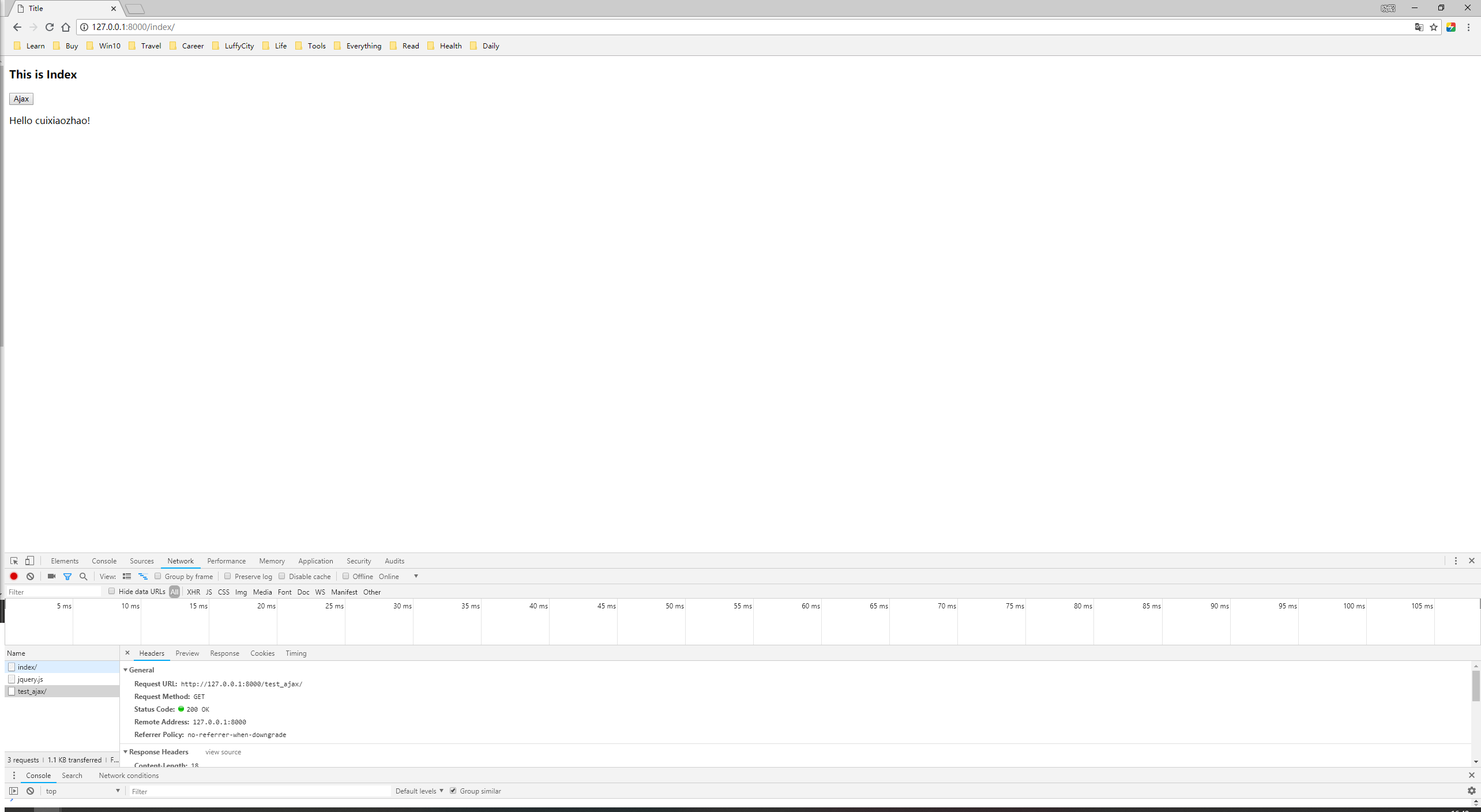
90-基于Ajax的传递数据
1、基于Ajax的传递数据;
2、将settings.py中的 'django.middleware.csrf.CsrfViewMiddleware',先注释掉;
urls.py;
"""AjaxDemo URL Configuration The `urlpatterns` list routes URLs to views. For more information please see: https://docs.djangoproject.com/en/2.1/topics/http/urls/ Examples: Function views 1. Add an import: from my_app import views 2. Add a URL to urlpatterns: path('', views.home, name='home') Class-based views 1. Add an import: from other_app.views import Home 2. Add a URL to urlpatterns: path('', Home.as_view(), name='home') Including another URLconf 1. Import the include() function: from django.urls import include, path 2. Add a URL to urlpatterns: path('blog/', include('blog.urls')) """ from django.contrib import admin from django.urls import path from app01 import views urlpatterns = [ path('admin/', admin.site.urls), path('index/', views.index), path('test_ajax/', views.test_ajax), path('cal/', views.cal), ]
views.py;
from django.shortcuts import render,HttpResponse # Create your views here. def index(request): print(request.GET) return render(request,"index.html") def test_ajax(request): return HttpResponse("Hello cuixiaozhao!") def cal(request): print(request.POST) n1 = int(request.POST.get("n1")) n2 = int(request.POST.get("n2")) ret = n1 + n2 return HttpResponse(ret)
index.html;
<!DOCTYPE html> <html lang="en"> <head> <meta charset="UTF-8"> <title>Title</title> <script src="https://cdn.bootcss.com/jquery/3.3.1/jquery.js"></script> <style type="text/css"> </style> </head> <body> <h3>This is Index</h3> <button class="Ajax">Ajax</button> <p class="content"></p> <hr> <input type="text" id="num1">+<input type="text" id="num2">=<input id="ret" type="text" ><button class="cal">计算</button> </body> <script> $(".Ajax").click(function () { //alert("This is Ajax") //发送Ajax请求; $.ajax({ url:"/test_ajax/",//请求的URL; type:"get",//请求方式post; data:{age:26,sex:2}, success:function (data) {//回调函数,某个事件执行完之后,再去执行的函数; console.log(data); $(".content").html(data) } }) }) //Ajax计算求值; $(".cal").click(function () { $.ajax({ url:"/cal/", type:"post", data:{ "n1":$("#num1").val(), "n2":$("#num2").val(), }, success:function (data) { console.log(data); $("#ret").val(data); } }) }) </script> </html>
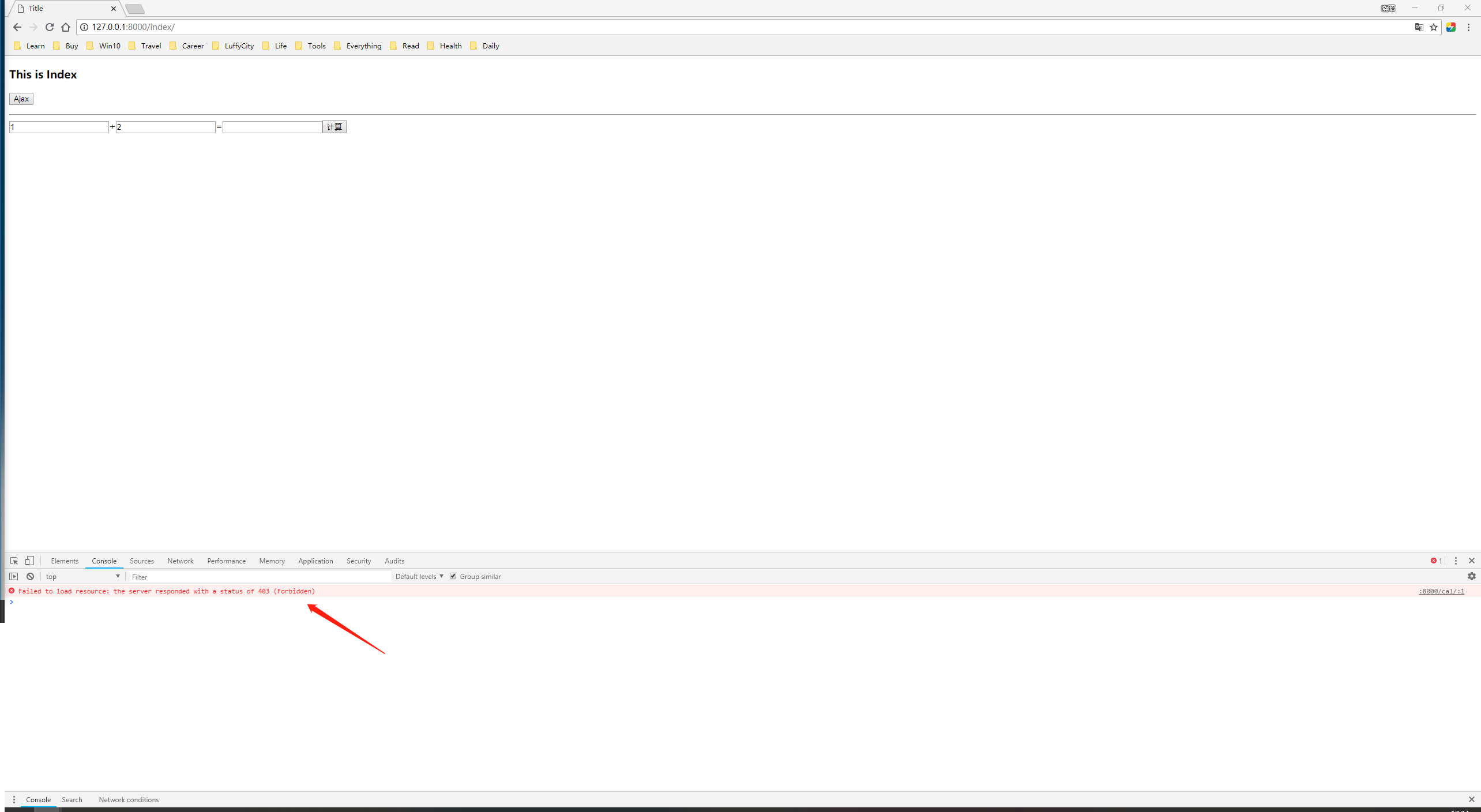

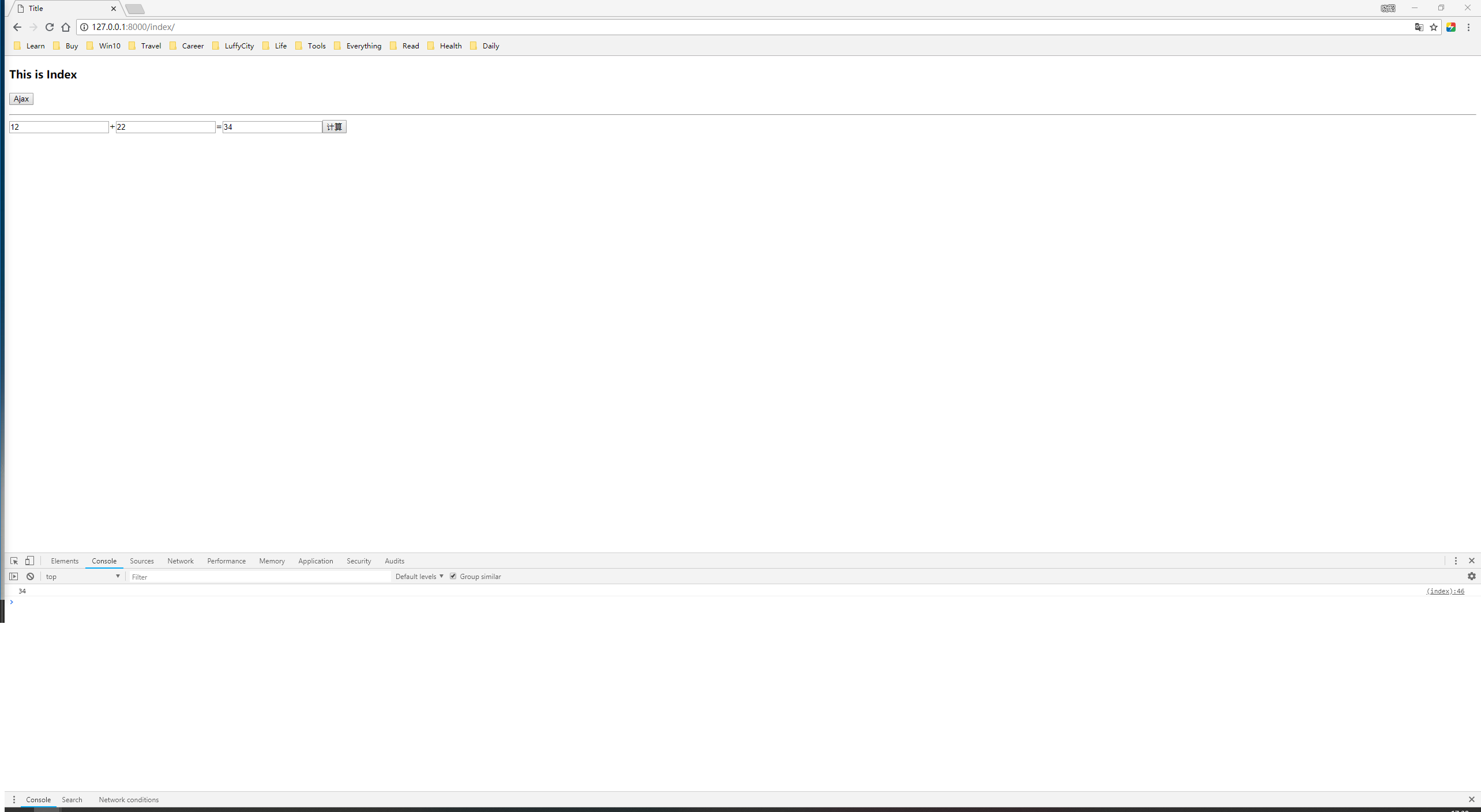
操作日志:
Performing system checks... System check identified no issues (0 silenced). You have 15 unapplied migration(s). Your project may not work properly until you apply the migrations for app(s): admin, auth, contenttypes, sessions. Run 'python manage.py migrate' to apply them. August 20, 2018 - 16:51:22 Django version 2.1, using settings 'AjaxDemo.settings' Starting development server at http://127.0.0.1:8000/ Quit the server with CTRL-BREAK. <QueryDict: {}> [20/Aug/2018 16:51:45] "GET /index/ HTTP/1.1" 200 798 [20/Aug/2018 16:51:46] "GET /test_ajax/?age=26&sex=2 HTTP/1.1" 200 18
91-基于Ajax的登录验证
1、基于Ajax的登录验证;
2、views.py;
from django.shortcuts import render,HttpResponse # Create your views here. from app01.models import User def index(request): print(request.GET) return render(request,"index.html") def test_ajax(request): return HttpResponse("Hello cuixiaozhao!") def cal(request): print(request.POST) n1 = int(request.POST.get("n1")) n2 = int(request.POST.get("n2")) ret = n1 + n2 return HttpResponse(ret) def login(request): # print(request.POST) user = request.POST.get("user") pwd = request.POST.get("pwd") user = User.objects.filter(name=user,pwd=pwd).first() res = {"User":None,"msg":None} if user: res["user"] = user.name else: res["msg"] = "Username or Password is Wrong!" import json #引入json的目的,是因为http协议传输过程中,必须使用字符串;如此引入了"序列化"以及"反序列化"的概念; return HttpResponse(json.dumps(res))
3、urls.py;
"""AjaxDemo URL Configuration The `urlpatterns` list routes URLs to views. For more information please see: https://docs.djangoproject.com/en/2.1/topics/http/urls/ Examples: Function views 1. Add an import: from my_app import views 2. Add a URL to urlpatterns: path('', views.home, name='home') Class-based views 1. Add an import: from other_app.views import Home 2. Add a URL to urlpatterns: path('', Home.as_view(), name='home') Including another URLconf 1. Import the include() function: from django.urls import include, path 2. Add a URL to urlpatterns: path('blog/', include('blog.urls')) """ from django.contrib import admin from django.urls import path from app01 import views urlpatterns = [ path('admin/', admin.site.urls), path('index/', views.index), path('test_ajax/', views.test_ajax), path('cal/', views.cal), path('login/', views.login), ]
4、index.html;
<!DOCTYPE html> <html lang="en"> <head> <meta charset="UTF-8"> <title>Title</title> <script src="https://cdn.bootcss.com/jquery/3.3.1/jquery.js"></script> <style type="text/css"> </style> </head> <body> <h3>This is Index</h3> <button class="Ajax">Ajax</button> <p class="content"></p> <hr> <br> <br> <br> <br> <br> <input type="text" id="num1">+<input type="text" id="num2">=<input id="ret" type="text" ><button class="cal">计算</button> <hr> <br> <br> <br> <br> <br> <from action=""> 用户名:<input type="text" id="user"> 密码:<input type="password" id="pwd"> <input type="button" value="submit" class="login_btn"><span class="error"></span> </from> <script> $(".Ajax").click(function () { //alert("This is Ajax") //发送Ajax请求; $.ajax({ url:"/test_ajax/",//请求的URL; type:"get",//请求方式post; data:{age:26,sex:2}, success:function (data) {//回调函数,某个事件执行完之后,再去执行的函数; console.log(data); $(".content").html(data) } }) }) //Ajax计算求值; $(".cal").click(function () { $.ajax({ url:"/cal/", type:"post", data:{ "n1":$("#num1").val(), "n2":$("#num2").val(), }, success:function (data) { console.log(data); $("#ret").val(data); } }) }) //Ajax的登录验证; $(".login_btn").click(function () { $.ajax({ url:"/login/", type:"post", data:{ "user":$("#user").val(), "pwd":$("#pwd").val(), }, success:function (data) { console.log(data);//json字符串; console.log(typeof data); var data = JSON.parse(data)//反序列化,object{} console.log(data);//json字符串; console.log(typeof data); if (data.user){ location.href = "http://www.cnblogs.com/tqtl991/" }else { $(".error").html(data.msg).css({"color":"red","margin-left":"10px"}) } } }) }) </script> </body> </html>
92-基于Form表单的文件上传
1、urls.py;
"""AjaxDemo URL Configuration The `urlpatterns` list routes URLs to views. For more information please see: https://docs.djangoproject.com/en/2.1/topics/http/urls/ Examples: Function views 1. Add an import: from my_app import views 2. Add a URL to urlpatterns: path('', views.home, name='home') Class-based views 1. Add an import: from other_app.views import Home 2. Add a URL to urlpatterns: path('', Home.as_view(), name='home') Including another URLconf 1. Import the include() function: from django.urls import include, path 2. Add a URL to urlpatterns: path('blog/', include('blog.urls')) """ from django.contrib import admin from django.urls import path from app01 import views urlpatterns = [ path('admin/', admin.site.urls), path('index/', views.index), path('test_ajax/', views.test_ajax), path('cal/', views.cal), path('login/', views.login), path('file_put/', views.file_put), ]
2、views.py;
from django.shortcuts import render,HttpResponse # Create your views here. from app01.models import User def index(request): print(request.GET) return render(request,"index.html") def test_ajax(request): return HttpResponse("Hello cuixiaozhao!") def cal(request): print(request.POST) n1 = int(request.POST.get("n1")) n2 = int(request.POST.get("n2")) ret = n1 + n2 return HttpResponse(ret) def login(request): # print(request.POST) user = request.POST.get("user") pwd = request.POST.get("pwd") user = User.objects.filter(name=user,pwd=pwd).first() res = {"User":None,"msg":None} if user: res["user"] = user.name else: res["msg"] = "Username or Password is Wrong!" import json #引入json的目的,是因为http协议传输过程中,必须使用字符串;如此引入了"序列化"以及"反序列化"的概念; return HttpResponse(json.dumps(res)) def file_put(request): if request.method == "POST": print(request.POST) print(request.FILES) file_obj = request.FILES.get("avatar") with open(file_obj.name,"wb") as f: for line in file_obj: f.write(line) return HttpResponse("OK") return render(request,"file_put.html")
3、file_put.html;
<!DOCTYPE html> <html lang="en"> <head> <meta charset="UTF-8"> <title>Title</title> <style type="text/css"> </style> </head> <body> <h3>基于Form表单的文件上传</h3> <form action="" method="post" enctype="multipart/form-data"> 用户名:<input type="text" name="user"> 头像:<input type="file" name="avatar"> <input type="submit"> </form> </body> </html>
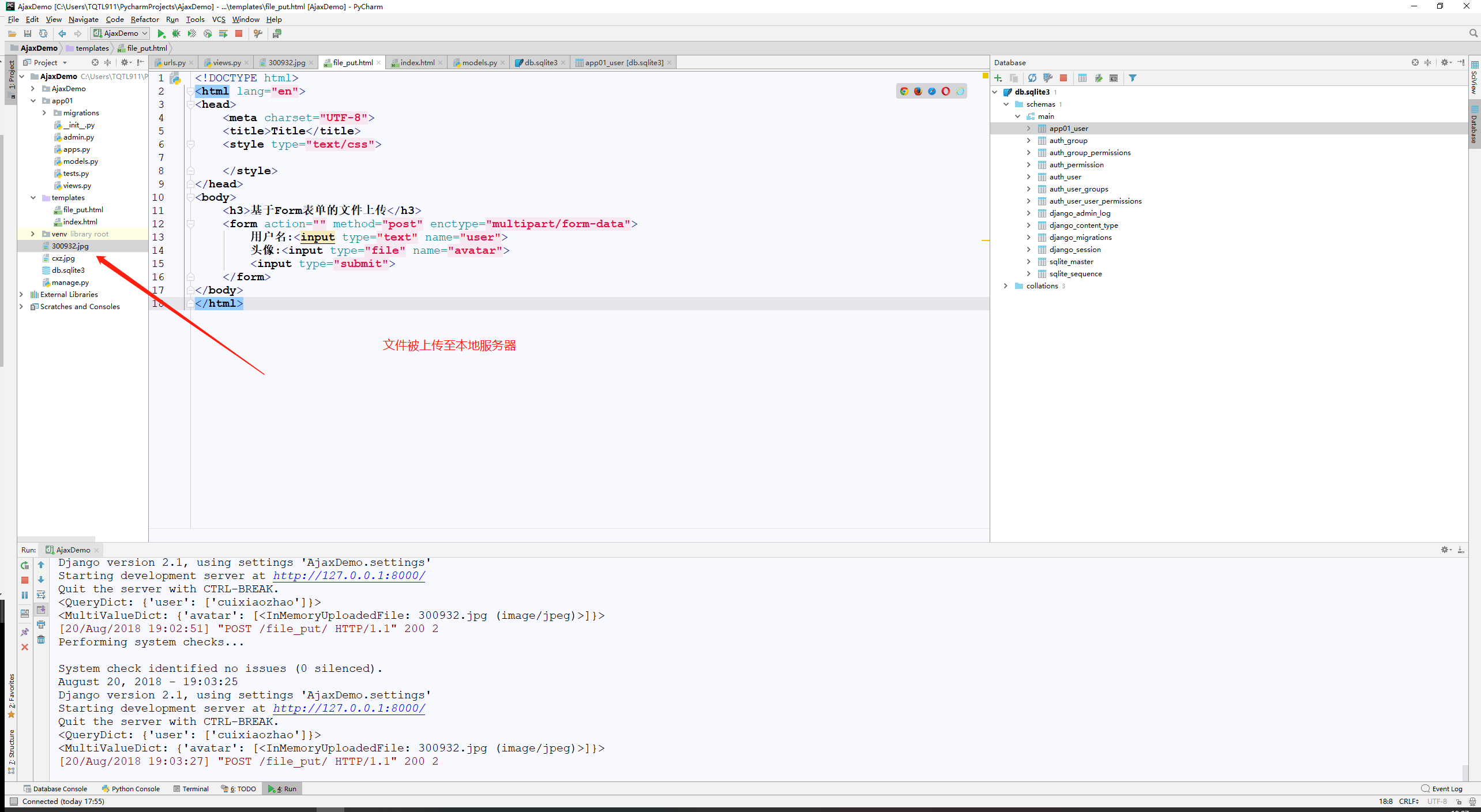
4、注意打开文件的方式;
def file_put(request): if request.method == "POST": print(request.POST) print(request.FILES)#先获取了文件这个对象; file_obj = request.FILES.get("avatar") with open(file_obj.name,"wb") as f:#通过file_obj.name拿到原有本文的文件名,而不是自己指定。记得以“wb”的模式打开; for line in file_obj: f.write(line) return HttpResponse("OK") return render(request,"file_put.html")
93-请求头之contentType
1、请求头之ContentType;

2、file_put.html;
<!DOCTYPE html> <html lang="en"> <head> <meta charset="UTF-8"> <title>Title</title> <script src="https://cdn.bootcss.com/jquery/3.3.1/jquery.js"></script> <style type="text/css"> </style> </head> <body> <h3>简单的form</h3> <form action="" method="post" enctype="application/x-www-form-urlencoded"> 用户名:<input type="text" name="user"> 密码:<input type="password" name="pwd"> <input type="submit"> </form> <hr> <h3>基于Form表单的文件上传</h3> <form action="" method="post" enctype="multipart/form-data"> 用户名:<input type="text" name="user"> 头像:<input type="file" name="avatar"> <input type="submit"> </form> <h3>基于Ajax文件上传</h3> <form action="" method="post"> 用户名:<input type="text" name="user"> <input type="button" class="btn" value="Ajax"> </form> <script> $(".btn").click(function () { $.ajax({ url:"", type:"post", data:{ a:1, b:2, }, success:function (data) { console.log(data) } }) }) </script> </body> </html>
views.py;
from django.shortcuts import render,HttpResponse # Create your views here. from app01.models import User def index(request): print(request.GET) return render(request,"index.html") def test_ajax(request): return HttpResponse("Hello cuixiaozhao!") def cal(request): print(request.POST) n1 = int(request.POST.get("n1")) n2 = int(request.POST.get("n2")) ret = n1 + n2 return HttpResponse(ret) def login(request): # print(request.POST) user = request.POST.get("user") pwd = request.POST.get("pwd") user = User.objects.filter(name=user,pwd=pwd).first() res = {"User":None,"msg":None} if user: res["user"] = user.name else: res["msg"] = "Username or Password is Wrong!" import json #引入json的目的,是因为http协议传输过程中,必须使用字符串;如此引入了"序列化"以及"反序列化"的概念; return HttpResponse(json.dumps(res)) def file_put(request): if request.method == "POST": print(request.POST) print(request.FILES) # file_obj = request.FILES.get("avatar") # with open(file_obj.name,"wb") as f: # for line in file_obj: # f.write(line) return HttpResponse("OK") return render(request,"file_put.html") """ 请求首行: 请求头: 请求头: 请求头: ........ 请求头:ContentType:urlencode 请求体(a=1&b=2&c=3): """
94-Ajax传递json数据
1、Ajax传递json数据;
views.py;
from django.shortcuts import render,HttpResponse # Create your views here. from app01.models import User def index(request): print(request.GET) return render(request,"index.html") def test_ajax(request): return HttpResponse("Hello cuixiaozhao!") def cal(request): print(request.POST) n1 = int(request.POST.get("n1")) n2 = int(request.POST.get("n2")) ret = n1 + n2 return HttpResponse(ret) def login(request): # print(request.POST) user = request.POST.get("user") pwd = request.POST.get("pwd") user = User.objects.filter(name=user,pwd=pwd).first() res = {"User":None,"msg":None} if user: res["user"] = user.name else: res["msg"] = "Username or Password is Wrong!" import json #引入json的目的,是因为http协议传输过程中,必须使用字符串;如此引入了"序列化"以及"反序列化"的概念; return HttpResponse(json.dumps(res)) def file_put(request): if request.method == "POST": print("body",request.body)#请求报文中的请求体! print("POST",request.POST) print(request.FILES) # file_obj = request.FILES.get("avatar") # with open(file_obj.name,"wb") as f: # for line in file_obj: # f.write(line) return HttpResponse("OK") return render(request,"file_put.html") """ 请求首行: 请求头: 请求头: 请求头: ........ 请求头:ContentType:json#urlencode 请求体{"a":1,"b":2}:#a=1&b=2&c=3 """
file_put.html;
<!DOCTYPE html> <html lang="en"> <head> <meta charset="UTF-8"> <title>Title</title> <script src="https://cdn.bootcss.com/jquery/3.3.1/jquery.js"></script> <style type="text/css"> </style> </head> <body> <h3>简单的form</h3> <form action="" method="post" enctype="application/x-www-form-urlencoded"> 用户名:<input type="text" name="user"> 密码:<input type="password" name="pwd"> <input type="submit"> </form> <hr> <h3>基于Form表单的文件上传</h3> <form action="" method="post" enctype="multipart/form-data"> 用户名:<input type="text" name="user"> 头像:<input type="file" name="avatar"> <input type="submit"> </form> <h3>基于Ajax文件上传</h3> <form action="" method="post"> 用户名:<input type="text" name="user"> <input type="button" class="btn" value="Ajax"> </form> <script> $(".btn").click(function () { $.ajax({ url:"", type:"post", contentType:"application/json", data:JSON.stringify({ a:1, b:2, }), success:function (data) { console.log(data) } }) }) </script> </body> </html>
操作日志:
"D:\Program\PyCharm 2018.1.4\bin\runnerw.exe" C:\Users\TQTL911\PycharmProjects\AjaxDemo\venv\Scripts\python.exe C:/Users/TQTL911/PycharmProjects/AjaxDemo/manage.py runserver 8000 Performing system checks... System check identified no issues (0 silenced). August 21, 2018 - 09:37:03 Django version 2.1, using settings 'AjaxDemo.settings' Starting development server at http://127.0.0.1:8000/ Quit the server with CTRL-BREAK. <QueryDict: {}> [21/Aug/2018 09:37:05] "GET /index/ HTTP/1.1" 200 2383 Not Found: /favicon.ico [21/Aug/2018 09:37:05] "GET /favicon.ico HTTP/1.1" 404 2509 [21/Aug/2018 09:37:07] "POST /login/ HTTP/1.1" 200 55 [21/Aug/2018 09:37:26] "GET /file_put/ HTTP/1.1" 200 1227 [21/Aug/2018 09:37:30] "POST /file_put/ HTTP/1.1" 200 2 b'{"a":1,"b":2}' <QueryDict: {}> <MultiValueDict: {}> [21/Aug/2018 09:37:56] "GET /file_put/ HTTP/1.1" 200 1227 b'{"a":1,"b":2}' [21/Aug/2018 09:38:28] "POST /file_put/ HTTP/1.1" 200 2 <QueryDict: {}> <MultiValueDict: {}> Performing system checks... System check identified no issues (0 silenced). August 21, 2018 - 09:40:11 Django version 2.1, using settings 'AjaxDemo.settings' Starting development server at http://127.0.0.1:8000/ Quit the server with CTRL-BREAK.
95-基于Ajax的文件上传
1、基于Ajax的文件上传;
views.py;
from django.shortcuts import render,HttpResponse # Create your views here. from app01.models import User def index(request): print(request.GET) return render(request,"index.html") def test_ajax(request): return HttpResponse("Hello cuixiaozhao!") def cal(request): print(request.POST) n1 = int(request.POST.get("n1")) n2 = int(request.POST.get("n2")) ret = n1 + n2 return HttpResponse(ret) def login(request): # print(request.POST) user = request.POST.get("user") pwd = request.POST.get("pwd") user = User.objects.filter(name=user,pwd=pwd).first() res = {"User":None,"msg":None} if user: res["user"] = user.name else: res["msg"] = "Username or Password is Wrong!" import json #引入json的目的,是因为http协议传输过程中,必须使用字符串;如此引入了"序列化"以及"反序列化"的概念; return HttpResponse(json.dumps(res)) def file_put(request): if request.method == "POST": print("body",request.body)#请求报文中的请求体! print("POST",request.POST) print(request.FILES) # file_obj = request.FILES.get("avatar") # with open(file_obj.name,"wb") as f: # for line in file_obj: # f.write(line) return HttpResponse("OK") return render(request,"file_put.html") """ 请求首行: 请求头: 请求头: 请求头: ........ 请求头:ContentType:json#urlencode 请求体{"a":1,"b":2}:#a=1&b=2&c=3 """
file_put.py;
<!DOCTYPE html> <html lang="en"> <head> <meta charset="UTF-8"> <title>Title</title> <script src="https://cdn.bootcss.com/jquery/3.3.1/jquery.js"></script> <style type="text/css"> </style> </head> <body> <h3>简单的form</h3> <form action="" method="post" enctype="application/x-www-form-urlencoded"> 用户名:<input type="text" name="user"> 密码:<input type="password" name="pwd"> <input type="submit"> </form> <hr> <h3>基于Form表单的文件上传</h3> <form action="" method="post" enctype="multipart/form-data"> 用户名:<input type="text" name="user"> 头像:<input type="file" name="avatar"> <input type="submit"> </form> <hr> <br> <br> <br> <!-- <h3>Ajax传递json数据</h3> <form action="" method="post"> 用户名:<input type="text" name="user"> <input type="button" class="btn" value="Ajax"> </form> --> <hr> <br> <br> <br> <h2>基于Ajax的文件上传</h2> <form action="" method="post"> 用户名:<input type="text" id="user"> 头像:<input type="text" id="avatar"> <input type="file" class="btn" value="Ajax"> <input type="button" class="btn" value="Ajax"> </form> <script> //Ajax传递json数据; /* $(".btn").click(function () { $.ajax({ url:"", type:"post", contentType:"application/json", data:JSON.stringify({ a:1, b:2, }), success:function (data) { console.log(data) } }) }) */ //基于Ajax上传文件; $(".btn").click(function () { var formdata = new FormData(); formdata.append("user",$("#user").val()); formdata.append("avatar",$("#avatar")[0].files[0]); $.ajax({ url:"", type:"post", ContentType:false, processData:false, data:formdata, success:function (data) { console.log(data) } }) }) </script> </body> </html>
96-分页器1
1、Django中的分页器初识;
Django 提供了几个类, 可以帮助我们管理分页数据 - 也就是说,通过 "上一个 / 下一个" 链接分割多个页面的数据, 这些类放在 `django/core/ paginator.py`中。
2、创建PageDemo的Django项目并配置应用app01;
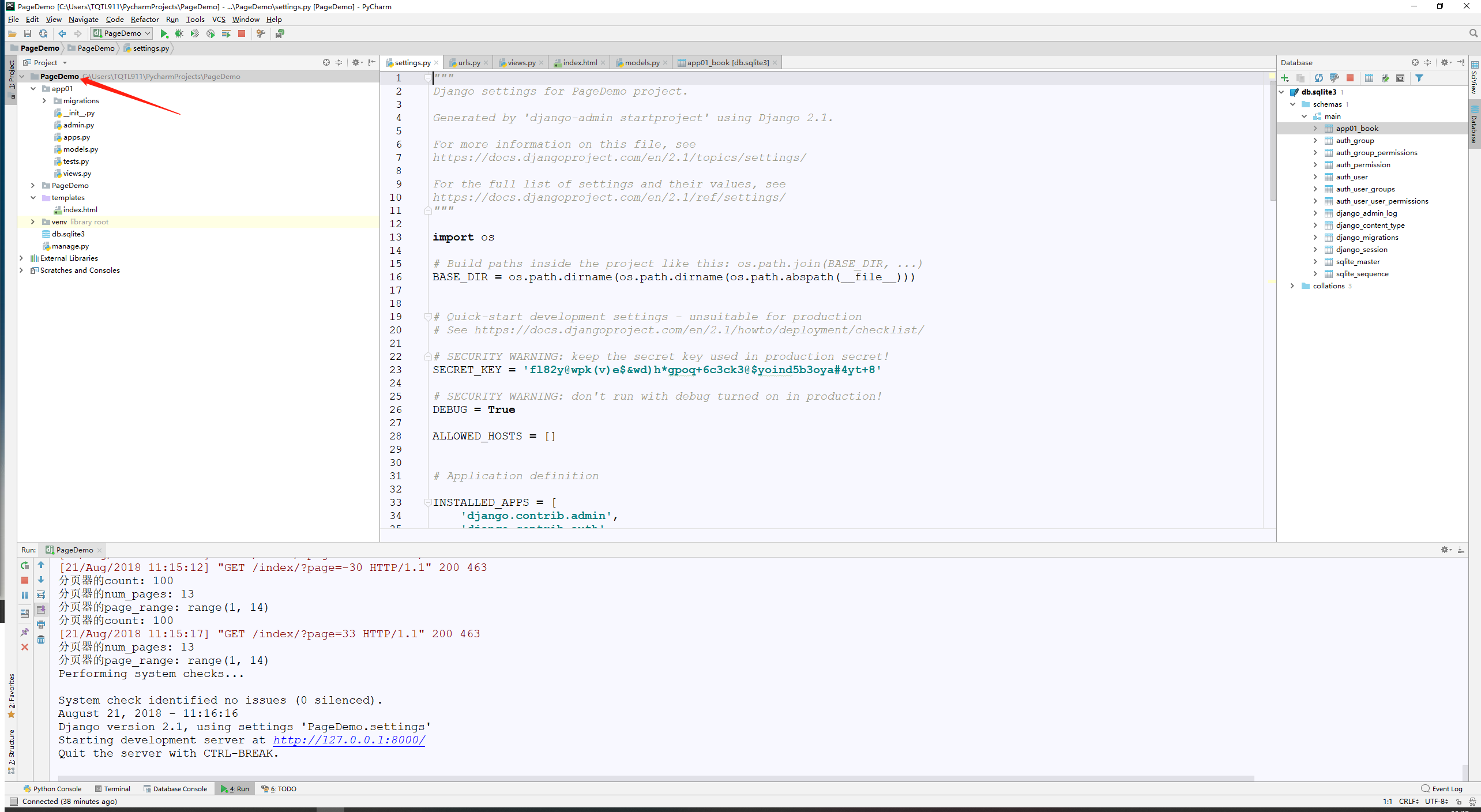
3、配置urls.py;
"""PageDemo URL Configuration The `urlpatterns` list routes URLs to views. For more information please see: https://docs.djangoproject.com/en/2.1/topics/http/urls/ Examples: Function views 1. Add an import: from my_app import views 2. Add a URL to urlpatterns: path('', views.home, name='home') Class-based views 1. Add an import: from other_app.views import Home 2. Add a URL to urlpatterns: path('', Home.as_view(), name='home') Including another URLconf 1. Import the include() function: from django.urls import include, path 2. Add a URL to urlpatterns: path('blog/', include('blog.urls')) """ from django.contrib import admin from django.urls import path from app01 import views urlpatterns = [ path('admin/', admin.site.urls), path('index/', views.index), ]
4、编写视图函数views.py;
- for循环导入数据(不建议);
- 通过bulk_create()方法一次性批量插入数据;
- 通过django.core.paginator导入Paginator,EmptyPage模块;
- Paginator下的count()方法;
- Paginator下的num_pages()方法;
- Paginator下的page_range()方法;
- try except 异常捕获的引入;
5、templates下新增index.html文件;
<!DOCTYPE html> <html lang="en"> <head> <meta charset="UTF-8"> <title>Title</title> <style type="text/css"> </style> </head> <body> <ul> {% for book in current_page %} <li>{{ book.title }}:{{ book.price }}</li> {% endfor %} </ul> </body> </html>
6、创建models.py文件;
from django.db import models # Create your models here. class Book(models.Model): title = models.CharField(max_length=32) price = models.DecimalField(decimal_places=2,max_digits=8)
7、执行数据库迁移操作;
python manage.py makemigrations
python manage.py migrate
Microsoft Windows [版本 10.0.17134.1] (c) 2018 Microsoft Corporation。保留所有权利。 (venv) C:\Users\TQTL911\PycharmProjects\PageDemo>python manage.py makemigrations Migrations for 'app01': app01\migrations\0001_initial.py - Create model Book (venv) C:\Users\TQTL911\PycharmProjects\PageDemo>python manage.py migrate Operations to perform: Apply all migrations: admin, app01, auth, contenttypes, sessions Running migrations: Applying contenttypes.0001_initial... OK Applying auth.0001_initial... OK Applying admin.0001_initial... OK Applying admin.0002_logentry_remove_auto_add... OK Applying admin.0003_logentry_add_action_flag_choices... OK Applying app01.0001_initial... OK Applying contenttypes.0002_remove_content_type_name... OK Applying auth.0002_alter_permission_name_max_length... OK Applying auth.0003_alter_user_email_max_length... OK Applying auth.0004_alter_user_username_opts... OK Applying auth.0005_alter_user_last_login_null... OK Applying auth.0006_require_contenttypes_0002... OK Applying auth.0007_alter_validators_add_error_messages... OK Applying auth.0008_alter_user_username_max_length... OK Applying auth.0009_alter_user_last_name_max_length... OK Applying sessions.0001_initial... OK (venv) C:\Users\TQTL911\PycharmProjects\PageDemo>^A
8、进行项目启动;
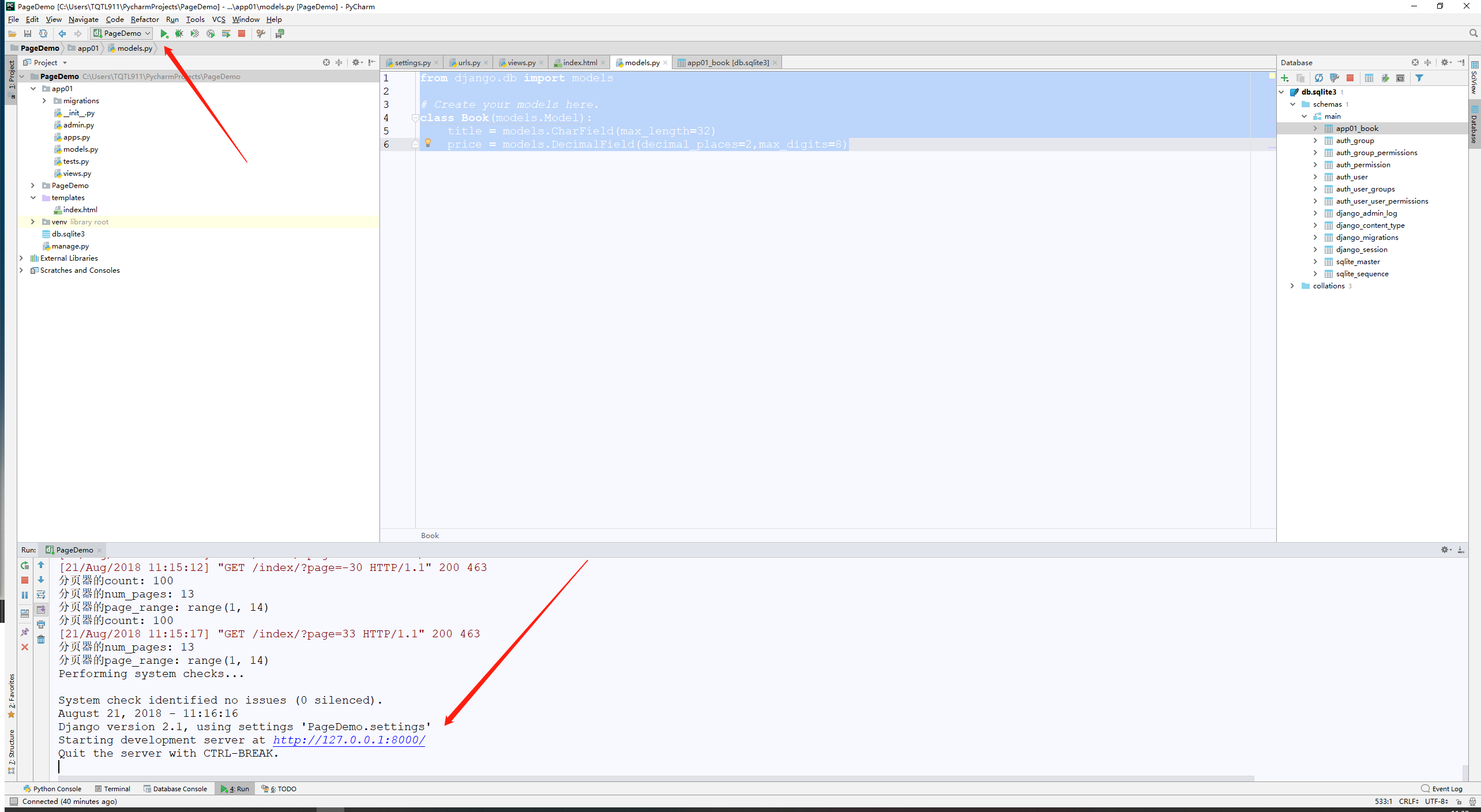
9、访问index.html页面;
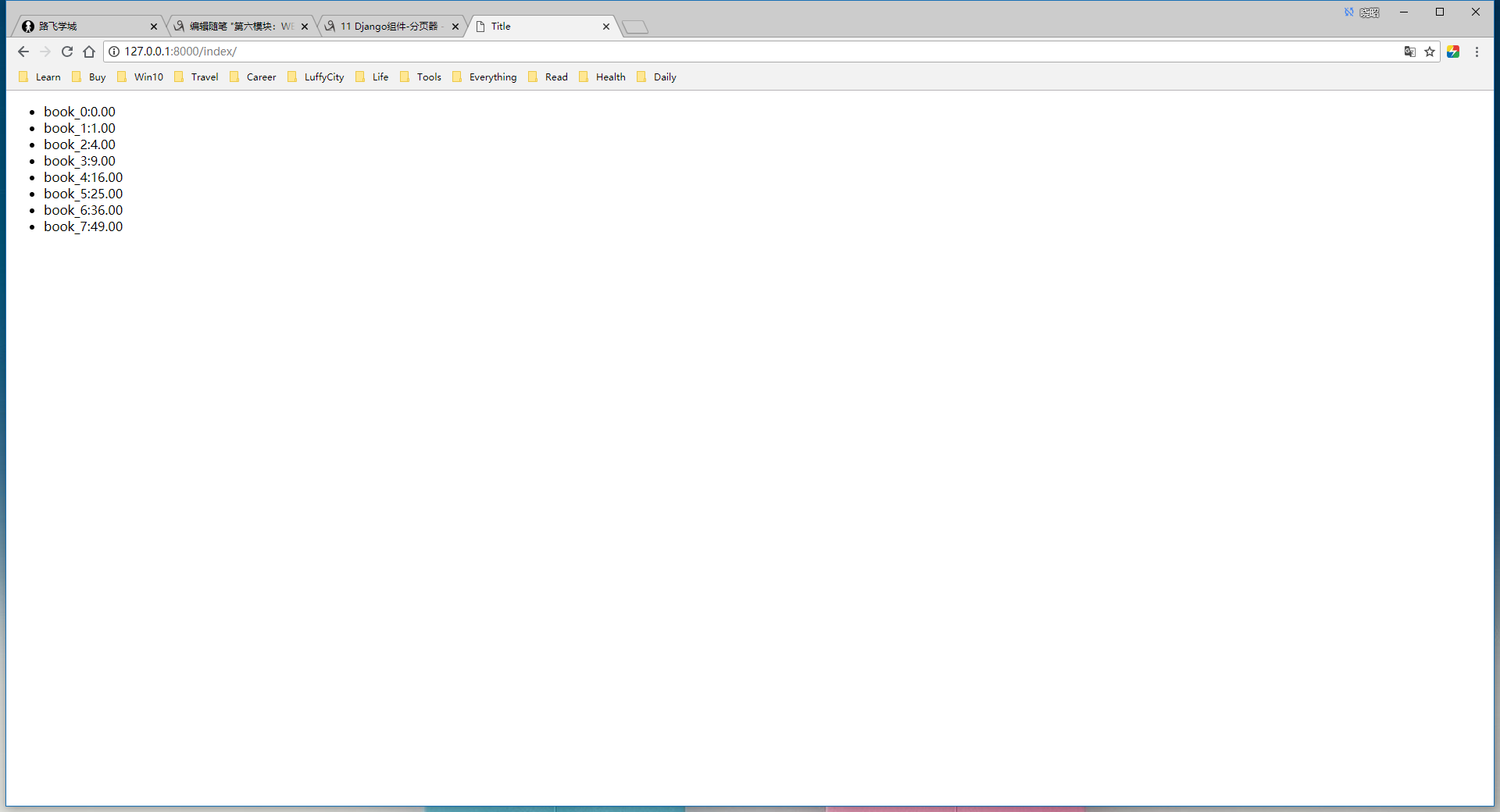
10、链接sqllite数据库并查看数据;
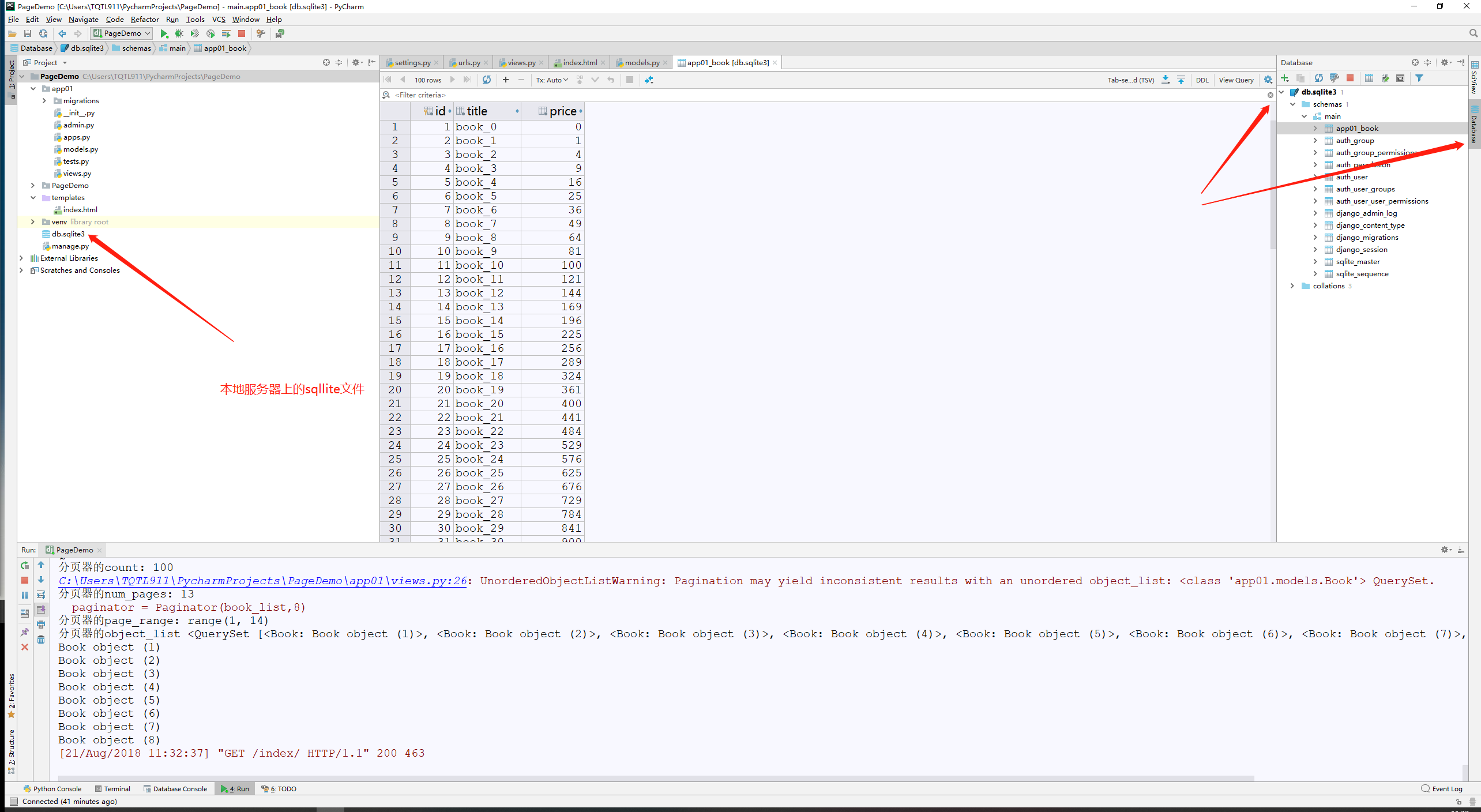
操作日志;
System check identified no issues (0 silenced). August 21, 2018 - 11:16:16 Django version 2.1, using settings 'PageDemo.settings' Starting development server at http://127.0.0.1:8000/ Quit the server with CTRL-BREAK. 分页器的count: 100 C:\Users\TQTL911\PycharmProjects\PageDemo\app01\views.py:26: UnorderedObjectListWarning: Pagination may yield inconsistent results with an unordered object_list: <class 'app01.models.Book'> QuerySet. 分页器的num_pages: 13 paginator = Paginator(book_list,8) 分页器的page_range: range(1, 14) 分页器的object_list <QuerySet [<Book: Book object (1)>, <Book: Book object (2)>, <Book: Book object (3)>, <Book: Book object (4)>, <Book: Book object (5)>, <Book: Book object (6)>, <Book: Book object (7)>, <Book: Book object (8)>]> Book object (1) Book object (2) Book object (3) Book object (4) Book object (5) Book object (6) Book object (7) Book object (8) [21/Aug/2018 11:32:37] "GET /index/ HTTP/1.1" 200 463
97-分页器2
1、分页器实现显示页码;
2、引入CDN类型的Bootstrap;
使用 BootCDN 提供的免费 CDN 加速服务(同时支持 http 和 https 协议)
Bootstrap 中文网 为 Bootstrap 专门构建了免费的 CDN 加速服务,访问速度更快、加速效果更明显、没有速度和带宽限制、永久免费。BootCDN 还对大量的前端开源工具库提供了 CDN 加速服务,请进入BootCDN 主页查看更多可用的工具库。
<!-- 最新版本的 Bootstrap 核心 CSS 文件 --> <link rel="stylesheet" href="https://cdn.bootcss.com/bootstrap/3.3.7/css/bootstrap.min.css" integrity="sha384-BVYiiSIFeK1dGmJRAkycuHAHRg32OmUcww7on3RYdg4Va+PmSTsz/K68vbdEjh4u" crossorigin="anonymous"> <!-- 可选的 Bootstrap 主题文件(一般不用引入) --> <link rel="stylesheet" href="https://cdn.bootcss.com/bootstrap/3.3.7/css/bootstrap-theme.min.css" integrity="sha384-rHyoN1iRsVXV4nD0JutlnGaslCJuC7uwjduW9SVrLvRYooPp2bWYgmgJQIXwl/Sp" crossorigin="anonymous"> <!-- 最新的 Bootstrap 核心 JavaScript 文件 --> <script src="https://cdn.bootcss.com/bootstrap/3.3.7/js/bootstrap.min.js" integrity="sha384-Tc5IQib027qvyjSMfHjOMaLkfuWVxZxUPnCJA7l2mCWNIpG9mGCD8wGNIcPD7Txa" crossorigin="anonymous"></script>
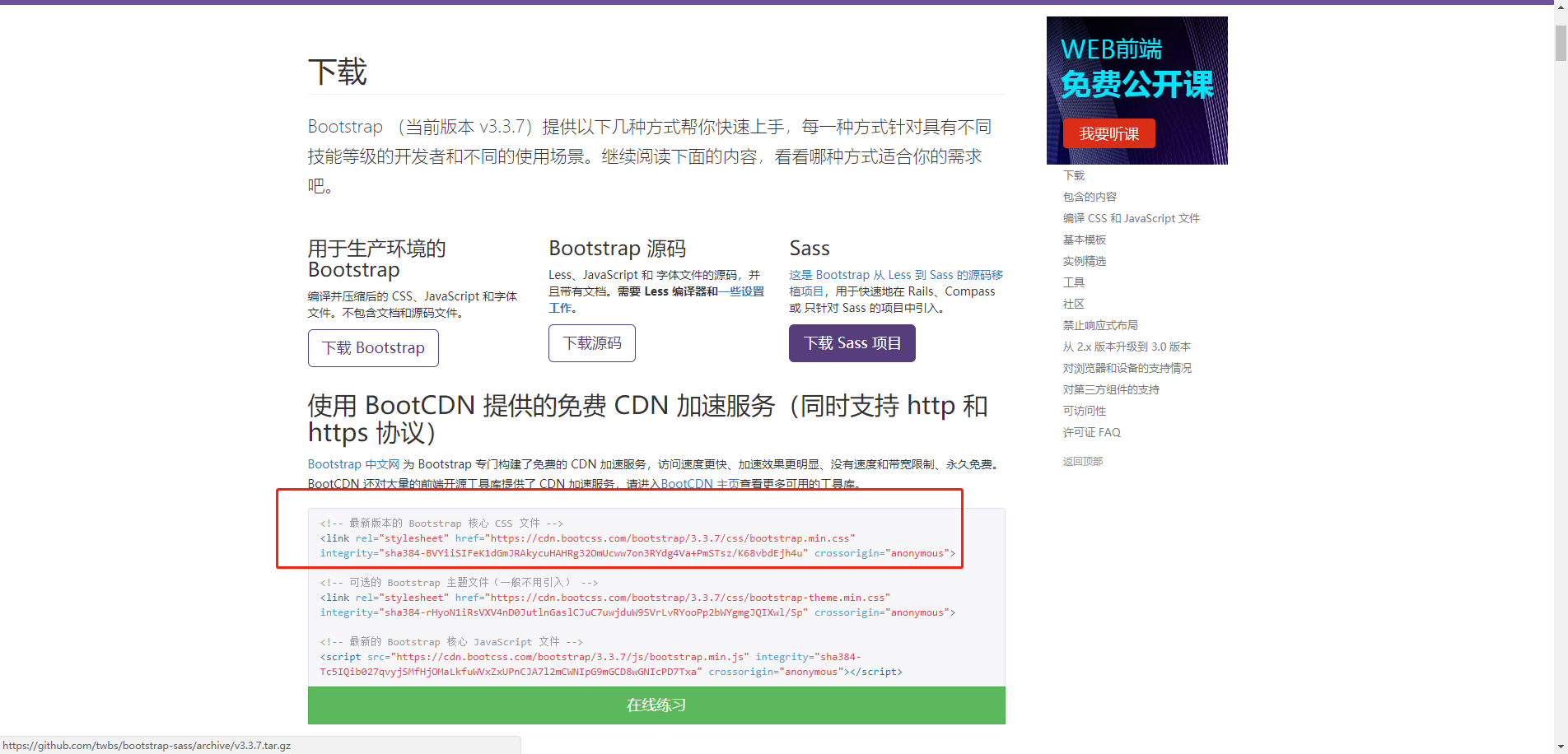
3、添加Bootstrap下的分页组件;
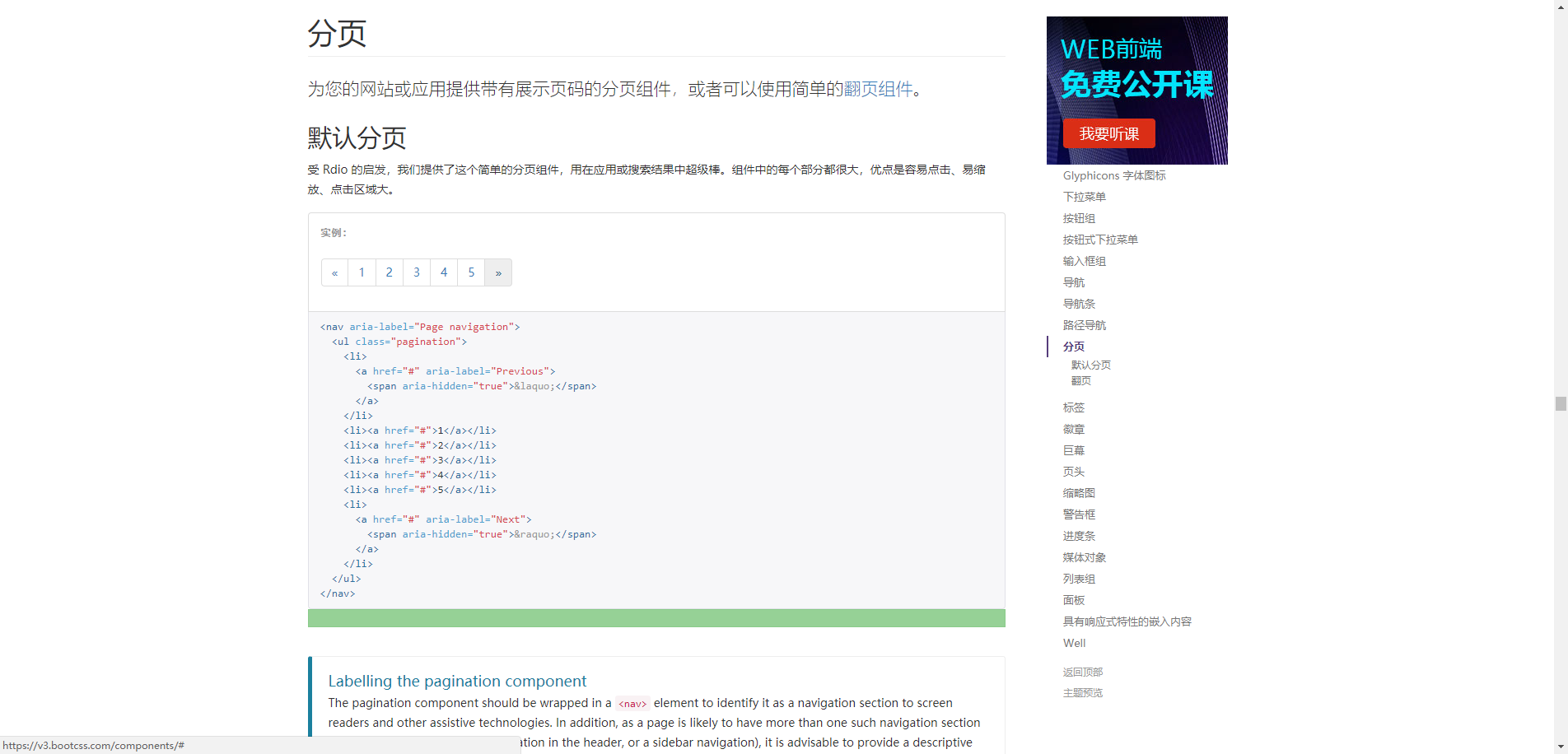
<nav aria-label="Page navigation"> <ul class="pagination"> <li> <a href="#" aria-label="Previous"> <span aria-hidden="true">«</span> </a> </li> <li><a href="#">1</a></li> <li><a href="#">2</a></li> <li><a href="#">3</a></li> <li><a href="#">4</a></li> <li><a href="#">5</a></li> <li> <a href="#" aria-label="Next"> <span aria-hidden="true">»</span> </a> </li> </ul> </nav>
4、针对分页的内容进行循环遍历;
index.html;
<!DOCTYPE html> <html lang="en"> <head> <meta charset="UTF-8"> <title>Django中的分页器</title> <!-- 最新版本的 Bootstrap 核心 CSS 文件 --> <link rel="stylesheet" href="https://cdn.bootcss.com/bootstrap/3.3.7/css/bootstrap.min.css" integrity="sha384-BVYiiSIFeK1dGmJRAkycuHAHRg32OmUcww7on3RYdg4Va+PmSTsz/K68vbdEjh4u" crossorigin="anonymous"> </head> <body> <ul> {% for book in current_page %} <li>{{ book.title }}:{{ book.price }}</li> {% endfor %} </ul> <nav aria-label="Page navigation"> <ul class="pagination"> <li> <a href="#" aria-label="Previous"><span aria-hidden="true">上一页</span></a> </li> {% for item in paginator.page_range %} {% if current_page_num == item %} <li class="active"><a href="?page={{ item }}">{{ item }}</a></li> {% else %} <li ><a href="?page={{ item }}">{{ item }}</a></li> {% endif %} {% endfor %} <li> <a href="#" aria-label="Next"><span aria-hidden="true">下一页</span></a> </li> </ul> </nav> </body> </html>
views.py;
from django.shortcuts import render # Create your views here. from app01.models import * #引入Django中的分页器; from django.core.paginator import Paginator,EmptyPage def index(request): "" ''' # #循环插入,不可取,效率低下,数据库压力过大!; # for i in range(10): # Book.objects.create(title="Book_%s"%i,price=i*i) #批量插入; book_list = [] for i in range(100): book = Book(title="book_%s"%i,price=i*i) book_list.append(book) #一次性批量插入; Book.objects.bulk_create(book_list) :param request: :return: ''' book_list = Book.objects.all() #分页器; paginator = Paginator(book_list,8) print("分页器的count:",paginator.count)#数据总数; print("分页器的num_pages:",paginator.num_pages)#总页数; print("分页器的page_range:",paginator.page_range)#页码的列表; #加入异常捕获; try: current_page_num = int(request.GET.get("page",1)) current_page = paginator.page(current_page_num) #page1 = paginator.page(2) #page1 = paginator.page(3) #显示某一页具体数据的两种方式; print("分页器的object_list",current_page.object_list) #进入循环打印; for i in current_page: print(i) except EmptyPage as e: #捕获到异常后,定位至第一页面,但是要提起导入EmptyPage模块; current_page = paginator.page(1) return render(request,"index.html",locals())
5、已选中的页签,进行加深显示;

98-分页器3
1、Django分页器3;
2、添加分页器的如下属性:
- ?page = {{ current_page_num|add:-1 }}
- ?page={{ current_page.previous_page_number}}
3、index.html:
<!DOCTYPE html> <html lang="en"> <head> <meta charset="UTF-8"> <title>Django中的分页器</title> <!-- 最新版本的 Bootstrap 核心 CSS 文件 --> <link rel="stylesheet" href="https://cdn.bootcss.com/bootstrap/3.3.7/css/bootstrap.min.css" integrity="sha384-BVYiiSIFeK1dGmJRAkycuHAHRg32OmUcww7on3RYdg4Va+PmSTsz/K68vbdEjh4u" crossorigin="anonymous"> </head> <body> <ul> {% for book in current_page %} <li>{{ book.title }}:{{ book.price }}</li> {% endfor %} </ul> <nav aria-label="Page navigation"> <ul class="pagination"> {% if current_page.has_previous %} <li> <!--<a href="?page={{ current_page_num|add:-1 }}" aria-label="Previous"><span aria-hidden="true">上一页</span></a>--> <a href="?page={{ current_page.previous_page_number}}" aria-label="Previous"><span aria-hidden="true">上一页</span></a> </li> {% else %} <li class="disabled"> <a href="" aria-label="Previous"><span aria-hidden="true">上一页</span></a> </li> {% endif %} {% for item in paginator.page_range %} {% if current_page_num == item %} <li class="active"><a href="?page={{ item }}">{{ item }}</a></li> {% else %} <li ><a href="?page={{ item }}">{{ item }}</a></li> {% endif %} {% endfor %} {% if current_page.has_next %} <li > <a href="?page={{ current_page.next_page_number}}" aria-label="Next"><span aria-hidden="true">下一页</span></a> </li> {% else %} <li class="disabled"> <a href="" aria-label="Next"><span aria-hidden="true">下一页</span></a> </li> {% endif %} </ul> </nav> </body> </html>
99-分页器4
1、Django下的分页器4;
2、index.html;
<!DOCTYPE html> <html lang="en"> <head> <meta charset="UTF-8"> <title>Django中的分页器</title> <!-- 最新版本的 Bootstrap 核心 CSS 文件 --> <link rel="stylesheet" href="https://cdn.bootcss.com/bootstrap/3.3.7/css/bootstrap.min.css" integrity="sha384-BVYiiSIFeK1dGmJRAkycuHAHRg32OmUcww7on3RYdg4Va+PmSTsz/K68vbdEjh4u" crossorigin="anonymous"> </head> <body> <ul> {% for book in current_page %} <li>{{ book.title }}:{{ book.price }}</li> {% endfor %} </ul> <nav aria-label="Page navigation"> <ul class="pagination"> {% if current_page.has_previous %} <li> <!--<a href="?page={{ current_page_num|add:-1 }}" aria-label="Previous"><span aria-hidden="true">上一页</span></a>--> <a href="?page={{ current_page.previous_page_number}}" aria-label="Previous"><span aria-hidden="true">上一页</span></a> </li> {% else %} <li class="disabled"> <a href="" aria-label="Previous"><span aria-hidden="true">上一页</span></a> </li> {% endif %} {% for item in page_range %} {% if current_page_num == item %} <li class="active"><a href="?page={{ item }}">{{ item }}</a></li> {% else %} <li ><a href="?page={{ item }}">{{ item }}</a></li> {% endif %} {% endfor %} {% if current_page.has_next %} <li > <a href="?page={{ current_page.next_page_number}}" aria-label="Next"><span aria-hidden="true">下一页</span></a> </li> {% else %} <li class="disabled"> <a href="" aria-label="Next"><span aria-hidden="true">下一页</span></a> </li> {% endif %} </ul> </nav> </body> </html>
3、views.py;
from django.shortcuts import render # Create your views here. from app01.models import * #引入Django中的分页器; from django.core.paginator import Paginator,EmptyPage def index(request): "" ''' # #循环插入,不可取,效率低下,数据库压力过大!; # for i in range(10): # Book.objects.create(title="Book_%s"%i,price=i*i) #批量插入; book_list = [] for i in range(100): book = Book(title="book_%s"%i,price=i*i) book_list.append(book) #一次性批量插入; Book.objects.bulk_create(book_list) :param request: :return: ''' book_list = Book.objects.all() #分页器; paginator = Paginator(book_list,3) print("分页器的count:",paginator.count)#数据总数; print("分页器的num_pages:",paginator.num_pages)#总页数; print("分页器的page_range:",paginator.page_range)#页码的列表; #加入异常捕获; #进行页码的判断; current_page_num = int(request.GET.get("page", 1)) if paginator.num_pages >11: if current_page_num-5 <1: page_range = range(1,12) elif current_page_num +5 >paginator.num_pages: page_range = range(paginator.num_pages-10,paginator.num_pages +1) else: page_range = range(current_page_num-5,current_page_num+6) else: page_range = paginator.page_range try: current_page = paginator.page(current_page_num) #page1 = paginator.page(2) #page1 = paginator.page(3) #显示某一页具体数据的两种方式; print("分页器的object_list",current_page.object_list) #进入循环打印; for i in current_page: print(i) except EmptyPage as e: #捕获到异常后,定位至第一页面,但是要提起导入EmptyPage模块; current_page = paginator.page(1) return render(request,"index.html",locals())
100-form组件的校验功能
1、form组件初识;
服务端假设所有用户提交的数据都是不可信任的,所以Django框架内置了form组件来验证用户提交的信息;
form组件的2大功能:
1、验证(显示错误信息);
2、保留用户上次输入的信息;
3、可以生成html标签;
2、创建Django项目-FormDemo并添加应用app01;
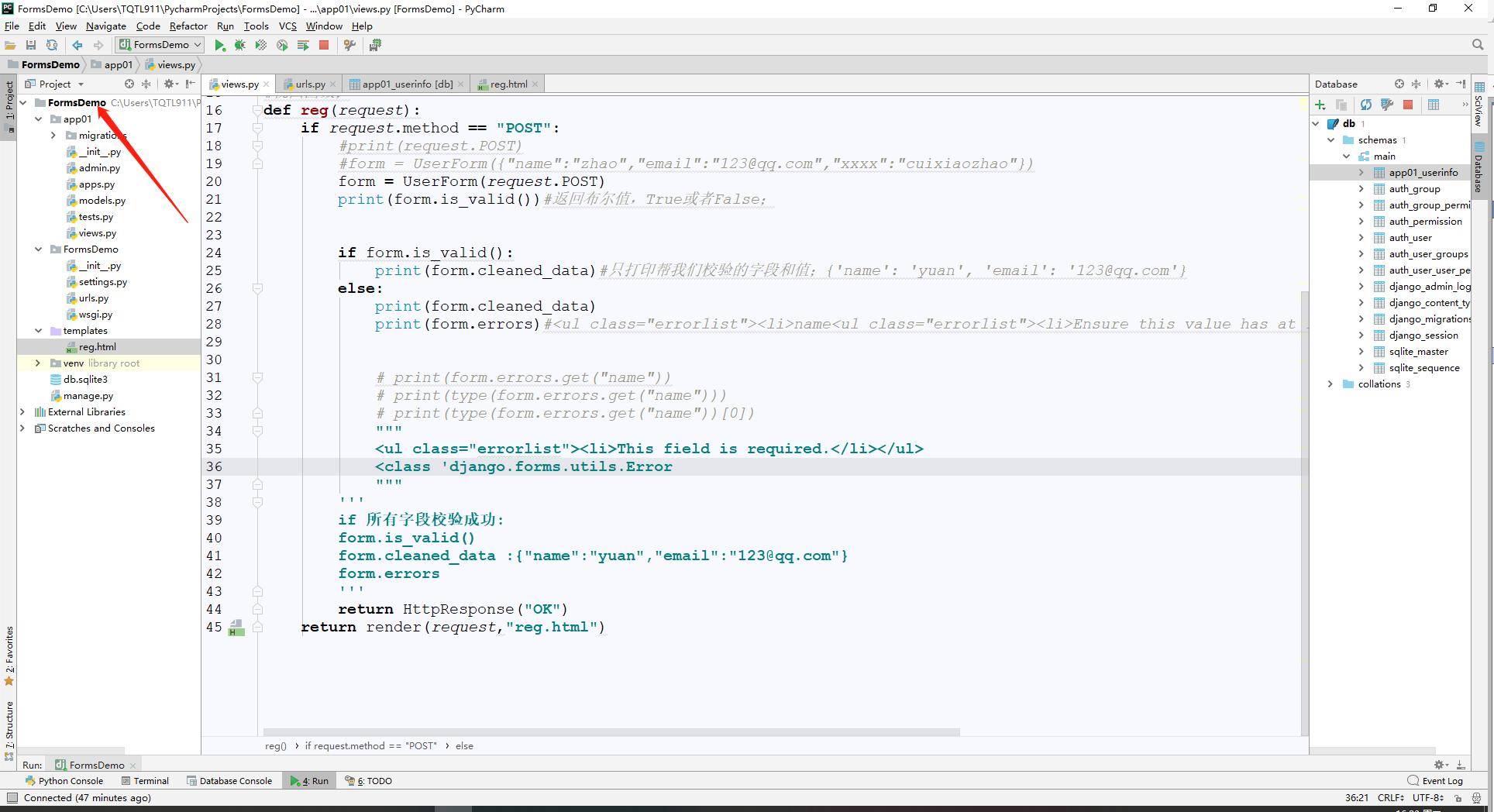
3、配合路由urls.py;
"""FormsDemo URL Configuration The `urlpatterns` list routes URLs to views. For more information please see: https://docs.djangoproject.com/en/2.1/topics/http/urls/ Examples: Function views 1. Add an import: from my_app import views 2. Add a URL to urlpatterns: path('', views.home, name='home') Class-based views 1. Add an import: from other_app.views import Home 2. Add a URL to urlpatterns: path('', Home.as_view(), name='home') Including another URLconf 1. Import the include() function: from django.urls import include, path 2. Add a URL to urlpatterns: path('blog/', include('blog.urls')) """ from django.contrib import admin from django.urls import path from app01 import views urlpatterns = [ path('admin/', admin.site.urls), path('reg/', views.reg), ]
4、views.py添加视图函数;
from django.shortcuts import render,HttpResponse # Create your views here. #创建form组件; from django import forms class UserForm(forms.Form): name = forms.CharField(min_length=4) pwd = forms.CharField(min_length=4) r_pwd = forms.CharField(min_length=4) email = forms.EmailField() tel = forms.CharField() #视图函数; def reg(request): if request.method == "POST": #print(request.POST) #form = UserForm({"name":"zhao","email":"123@qq.com","xxxx":"cuixiaozhao"}) form = UserForm(request.POST) print(form.is_valid())#返回布尔值,True或者False; if form.is_valid(): print(form.cleaned_data)#只打印帮我们校验的字段和值;{'name': 'yuan', 'email': '123@qq.com'} else: print(form.cleaned_data) print(form.errors)#<ul class="errorlist"><li>name<ul class="errorlist"><li>Ensure this value has at least 4 characters (it has 3).</li></ul></li></ul> # print(form.errors.get("name")) # print(type(form.errors.get("name"))) # print(type(form.errors.get("name"))[0]) """ <ul class="errorlist"><li>This field is required.</li></ul> <class 'django.forms.utils.Error """ ''' if 所有字段校验成功: form.is_valid() form.cleaned_data :{"name":"yuan","email":"123@qq.com"} form.errors ''' return HttpResponse("OK") return render(request,"reg.html")
5、models.py添加表结构;
from django.db import models # Create your models here. class UserInfo(models.Model): name = models.CharField(max_length=32) pwd = models.CharField(max_length=32) email = models.EmailField() tel = models.CharField(max_length=32)
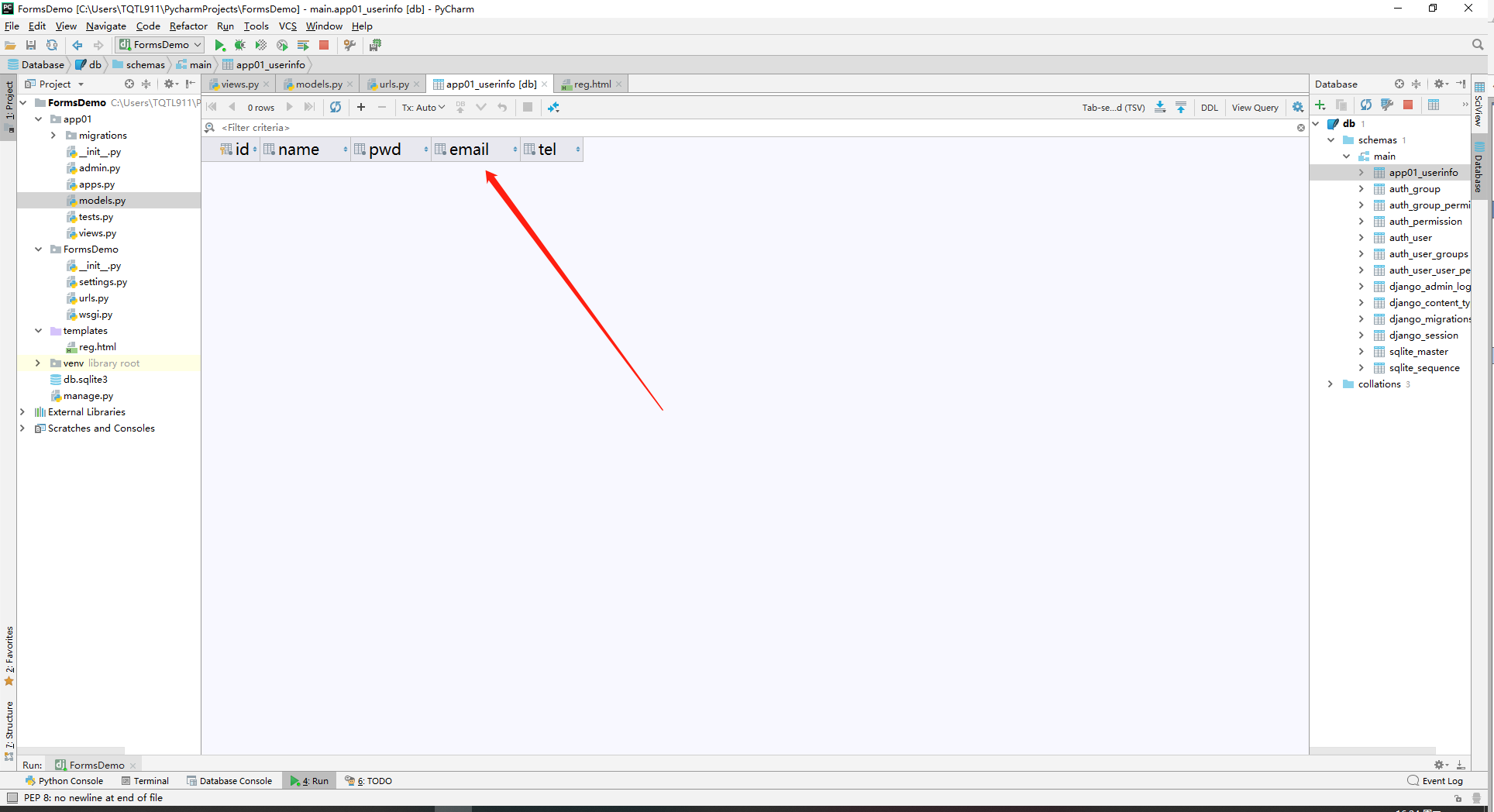
6、执行迁移数据库命令操作;
Microsoft Windows [版本 10.0.17134.1] (c) 2018 Microsoft Corporation。保留所有权利。 (venv) C:\Users\TQTL911\PycharmProjects\FormsDemo>python manage.py makemigrations Migrations for 'app01': app01\migrations\0001_initial.py - Create model UserInfo (venv) C:\Users\TQTL911\PycharmProjects\FormsDemo>python manage.py migrate Operations to perform: Apply all migrations: admin, app01, auth, contenttypes, sessions Running migrations: Applying contenttypes.0001_initial... OK Applying auth.0001_initial... OK Applying admin.0001_initial... OK Applying admin.0002_logentry_remove_auto_add... OK Applying admin.0003_logentry_add_action_flag_choices... OK Applying app01.0001_initial... OK Applying contenttypes.0002_remove_content_type_name... OK Applying auth.0002_alter_permission_name_max_length... OK Applying auth.0003_alter_user_email_max_length... OK Applying auth.0004_alter_user_username_opts... OK Applying auth.0005_alter_user_last_login_null... OK Applying auth.0006_require_contenttypes_0002... OK Applying auth.0007_alter_validators_add_error_messages... OK Applying auth.0008_alter_user_username_max_length... OK Applying auth.0009_alter_user_last_name_max_length... OK Applying sessions.0001_initial... OK (venv) C:\Users\TQTL911\PycharmProjects\FormsDemo>'
7、使用Pycharm自带Database客户端工具链接sqllite数据库;
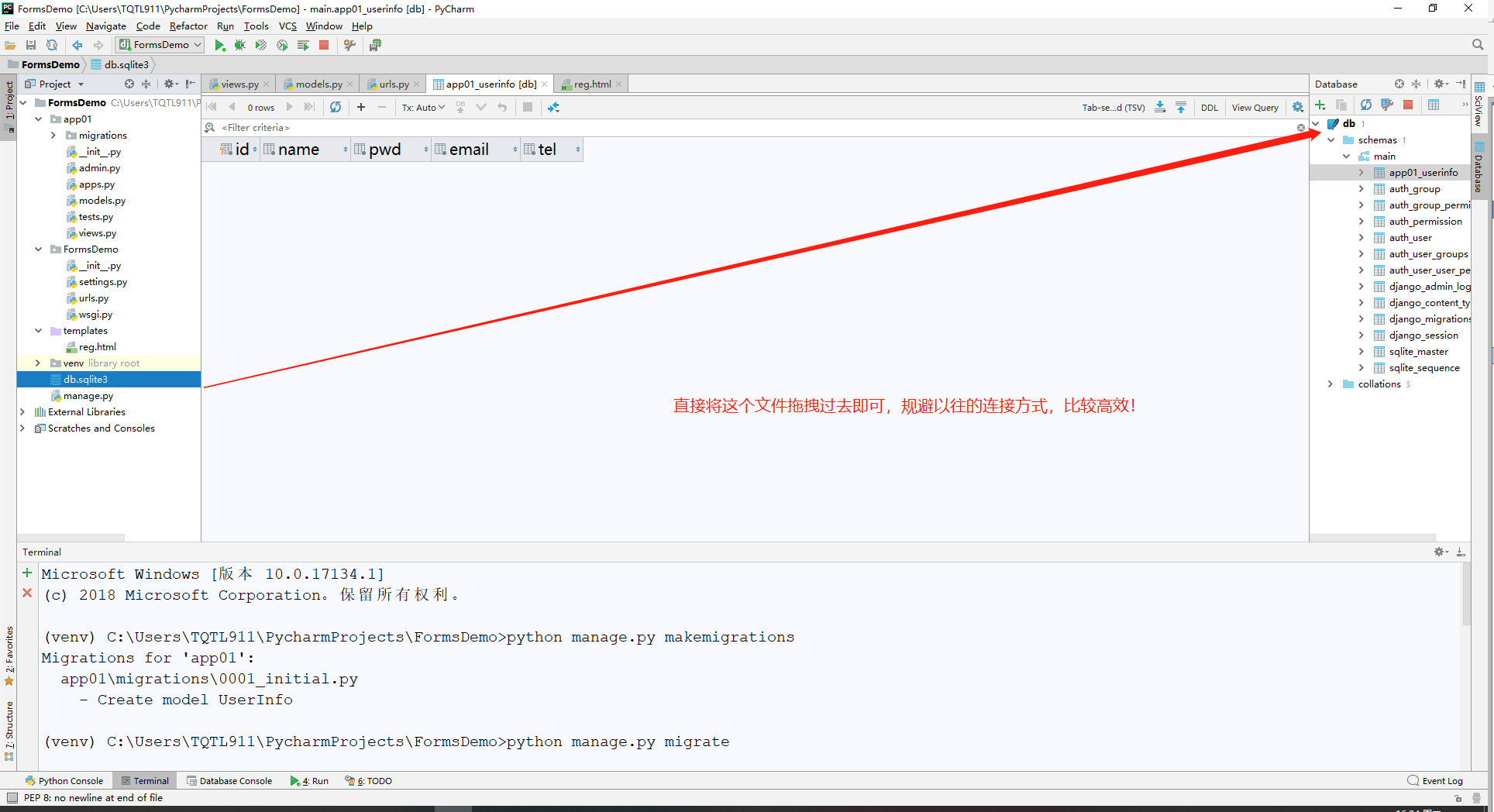
8、在模板路径templates下添加reg.html;
<!DOCTYPE html> <html lang="en"> <head> <meta charset="UTF-8"> <title>Title</title> <style type="text/css"> </style> </head> <body> <form action="" method="post"> {% csrf_token %} <p>用户名: <input type="text" name="name"></p> <p>密码:<input type="password" name="pwd"></p> <p>确认密码:<input type="password" name="r_pwd"></p> <p>邮箱:<input type="email" name="email"></p> <p>手机号:<input type="e" name="tel"></p> <input type="submit"> </form> </body> </html>
9、进行form组件的提交验证;
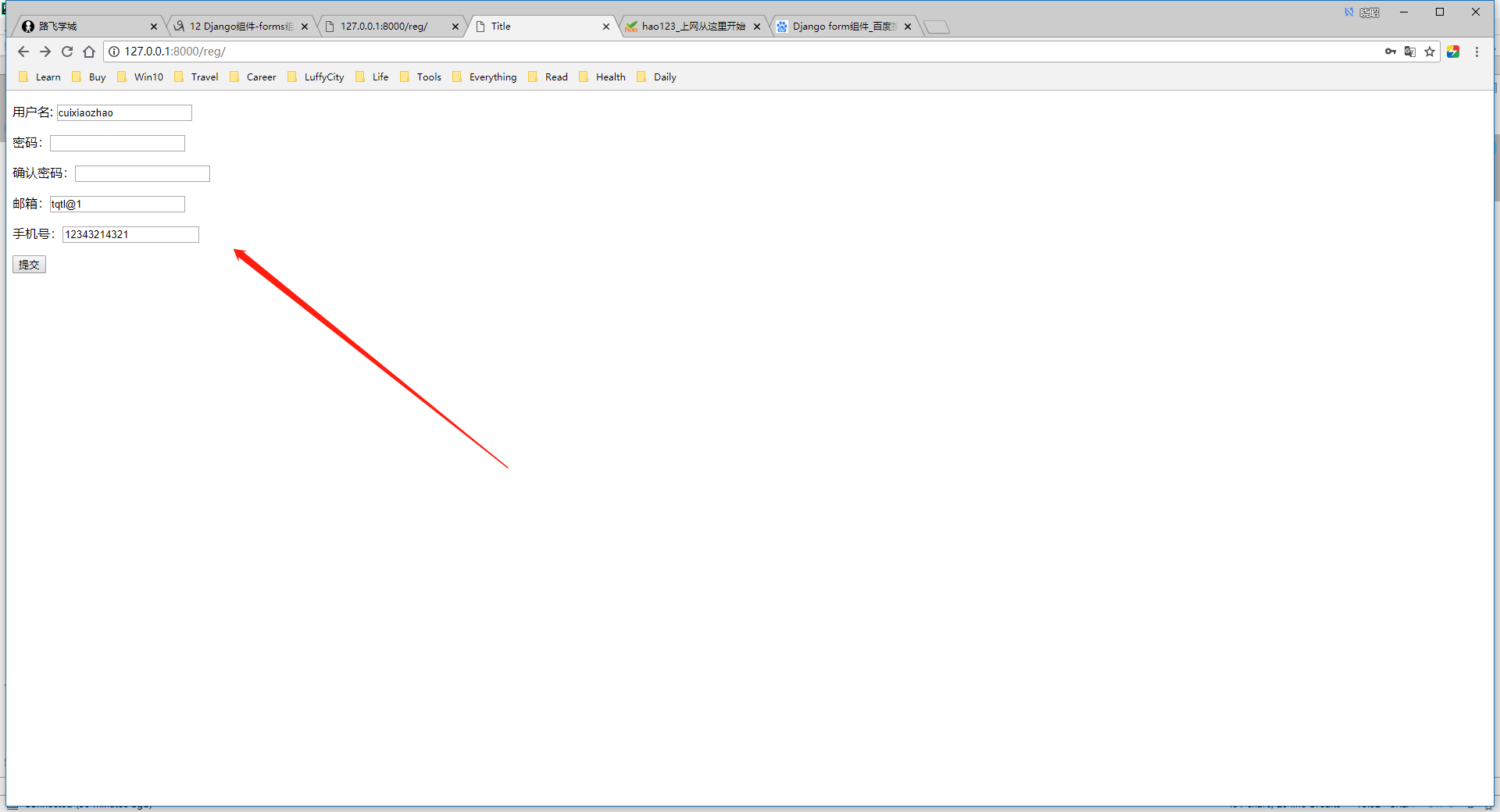
10、form组件的注意点;
- 导入forms模块;
- 创建自定义form类,比如UserInfo;
- is_valid()方法初识;
- form.cleaned_data初识;
- form.errors初识;
101-form组件的渲染标签功能1
1、form组件之渲染标签功能1;
2、views.py;
from django.shortcuts import render,HttpResponse # Create your views here. #创建form组件; from django import forms class UserForm(forms.Form): name = forms.CharField(min_length=4) pwd = forms.CharField(min_length=4) r_pwd = forms.CharField(min_length=4) email = forms.EmailField() tel = forms.CharField() #视图函数; def reg(request): if request.method == "POST": #print(request.POST) #form = UserForm({"name":"zhao","email":"123@qq.com","xxxx":"cuixiaozhao"}) form = UserForm(request.POST) print(form.is_valid())#返回布尔值,True或者False; if form.is_valid(): print(form.cleaned_data)#只打印帮我们校验的字段和值;{'name': 'yuan', 'email': '123@qq.com'} else: print(form.cleaned_data) print(form.errors)#<ul class="errorlist"><li>name<ul class="errorlist"><li>Ensure this value has at least 4 characters (it has 3).</li></ul></li></ul> # print(form.errors.get("name")) # print(type(form.errors.get("name"))) # print(type(form.errors.get("name"))[0]) """ <ul class="errorlist"><li>This field is required.</li></ul> <class 'django.forms.utils.Error """ ''' if 所有字段校验成功: form.is_valid() form.cleaned_data :{"name":"yuan","email":"123@qq.com"} form.errors ''' return HttpResponse("OK") #实例化form对象; form = UserForm() return render(request,"reg.html",locals())
3、reg.html;
<!DOCTYPE html> <html lang="en"> <head> <meta charset="UTF-8"> <title>Title</title> <style type="text/css"> </style> </head> <body> <form action="" method="post"> {% csrf_token %} <p>用户名: <input type="text" name="name"></p> <p>密码:<input type="password" name="pwd"></p> <p>确认密码:<input type="password" name="r_pwd"></p> <p>邮箱:<input type="email" name="email"></p> <p>手机号:<input type="e" name="tel"></p> <input type="submit"> </form> <br> <hr> <h3>form组件的渲染方式1</h3> <form action="" method="post"> {% csrf_token %} <p>用户名: {{ form.name }} </p> <p>密码: {{ form.pwd }} </p> <p>确认密码: {{ form.r_pwd }} </p> <p>邮箱: {{ form.email }} </p> <p>手机号: {{ form.tel }} </p> <input type="submit"> </form> </body> </html>
102-form组件的渲染标签功能2
1、form组件之渲染标签功能2;
2、reg.html;
- for循环之field.label
- form.as_p或者form.as_ul等方法介绍(不推荐使用哈,在测试环节可以用,应为它缺乏灵活性);
<!DOCTYPE html> <html lang="en"> <head> <meta charset="UTF-8"> <title>Title</title> <style type="text/css"> </style> </head> <body> <form action="" method="post"> {% csrf_token %} <p>用户名: <input type="text" name="name"></p> <p>密码:<input type="password" name="pwd"></p> <p>确认密码:<input type="password" name="r_pwd"></p> <p>邮箱:<input type="email" name="email"></p> <p>手机号:<input type="e" name="tel"></p> <input type="submit"> </form> <br> <hr> <h3>form组件的渲染方式1</h3> <form action="" method="post"> {% csrf_token %} <p>用户名: {{ form.name }} </p> <p>密码: {{ form.pwd }} </p> <p>确认密码: {{ form.r_pwd }} </p> <p>邮箱: {{ form.email }} </p> <p>手机号: {{ form.tel }} </p> <input type="submit"> </form> <br> <hr> <h2>form组件的渲染方式2</h2> <form action="" method="post"> {% csrf_token %} {% for field in form %} <div> <lable for="">{{ field.label }}</lable> {{ field }} </div> {% endfor %} <input type="submit"> </form> <br> <hr> <h1>form组件的渲染方式3-不推荐使用的哦!</h1> <form action="" method="post"> {% csrf_token %} <!--缺乏灵活性!--> {{ form.as_p }} <input type="submit"> </form> </body> </html>
103-form组件的渲染错误信息
1、form组件的渲染错误信息提示;
2、reg.html;
-
<span>{{ form.name.errors.0 }}</span>
<h3>form组件的渲染方式1</h3> <form action="" method="post"> {% csrf_token %} <p>用户名: {{ form.name }} <span>{{ form.name.errors.0 }}</span> </p> <p>密码: {{ form.pwd }} <span>{{ form.pwd.errors.0 }}</span> </p> <p>确认密码: {{ form.r_pwd }} <span>{{ form.r_pwd.errors.0 }}</span> </p> <p>邮箱: {{ form.email }} <span>{{ form.email.errors.0 }}</span> </p> <p>手机号: {{ form.tel }} <span>{{ form.tel.errors.0 }}</span> </p> <input type="submit"> </form>
104-form组件的参数配置
1、form组件的参数配置;
2、views.py;
from django.shortcuts import render,HttpResponse # Create your views here. #创建form组件; from django import forms # from django.forms import widgets class UserForm(forms.Form): name = forms.CharField(min_length=4,label="用户名",error_messages={"required":"该字段不能为空"},widget=widgets.TextInput(attrs={"class":"form-control"})) pwd = forms.CharField(min_length=4,label="密码",widget=widgets.PasswordInput(attrs={"class":"form-control"}),error_messages={"required":"该字段不能为空"}) r_pwd = forms.CharField(min_length=4,label="确认密码",widget=widgets.PasswordInput(attrs={"class":"form-control"}),error_messages={"required":"该字段不能为空","invalid":"格式错误!"}) email = forms.EmailField(label="邮箱",error_messages={"required":"该字段不能为空"},widget=widgets.TextInput(attrs={"class":"form-control"})) tel = forms.CharField(label="手机号",error_messages={"required":"该字段不能为空"},widget=widgets.TextInput(attrs={"class":"form-control"})) #视图函数; def reg(request): if request.method == "POST": #print(request.POST) #form = UserForm({"name":"zhao","email":"123@qq.com","xxxx":"cuixiaozhao"}) form = UserForm(request.POST) print(form.is_valid())#返回布尔值,True或者False; if form.is_valid(): print(form.cleaned_data)#只打印帮我们校验的字段和值;{'name': 'yuan', 'email': '123@qq.com'} else: print(form.cleaned_data) print(form.errors)#<ul class="errorlist"><li>name<ul class="errorlist"><li>Ensure this value has at least 4 characters (it has 3).</li></ul></li></ul> # print(form.errors.get("name")) # print(type(form.errors.get("name"))) # print(type(form.errors.get("name"))[0]) """ <ul class="errorlist"><li>This field is required.</li></ul> <class 'django.forms.utils.Error """ ''' if 所有字段校验成功: form.is_valid() form.cleaned_data :{"name":"yuan","email":"123@qq.com"} form.errors ''' return HttpResponse("OK") #实例化form对象; form = UserForm() return render(request,"reg.html",locals())
3、reg.html;
<!DOCTYPE html> <html lang="en"> <head> <meta charset="UTF-8"> <title>Title</title> <!-- 最新版本的 Bootstrap 核心 CSS 文件 --> <link rel="stylesheet" href="https://cdn.bootcss.com/bootstrap/3.3.7/css/bootstrap.min.css" integrity="sha384-BVYiiSIFeK1dGmJRAkycuHAHRg32OmUcww7on3RYdg4Va+PmSTsz/K68vbdEjh4u" crossorigin="anonymous"> </head> <body> <div class="container"> <div class="row"> <div class="col-md-6 col-lg-offset-3"> <form action="" method="post"> {% csrf_token %} <p>用户名: <input type="text" name="name"></p> <p>密码:<input type="password" name="pwd"></p> <p>确认密码:<input type="password" name="r_pwd"></p> <p>邮箱:<input type="email" name="email"></p> <p>手机号:<input type="e" name="tel"></p> <input type="submit"> </form> <br> <hr> <h3>form组件的渲染方式1</h3> <form action="" method="post"> {% csrf_token %} <p>用户名: {{ form.name }} <span>{{ form.name.errors.0 }}</span> </p> <p>密码: {{ form.pwd }} <span>{{ form.pwd.errors.0 }}</span> </p> <p>确认密码: {{ form.r_pwd }} <span>{{ form.r_pwd.errors.0 }}</span> </p> <p>邮箱: {{ form.email }} <span>{{ form.email.errors.0 }}</span> </p> <p>手机号: {{ form.tel }} <span>{{ form.tel.errors.0 }}</span> </p> <input type="submit"> </form> <br> <hr> <h2>form组件的渲染方式2</h2> <form action="" method="post"> {% csrf_token %} {% for field in form %} <div> <lable for="">{{ field.label }}</lable> {{ field }} </div> {% endfor %} <input type="submit"> </form> <br> <hr> <h1>form组件的渲染方式3-不推荐使用的哦!</h1> <form action="" method="post"> {% csrf_token %} <!--缺乏灵活性!--> {{ form.as_p }} <input type="submit"> </form> </div> </div> </div> </body> </html>
-
error_messages={"required":"该字段不能为空"}添加错误提示消息; -
widget=widgets.TextInput(attrs={"class":"form-control"})添加Bootstrap下的form-control属性; -
widget=widgets.PasswordInput(attrs={"class":"form-control"})添加Bootstrap下的form-control属性;
105-form组件检验的局部钩子
1、form组件之局部钩子;
106-组件之全局钩子校验
1、钩子校验;
2、myforms.py;
#!/usr/bin/env python3 # -*- coding:utf-8 -*- # __Author__:TQTL911 # Version:python3.6.6 # Time:2018/8/21 20:05 from django import forms from django.forms import widgets from app01.models import UserInfo from django.core.exceptions import NON_FIELD_ERRORS,ValidationError class UserForm(forms.Form): name = forms.CharField(min_length=4,label="用户名",error_messages={"required":"该字段不能为空"},widget=widgets.TextInput(attrs={"class":"form-control"})) pwd = forms.CharField(min_length=4,label="密码",widget=widgets.PasswordInput(attrs={"class":"form-control"}),error_messages={"required":"该字段不能为空"}) r_pwd = forms.CharField(min_length=4,label="确认密码",widget=widgets.PasswordInput(attrs={"class":"form-control"}),error_messages={"required":"该字段不能为空","invalid":"格式错误!"}) email = forms.EmailField(label="邮箱",error_messages={"required":"该字段不能为空"},widget=widgets.TextInput(attrs={"class":"form-control"})) tel = forms.CharField(label="手机号",error_messages={"required":"该字段不能为空"},widget=widgets.TextInput(attrs={"class":"form-control"})) #钩子 def clean_name(self): val = self.cleaned_data.get("name") ret = UserInfo.objects.filter(name=val) if not ret: return val else: raise ValidationError("该用户已经注册") def clean_tel(self): val = self.cleaned_data.get("tel") if len(val) ==11: return val else: raise ValidationError("手机号不能小于11位") def clean(self): pwd = self.cleaned_data.get("pwd") r_pwd = self.cleaned_data.get("r_pwd") if pwd and r_pwd: if pwd == r_pwd: return self.cleaned_data else: raise ValidationError("两次密码不一致!") else: return self.cleaned_data
3、views.py;
from django.shortcuts import render,HttpResponse # Create your views here. #创建form组件; from app01.myforms import * #视图函数; def reg(request): if request.method == "POST": print(request.POST) #form = UserForm({"name":"zhao","email":"123@qq.com","xxxx":"cuixiaozhao"}) form = UserForm(request.POST)#form表单的name属性值应该与forms组件字段名称一致 print(form.is_valid())#返回布尔值,True或者False; if form.is_valid(): print(form.cleaned_data)#只打印帮我们校验的字段和值;{'name': 'yuan', 'email': '123@qq.com'} else: print(form.cleaned_data) #print(form.errors)#<ul class="errorlist"><li>name<ul class="errorlist"><li>Ensure this value has at least 4 characters (it has 3).</li></ul></li></ul> # print(form.errors.get("name")) # print(type(form.errors.get("name"))) # print(type(form.errors.get("name"))[0]) """ <ul class="errorlist"><li>This field is required.</li></ul> <class 'django.forms.utils.Error """ errors = form.errors.get("__all__") return render(request,"reg.html",locals()) ''' if 所有字段校验成功: form.is_valid() form.cleaned_data :{"name":"yuan","email":"123@qq.com"} form.errors ''' #实例化form对象; form = UserForm() return render(request,"reg.html",locals())
4、reg.html;
<!DOCTYPE html> <html lang="en"> <head> <meta charset="UTF-8"> <title>Title</title> <!-- 最新版本的 Bootstrap 核心 CSS 文件 --> <link rel="stylesheet" href="https://cdn.bootcss.com/bootstrap/3.3.7/css/bootstrap.min.css" integrity="sha384-BVYiiSIFeK1dGmJRAkycuHAHRg32OmUcww7on3RYdg4Va+PmSTsz/K68vbdEjh4u" crossorigin="anonymous"> </head> <body> <div class="container"> <div class="row"> <div class="col-md-6 col-lg-offset-3"> {# <h3>form组件的渲染方式1</h3>#} {# <form action="" method="post">#} {# {% csrf_token %}#} {# <p>用户名:#} {# {{ form.name.label }} <span>{{ form.name.errors.0 }}</span>#} {# </p>#} {# <p>密码:#} {# {{ form.pwd.label }} <span>{{ form.pwd.errors.0 }}</span>#} {# </p>#} {# <p>确认密码:#} {# {{ form.r_pwd }} <span>{{ form.r_pwd.errors.0 }}</span>#} {# </p>#} {# <p>邮箱:#} {# {{ form.email }} <span>{{ form.email.errors.0 }}</span>#} {# </p>#} {# <p>手机号:#} {# {{ form.tel }} <span>{{ form.tel.errors.0 }}</span>#} {# </p>#} {# <input type="submit">#} {# </form>#} <h3>forms组件渲染方式1</h3> <form action="" method="post" novalidate> {% csrf_token %} <p>{{ form.name.label }} {{ form.name }} <span class="pull-right error">{{ form.name.errors.0 }}</span> </p> <p>{{ form.pwd.label }} {{ form.pwd }} <span class="pull-right error">{{ form.pwd.errors.0 }}</span> </p> <p>确认密码 {{ form.r_pwd }} <span class="pull-right error">{{ form.r_pwd.errors.0 }}</span><span class="pull-right error">{{ errors.0 }}</span> </p> <p>邮箱 {{ form.email }} <span class="pull-right error">{{ form.email.errors.0 }}</span></p> <p>手机号 {{ form.tel }} <span class="pull-right error">{{ form.tel.errors.0 }}</span></p> <input type="submit"> </form> </div> </div> </div> </body> </html>
107-HTTP协议的无状态保存
1、什么是HTTP协议的无状态保存?
无状态是指协议对于事务处理没有记忆功能。缺少状态意味着,假如后面的处理需要前面的信息,则前面的信息必须重传,这样可能导致每次连接传送的数据量增大。另一方面,在服务器不需要前面信息时,应答就较快。直观地说,就是每个请求都是独立的,与前面的请求和后面的请求都是没有直接联系的。
还是看百度百科的详细解释吧!https://baike.baidu.com/item/HTTP%E6%97%A0%E7%8A%B6%E6%80%81%E5%8D%8F%E8%AE%AE/5808645

108-Cookie简介
1、什么是会话呢?
1)什么是会话跟踪技术?
我们需要先了解一下什么是会话!可以把会话理解为客户端与服务器之间的一次会晤,在一次会晤中可能会包含多次请求和响应。例如你给10086打个电话,你就是客户端,而10086服务人员就是服务器了。从双方接通电话那一刻起,会话就开始了,到某一方挂断电话表示会话结束。在通话过程中,你会向10086发出多个请求,那么这多个请求都在一个会话中。
在JavaWeb中,客户向某一服务器发出第一个请求开始,会话就开始了,直到客户关闭了浏览器会话结束。 在一个会话的多个请求中共享数据,这就是会话跟踪技术。例如在一个会话中的请求如下: 请求银行主页;
- 请求登录(请求参数是用户名和密码);
- 请求转账(请求参数是与转账相关的数据);
- 请求信用卡还款(请求参数与还款相关的数据);
在这上会话中当前用户信息必须在这个会话中共享的,因为登录的是张三,那么在转账和还款时一定是相对张三的转账和还款!
小结:这就说明我们必须在一个会话过程中有共享数据的能力。
2)会话路径技术使用Cookie或者session完成
我们知道HTTP协议是无状态协议,也就是说每个请求都是独立的!无法记录前一次请求的状态。但HTTP协议中可以使用Cookie来完成会话跟踪!在Web开发中,使用session来完成会话跟踪,session底层依赖Cookie技术。
2、cookie是什么?
cookie即具体一个浏览器针对一个服务器存储的key-value{key:value};
Cookie翻译成中文是小甜点,小饼干的意思。在HTTP中它表示服务器送给客户端浏览器的小甜点。其实Cookie是key-value结构,类似于一个python中的字典。随着服务器端的响应发送给客户端浏览器。然后客户端浏览器会把Cookie保存起来,当下一次再访问服务器时把Cookie再发送给服务器。 Cookie是由服务器创建,然后通过响应发送给客户端的一个键值对。客户端会保存Cookie,并会标注出Cookie的来源(哪个服务器的Cookie)。当客户端向服务器发出请求时会把所有这个服务器Cookie包含在请求中发送给服务器,这样服务器就可以识别客户端了!
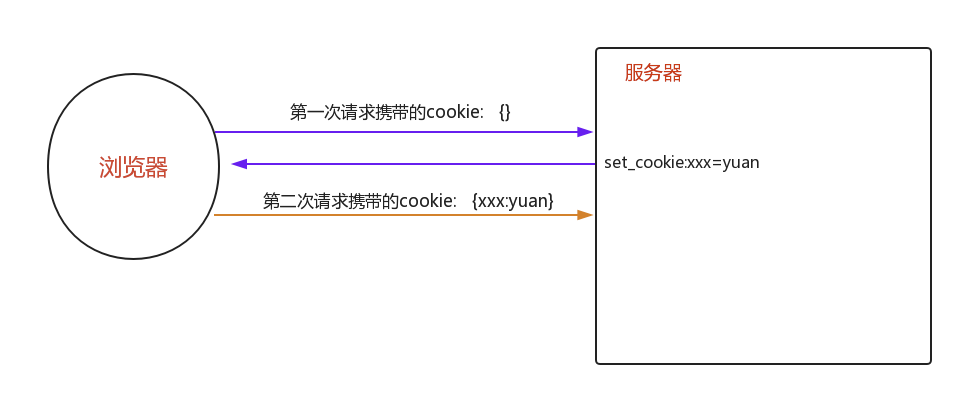
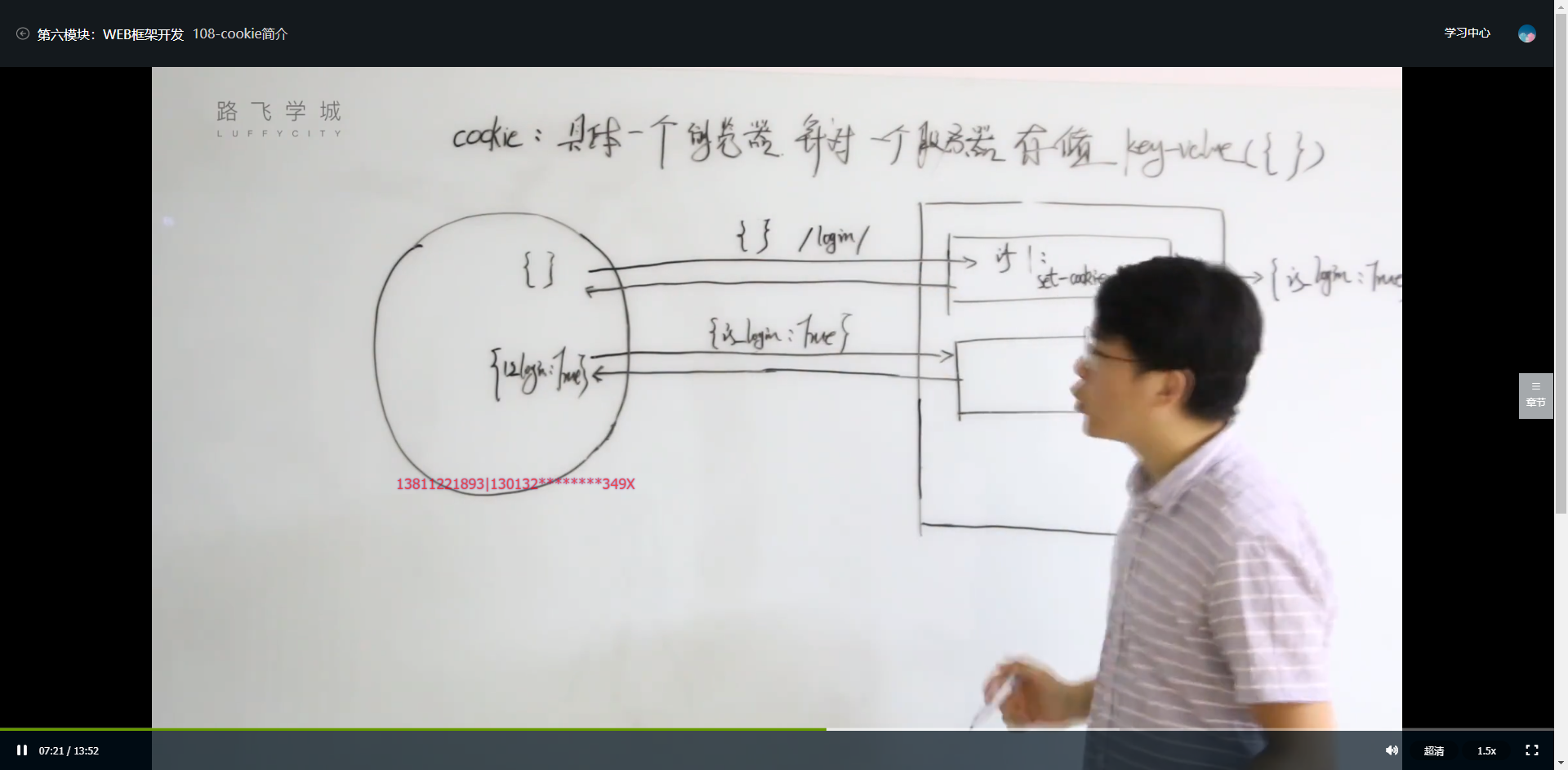
109-Cookie的设置与读取
1、新建CookieSession的Django项目;
2、设置urls.py下的path访问路径;
"""CookieSession URL Configuration The `urlpatterns` list routes URLs to views. For more information please see: https://docs.djangoproject.com/en/2.1/topics/http/urls/ Examples: Function views 1. Add an import: from my_app import views 2. Add a URL to urlpatterns: path('', views.home, name='home') Class-based views 1. Add an import: from other_app.views import Home 2. Add a URL to urlpatterns: path('', Home.as_view(), name='home') Including another URLconf 1. Import the include() function: from django.urls import include, path 2. Add a URL to urlpatterns: path('blog/', include('blog.urls')) """ from django.contrib import admin from django.urls import path from app01 import views urlpatterns = [ path('admin/', admin.site.urls), path('login/', views.login), path('index/', views.index), ]
3、编写views.py视图函数;
from django.shortcuts import render,HttpResponse,redirect # Create your views here. from app01.models import UserInfo def login(request): if request.method == "POST": user = request.POST.get("user") pwd = request.POST.get("pwd") user = UserInfo.objects.filter(user=user,pwd=pwd).first() if user: #登录成功 """ 响应体: return HttpResponse return render() return credits() """ response = HttpResponse("登录成功!") response.set_cookie("is_login",True) response.set_cookie("username",user.user) return response return render(request,"login.html") def index(request): is_login = request.COOKIES.get("is_login") if is_login: username = request.COOKIES.get("username") return render(request,"index.html",{"username":username}) else: return redirect("/login/") return render(request,"index.html")
4、配置templates下的login、index等html文件;
login.html;
<!DOCTYPE html> <html lang="en"> <head> <meta charset="UTF-8"> <title>Title</title> <style type="text/css"> </style> </head> <body> <form action="" method="post"> {% csrf_token %} 用户名:<input type="text" name="user"> 密码:<input type="password" name="pwd"> <input type="submit" value="submit"> </form> </body> </html>
index.html;
<!DOCTYPE html> <html lang="en"> <head> <meta charset="UTF-8"> <title>Title</title> <style type="text/css"> </style> </head> <body> <h3>Hi,{{ username }}</h3> </body> </html>
5、创建models.py下的表UserInfo并新增两条数据;
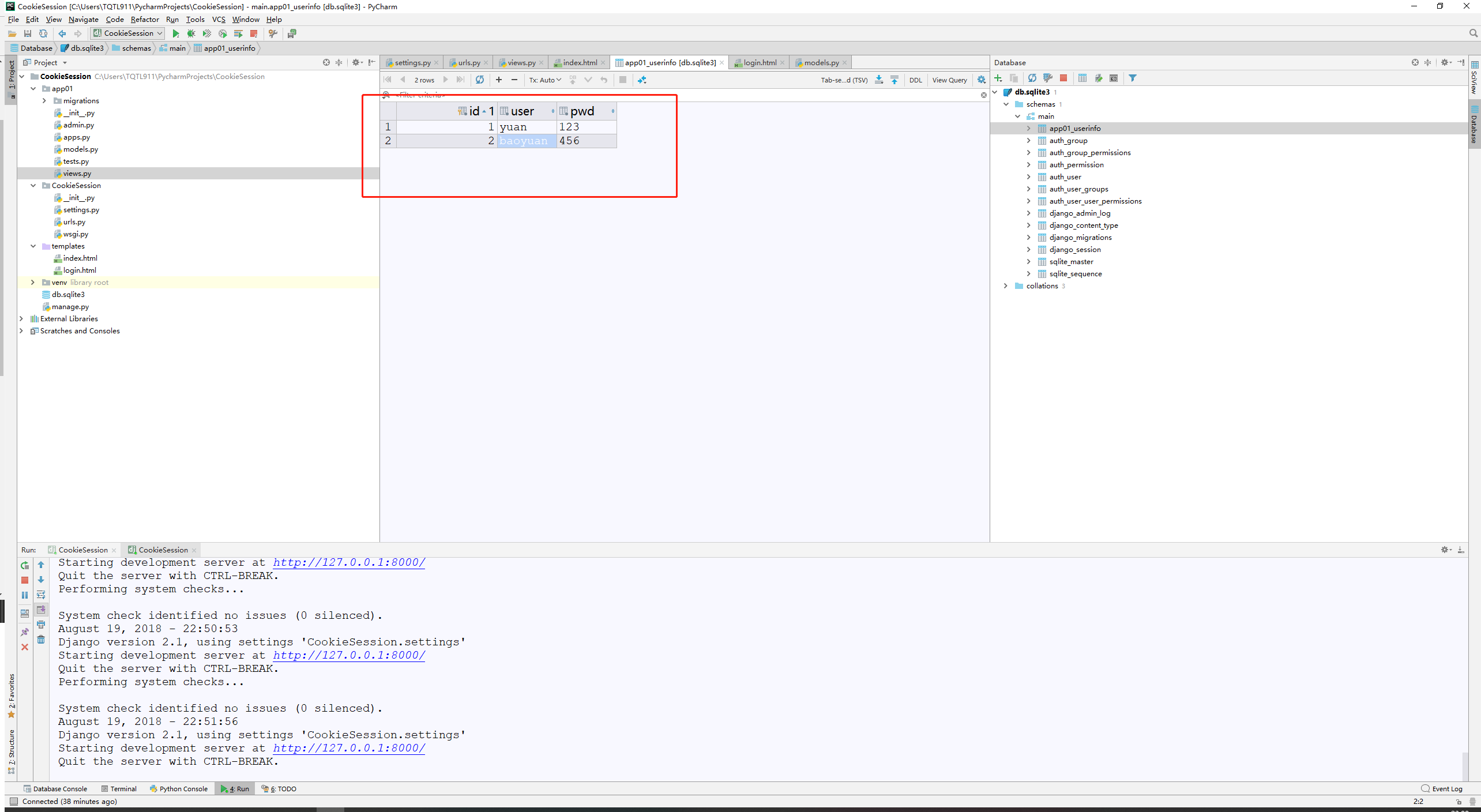
6、进行cookie的设置;
from django.shortcuts import render,HttpResponse,redirect # Create your views here. from app01.models import UserInfo def login(request): if request.method == "POST": user = request.POST.get("user") pwd = request.POST.get("pwd") user = UserInfo.objects.filter(user=user,pwd=pwd).first() if user: #登录成功 """ 响应体: return HttpResponse return render() return credits() """ response = HttpResponse("登录成功!") response.set_cookie("is_login",True) response.set_cookie("username",user.user) return response return render(request,"login.html") def index(request): is_login = request.COOKIES.get("is_login") if is_login: username = request.COOKIES.get("username") return render(request,"index.html",{"username":username}) else: return redirect("/login/") return render(request,"index.html")
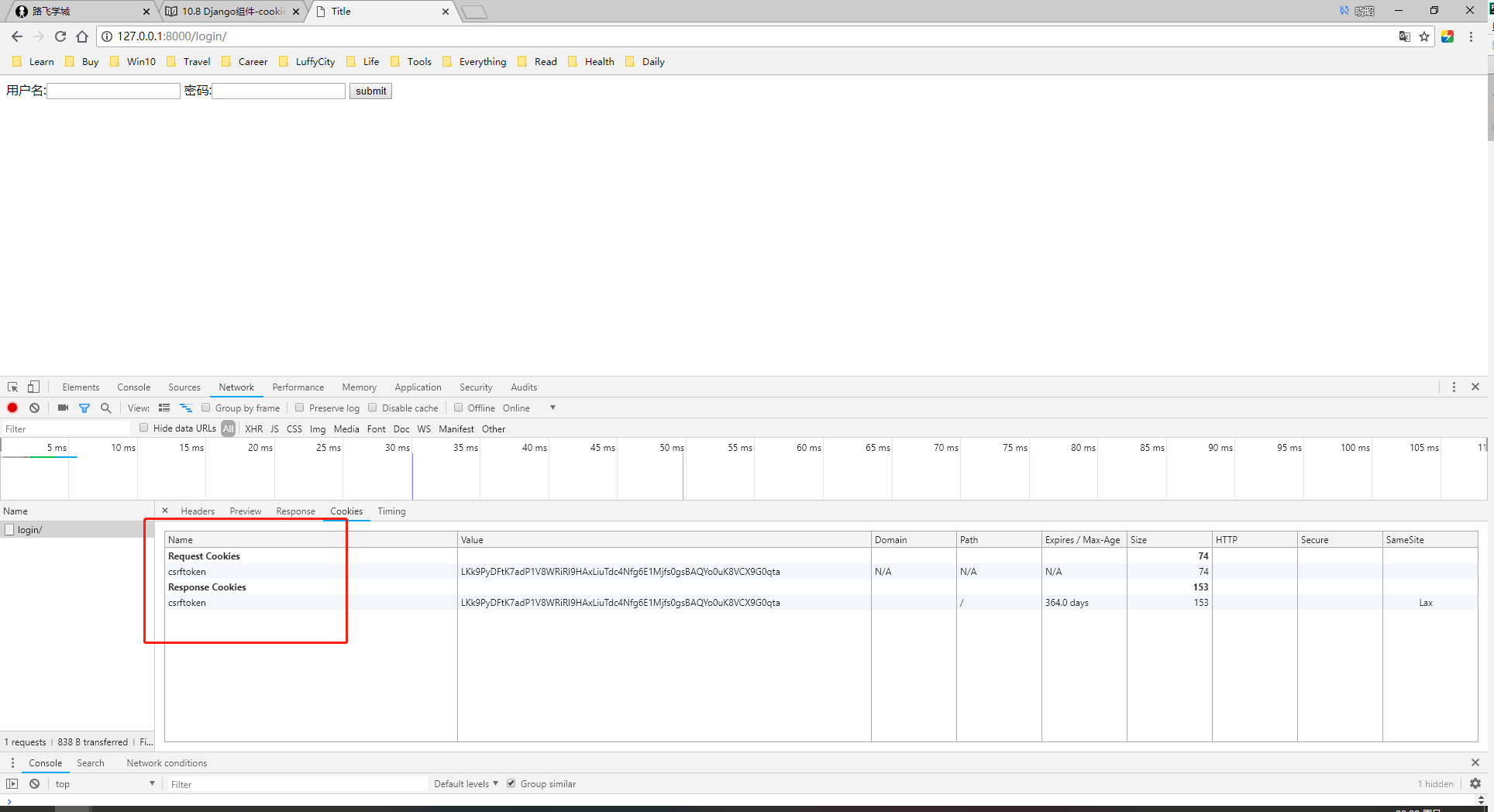
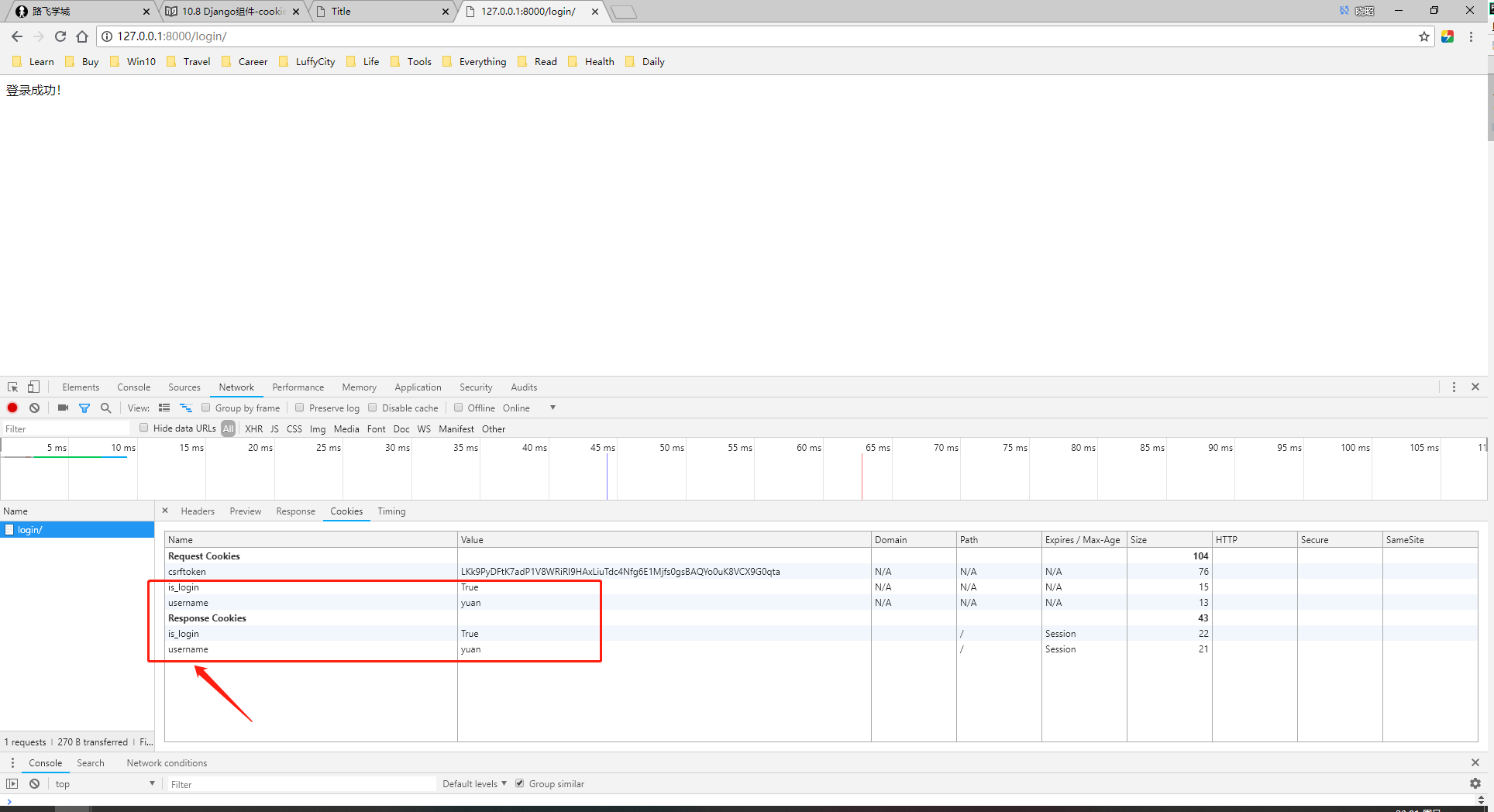
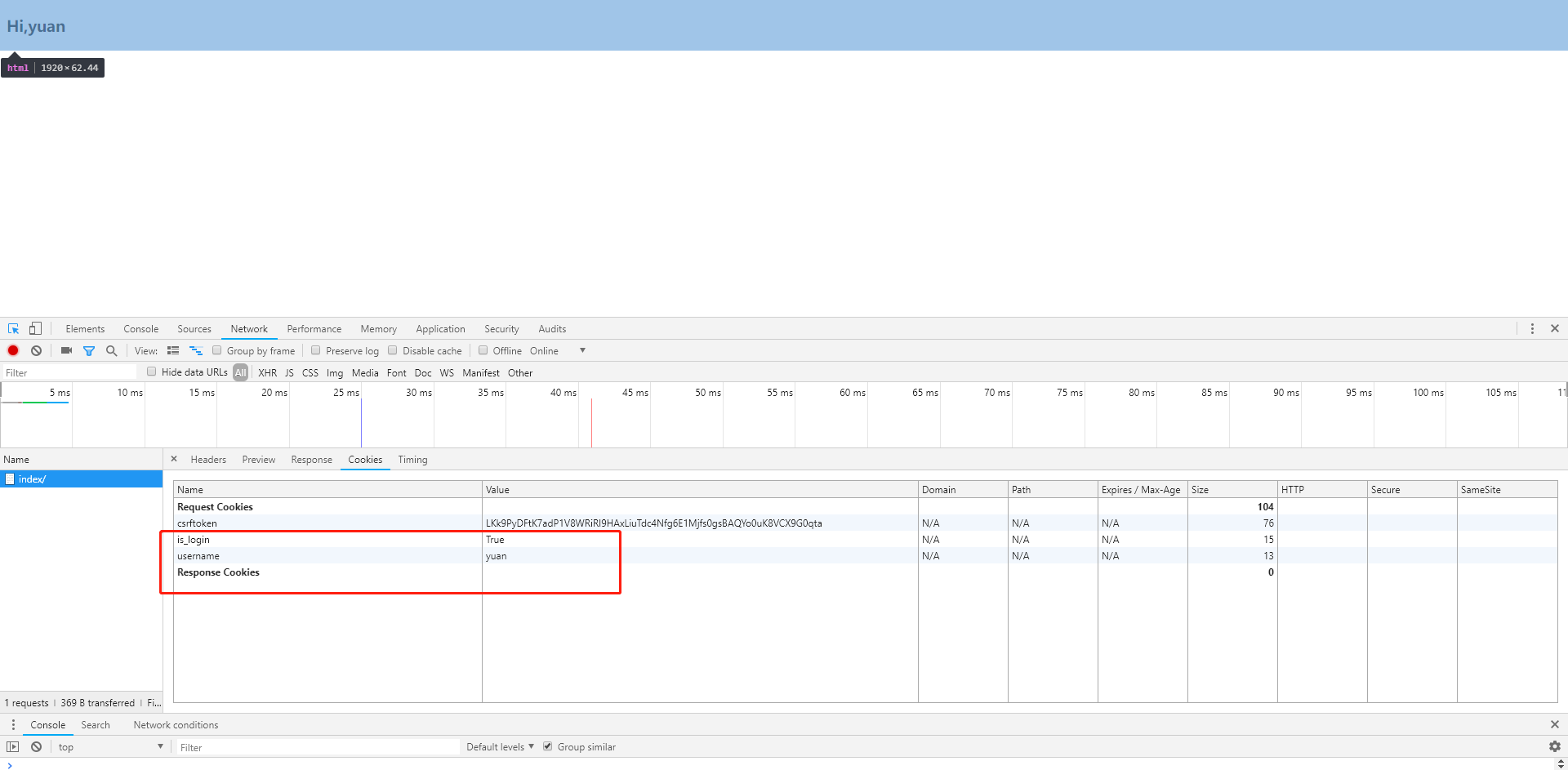
110-设置Cookie的超时参数
1、max_age = None,(单位15秒);
2、expires = None;
views.py;
from django.shortcuts import render,HttpResponse,redirect # Create your views here. from app01.models import UserInfo def login(request): if request.method == "POST": user = request.POST.get("user") pwd = request.POST.get("pwd") user = UserInfo.objects.filter(user=user,pwd=pwd).first() if user: #登录成功 """ 响应体: return HttpResponse return render() return credits() """ response = HttpResponse("登录成功!") #response.set_cookie("is_login",True,max_age=15) response.set_cookie("is_login",True) import datetime date = datetime.datetime(year=2018, month=8,day=21,hour=12,minute=48,second=10) response.set_cookie("username",user.user,expires=date) return response return render(request,"login.html") def index(request): print("index",request.COOKIES) is_login = request.COOKIES.get("is_login") if is_login: username = request.COOKIES.get("username") return render(request,"index.html",{"username":username}) else: return redirect("/login/") return render(request,"index.html")
111-设置Cookie的有效路径
1、对视图函数设置有效路径path;
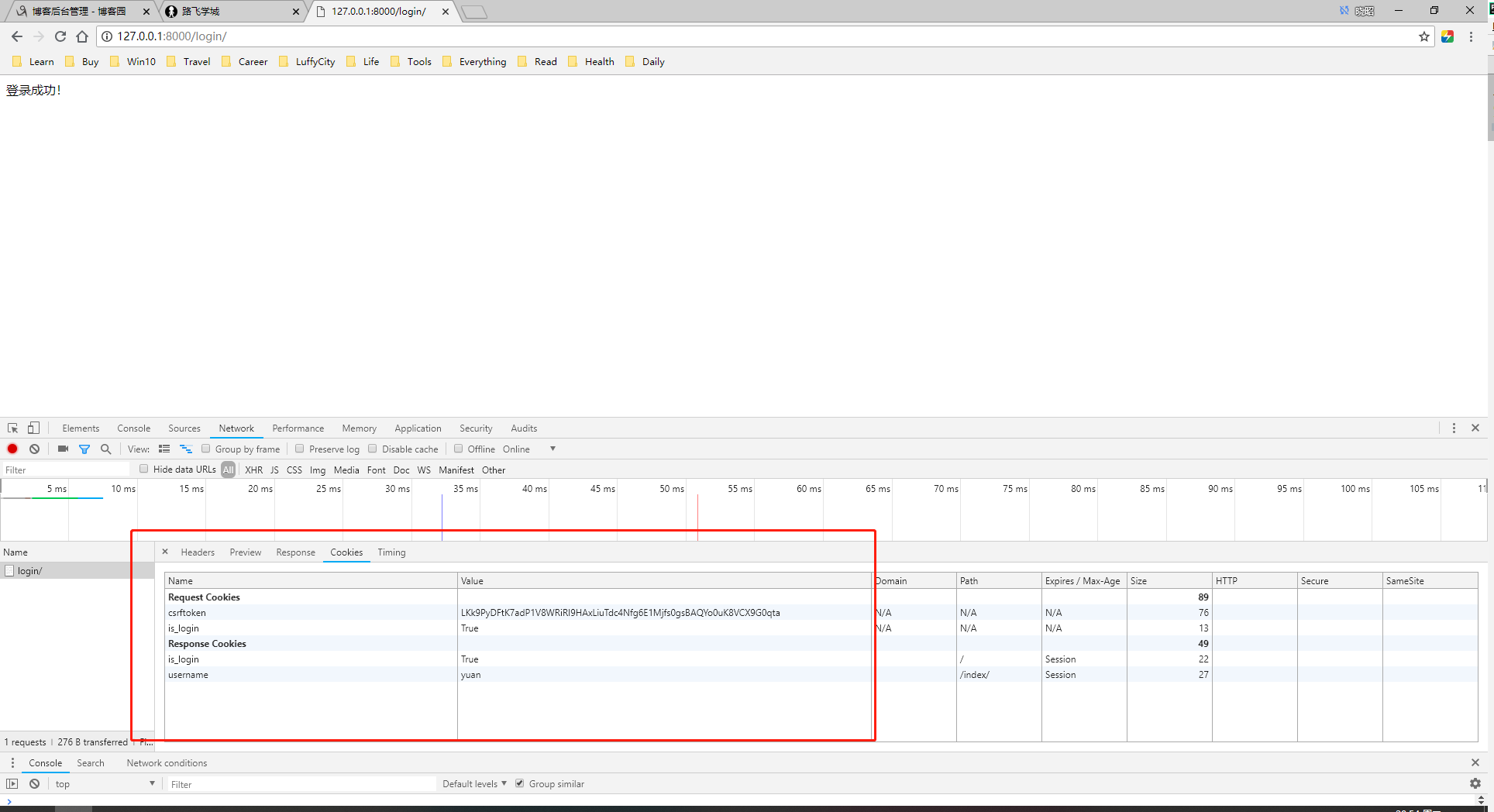
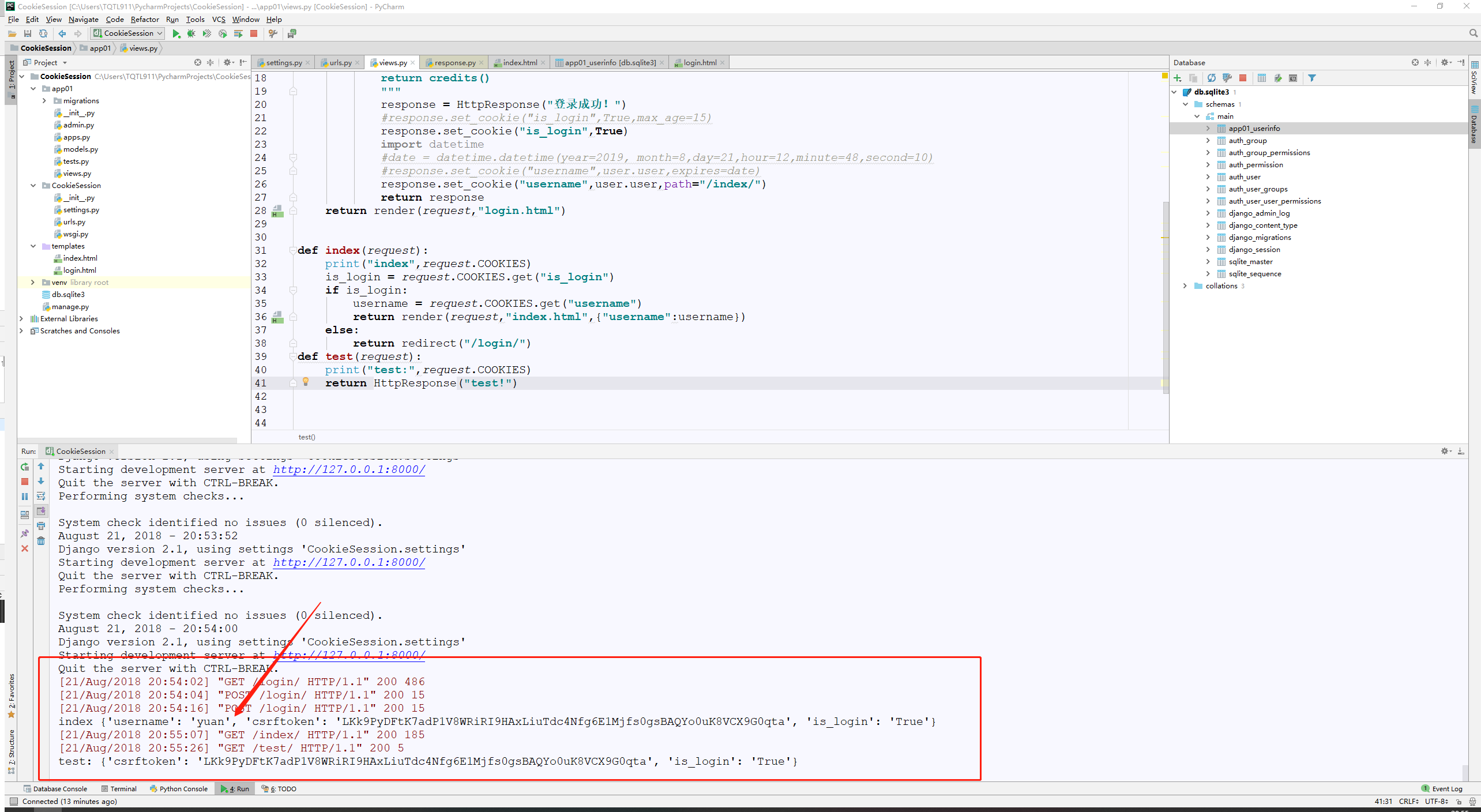
views.py;
from django.shortcuts import render,HttpResponse,redirect # Create your views here. from app01.models import UserInfo def login(request): if request.method == "POST": user = request.POST.get("user") pwd = request.POST.get("pwd") user = UserInfo.objects.filter(user=user,pwd=pwd).first() if user: #登录成功 """ 响应体: return HttpResponse return render() return credits() """ response = HttpResponse("登录成功!") #response.set_cookie("is_login",True,max_age=15) response.set_cookie("is_login",True) import datetime #date = datetime.datetime(year=2019, month=8,day=21,hour=12,minute=48,second=10) #response.set_cookie("username",user.user,expires=date) #设置COOKIE的有效路径! response.set_cookie("username",user.user,path="/index/") return response return render(request,"login.html") def index(request): print("index",request.COOKIES) is_login = request.COOKIES.get("is_login") if is_login: username = request.COOKIES.get("username") return render(request,"index.html",{"username":username}) else: return redirect("/login/") def test(request): print("test:",request.COOKIES) return HttpResponse("test!")
112-Cookie应用之保存上次访问时间
1、通过浏览器清除Cookies;Ctrl+Shift+Delete组合键;
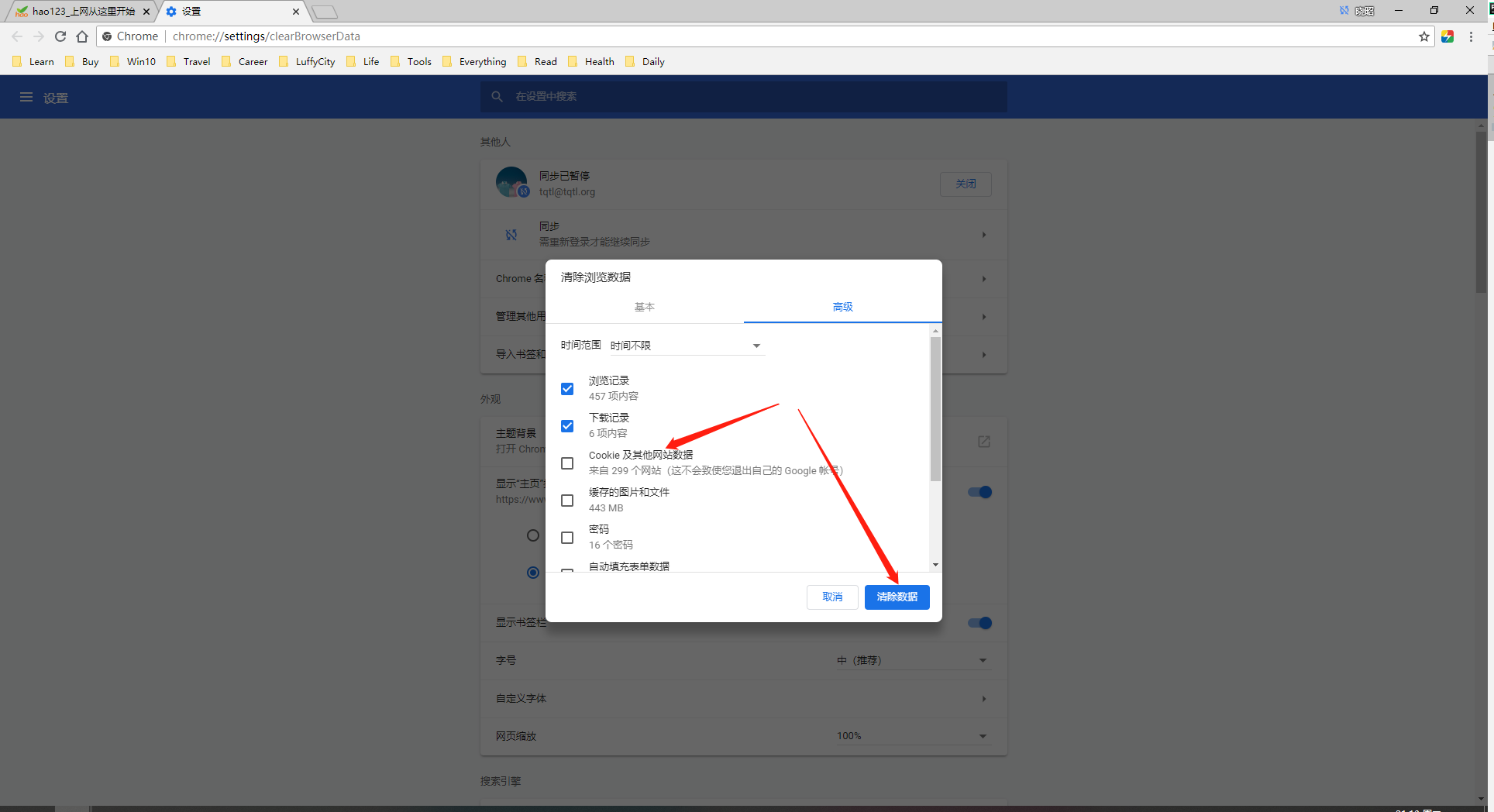
2、显示上次访问网站的时间;
views.py;
from django.shortcuts import render,HttpResponse,redirect # Create your views here. from app01.models import UserInfo def login(request): if request.method == "POST": user = request.POST.get("user") pwd = request.POST.get("pwd") user = UserInfo.objects.filter(user=user,pwd=pwd).first() if user: #登录成功 """ 响应体: return HttpResponse return render() return credits() """ response = HttpResponse("登录成功!") #response.set_cookie("is_login",True,max_age=15) response.set_cookie("is_login",True) import datetime #date = datetime.datetime(year=2019, month=8,day=21,hour=12,minute=48,second=10) #response.set_cookie("username",user.user,expires=date) #设置COOKIE的有效路径! response.set_cookie("username",user.user,path="/index/") return response return render(request,"login.html") def index(request): print("index",request.COOKIES) is_login = request.COOKIES.get("is_login") if is_login: username = request.COOKIES.get("username") #在Username之后设置cookies存储上次登录的时间; import datetime #将时间格式化转换为自定义格式; now = datetime.datetime.now().strftime("%Y-%m-%d %H:%M:%S") last_time = request.COOKIES.get("last_visit_time","") response = render(request,"index.html",{"username":username,"last_time":last_time}) response.set_cookie("last_visit_time",now) return response else: return redirect("/login/") def test(request): print("test:",request.COOKIES) return HttpResponse("test!")
index.htmll;
<!DOCTYPE html> <html lang="en"> <head> <meta charset="UTF-8"> <title>Title</title> <style type="text/css"> </style> </head> <body> <p>上次登录时间:{{ now }}</p> <h3>Hi,{{ last_time }}</h3> </body> </html>
3、显示上次浏览的商品的消息;
113-session的流程简介
1、session简介;
Session是服务器端技术,利用这个技术,服务器在运行时可以为每一个用户的浏览器创建一个其独享的session对象,由于 session为用户浏览器独享,所以用户在访问服务器的web资源时 ,可以把各自的数据放在各自的session中,当用户再去访问该服务器中的其它web资源时,其它web资源再从用户各自的session中 取出数据为用户服务。
2、session解析流程图;
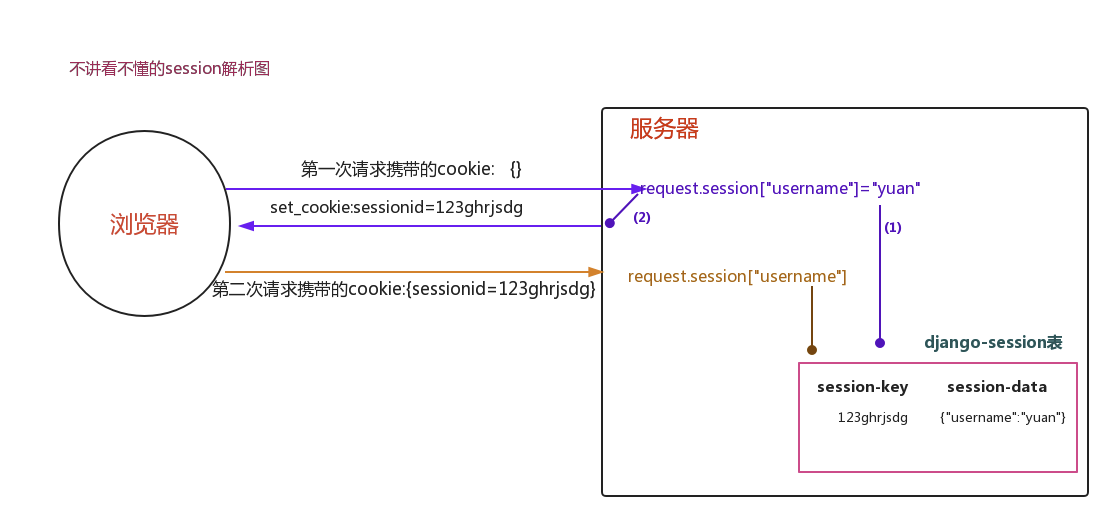
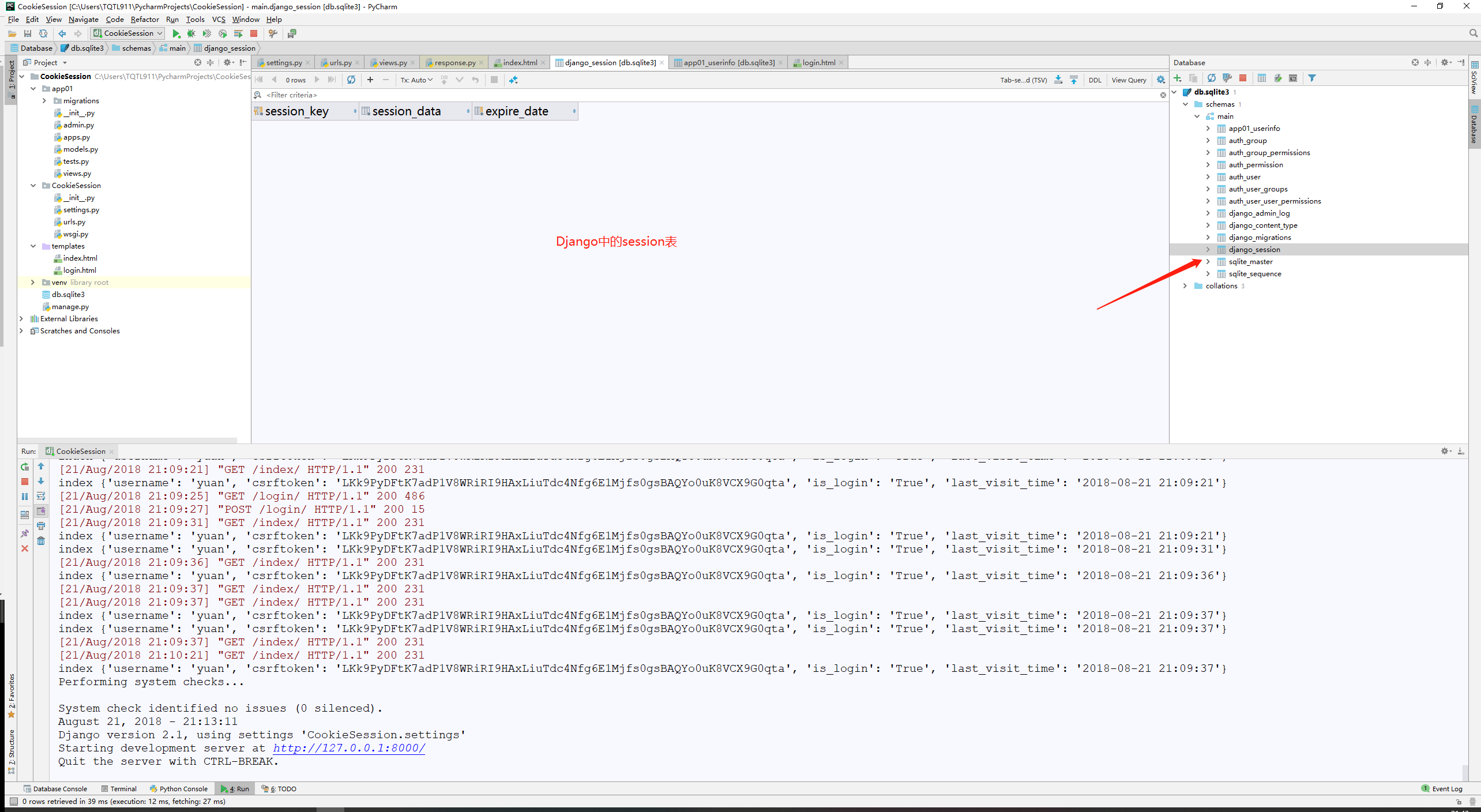
114-session之保存登录状态
1、session之保存登录状态;
三大步:
- 1、成随机字符串;43djklf342dfjklsjkfa
- 2、response.set_cookie("sessionid",d4tqdx057mtw7izkf1l2wb4cnizt7qqy)
- 3、在Django-session表中创建一条记录;
session-key session-data
d4tqdx057mtw7izkf1l2wb4cnizt7qqy {"is_login":True,"username":"yuan"}
2、views.py;
from django.shortcuts import render,HttpResponse,redirect # Create your views here. from app01.models import UserInfo def login(request): if request.method == "POST": user = request.POST.get("user") pwd = request.POST.get("pwd") user = UserInfo.objects.filter(user=user,pwd=pwd).first() if user: #登录成功 """ 响应体: return HttpResponse return render() return credits() """ response = HttpResponse("登录成功!") #response.set_cookie("is_login",True,max_age=15) response.set_cookie("is_login",True) import datetime #date = datetime.datetime(year=2019, month=8,day=21,hour=12,minute=48,second=10) #response.set_cookie("username",user.user,expires=date) #设置COOKIE的有效路径! response.set_cookie("username",user.user,path="/index/") return response return render(request,"login.html") def index(request): print("index",request.COOKIES) is_login = request.COOKIES.get("is_login") if is_login: username = request.COOKIES.get("username") #在Username之后设置cookies存储上次登录的时间; import datetime #将时间格式化转换为自定义格式; now = datetime.datetime.now().strftime("%Y-%m-%d %H:%M:%S") last_time = request.COOKIES.get("last_visit_time","") response = render(request,"index.html",{"username":username,"last_time":last_time}) response.set_cookie("last_visit_time",now) return response else: return redirect("/login/") def test(request): print("test:",request.COOKIES) return HttpResponse("test!") def login_session(request): if request.method == "POST": user = request.POST.get("user") pwd = request.POST.get("pwd") user = UserInfo.objects.filter(user=user,pwd=pwd).first() if user: request.session["is_login"] = True request.session["username"] = user.user ''' 1、成随机字符串;43djklf342dfjklsjkfa 2、response.set_cookie("sessionid",d4tqdx057mtw7izkf1l2wb4cnizt7qqy) 3、在Django-session表中创建一条记录; session-key session-data d4tqdx057mtw7izkf1l2wb4cnizt7qqy {"is_login":True,"username":"yuan"} ''' return HttpResponse("登录成功!") return render(request,"login.html") def index_session(request): print("is_login:",request.session.get("is_login")) ''' 1、request.COOKIE.get("session")#d4tqdx057mtw7izkf1l2wb4cnizt7qqy 2、django-session表中过滤记录; 在django-session表中创建一条记录; session-key session-data d4tqdx057mtw7izkf1l2wb4cnizt7qqy {"is_login":True,"username":"yuan"} obj-django-session.objects.fileter(session-key=d4tqdx057mtw7izkf1l2wb4cnizt7qqy).first() 3、obj.session-data.get("is_login") ''' is_login = request.session.get("is_login") if not is_login: return redirect("/login_session/") username = request.session.get("username") return render(request,"index.html",{"username":username})
3、index.html;
<!DOCTYPE html> <html lang="en"> <head> <meta charset="UTF-8"> <title>Title</title> <style type="text/css"> </style> </head> <body> <p>上次登录时间:{{ now }}</p> <h3>Hi,{{ username }}</h3> </body> </html>
115-session应用之保存上次登录时间
1、基于session实现保存上次登录的时间;
2、views.py;
from django.shortcuts import render,HttpResponse,redirect # Create your views here. from app01.models import UserInfo def login(request): if request.method == "POST": user = request.POST.get("user") pwd = request.POST.get("pwd") user = UserInfo.objects.filter(user=user,pwd=pwd).first() if user: #登录成功 """ 响应体: return HttpResponse return render() return credits() """ response = HttpResponse("登录成功!") #response.set_cookie("is_login",True,max_age=15) response.set_cookie("is_login",True) import datetime #date = datetime.datetime(year=2019, month=8,day=21,hour=12,minute=48,second=10) #response.set_cookie("username",user.user,expires=date) #设置COOKIE的有效路径! response.set_cookie("username",user.user,path="/index/") return response return render(request,"login.html") def index(request): print("index",request.COOKIES) is_login = request.COOKIES.get("is_login") if is_login: username = request.COOKIES.get("username") #在Username之后设置cookies存储上次登录的时间; import datetime #将时间格式化转换为自定义格式; now = datetime.datetime.now().strftime("%Y-%m-%d %H:%M:%S") last_time = request.COOKIES.get("last_visit_time","") response = render(request,"index.html",{"username":username,"last_time":last_time}) response.set_cookie("last_visit_time",now) return response else: return redirect("/login/") def test(request): print("test:",request.COOKIES) return HttpResponse("test!") def login_session(request): if request.method == "POST": user = request.POST.get("user") pwd = request.POST.get("pwd") user = UserInfo.objects.filter(user=user,pwd=pwd).first() if user: import datetime # 将时间格式化转换为自定义格式; now = datetime.datetime.now().strftime("%Y-%m-%d %H:%M:%S") request.session["is_login"] = True request.session["username"] = user.user #通过session设置上次登录时间; request.session["last_visit_time"] = now ''' 1、成随机字符串;43djklf342dfjklsjkfa 2、response.set_cookie("sessionid",d4tqdx057mtw7izkf1l2wb4cnizt7qqy) 3、在Django-session表中创建一条记录; session-key session-data d4tqdx057mtw7izkf1l2wb4cnizt7qqy {"is_login":True,"username":"yuan"} ''' return HttpResponse("登录成功!") return render(request,"login.html") def index_session(request): print("is_login:",request.session.get("is_login")) ''' 1、request.COOKIE.get("session")#d4tqdx057mtw7izkf1l2wb4cnizt7qqy 2、django-session表中过滤记录; 在django-session表中创建一条记录; session-key session-data d4tqdx057mtw7izkf1l2wb4cnizt7qqy {"is_login":True,"username":"yuan"} obj-django-session.objects.fileter(session-key=d4tqdx057mtw7izkf1l2wb4cnizt7qqy).first() 3、obj.session-data.get("is_login") ''' is_login = request.session.get("is_login") if not is_login: return redirect("/login_session/") username = request.session.get("username") last_visit_time = request.session.get("last_visit_time") return render(request,"index.html",{"username":username,"last_visit_time":last_visit_time})
3、index.html;
<!DOCTYPE html> <html lang="en"> <head> <meta charset="UTF-8"> <title>Title</title> <style type="text/css"> </style> </head> <body> <p>上次登录时间:{{ now }}</p> <h3>Hi,{{ username }}</h3> <h3>Hi,上次访问时间:{{ last_visit_time }}</h3> </body> </html>
116-session的更新操作
1、session的更新操作;
2、分为如下几种情况:
- 初次登录,比如Chrome;
- 相同用户再次登录,Chrome;
- 不同用户,再次登录,Chrome;
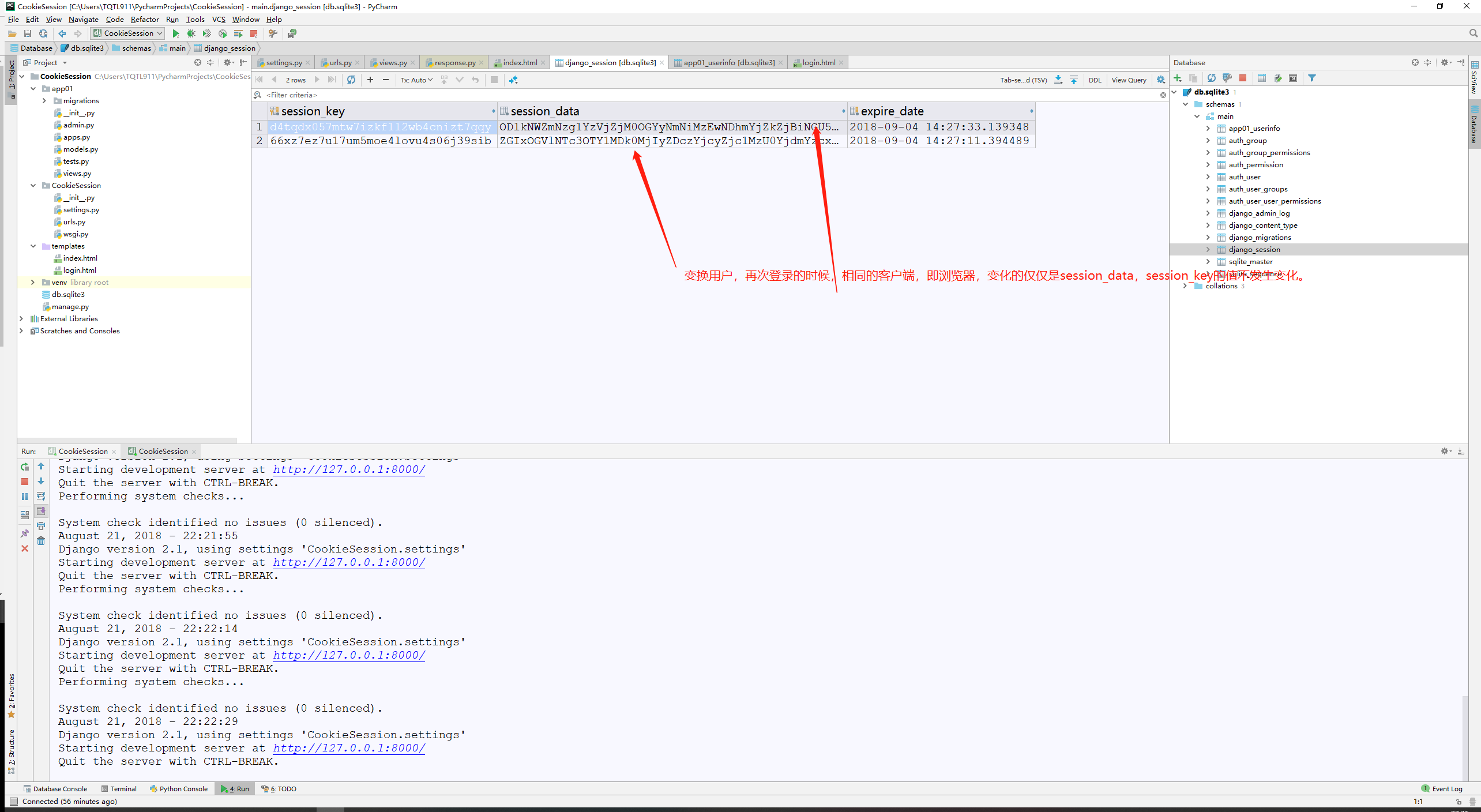
117-基于session的注销功能
- 通过del request.session["is_login"]方法删除session信息,但是不推荐;
- request.session.flush()方式进行清除session记录,Django-session表中的记录也删除;
1、views.py;
from django.shortcuts import render,HttpResponse,redirect # Create your views here. from app01.models import UserInfo def login(request): if request.method == "POST": user = request.POST.get("user") pwd = request.POST.get("pwd") user = UserInfo.objects.filter(user=user,pwd=pwd).first() if user: #登录成功 """ 响应体: return HttpResponse return render() return credits() """ response = HttpResponse("登录成功!") #response.set_cookie("is_login",True,max_age=15) response.set_cookie("is_login",True) import datetime #date = datetime.datetime(year=2019, month=8,day=21,hour=12,minute=48,second=10) #response.set_cookie("username",user.user,expires=date) #设置COOKIE的有效路径! response.set_cookie("username",user.user,path="/index/") return response return render(request,"login.html") def index(request): print("index",request.COOKIES) is_login = request.COOKIES.get("is_login") if is_login: username = request.COOKIES.get("username") #在Username之后设置cookies存储上次登录的时间; import datetime #将时间格式化转换为自定义格式; now = datetime.datetime.now().strftime("%Y-%m-%d %H:%M:%S") last_time = request.COOKIES.get("last_visit_time","") response = render(request,"index.html",{"username":username,"last_time":last_time}) response.set_cookie("last_visit_time",now) return response else: return redirect("/login/") def test(request): print("test:",request.COOKIES) return HttpResponse("test!") def login_session(request): if request.method == "POST": user = request.POST.get("user") pwd = request.POST.get("pwd") user = UserInfo.objects.filter(user=user,pwd=pwd).first() if user: import datetime # 将时间格式化转换为自定义格式; now = datetime.datetime.now().strftime("%Y-%m-%d %H:%M:%S") request.session["is_login"] = True request.session["username"] = user.user #通过session设置上次登录时间; request.session["last_visit_time"] = now ''' 1、成随机字符串;43djklf342dfjklsjkfa 2、response.set_cookie("sessionid",d4tqdx057mtw7izkf1l2wb4cnizt7qqy) 3、在Django-session表中创建一条记录; session-key session-data d4tqdx057mtw7izkf1l2wb4cnizt7qqy {"is_login":True,"username":"yuan"} ''' return HttpResponse("登录成功!") return render(request,"login.html") def index_session(request): print("is_login:",request.session.get("is_login")) ''' 1、request.COOKIE.get("session")#d4tqdx057mtw7izkf1l2wb4cnizt7qqy 2、django-session表中过滤记录; 在django-session表中创建一条记录; session-key session-data d4tqdx057mtw7izkf1l2wb4cnizt7qqy {"is_login":True,"username":"yuan"} obj-django-session.objects.fileter(session-key=d4tqdx057mtw7izkf1l2wb4cnizt7qqy).first() 3、obj.session-data.get("is_login") ''' is_login = request.session.get("is_login") if not is_login: return redirect("/login_session/") username = request.session.get("username") last_visit_time = request.session.get("last_visit_time") return render(request,"index.html",{"username":username,"last_visit_time":last_visit_time}) def logout(request): #del request.session["is_login"] #推荐使用如下方法; request.session.flush() return redirect("/login/") ''' 1、request.COOKIE.get("sessionid") 2、django-session.objects.filter(session-key=randon_str).delete() 3、response.delete_cookie("sessionid) '''
2、index.html;
<!DOCTYPE html> <html lang="en"> <head> <meta charset="UTF-8"> <title>Title</title> <style type="text/css"> </style> </head> <body> <p>上次登录时间:{{ now }}</p> <h3>Hi,{{ username }}</h3> <h3>Hi,上次访问时间:{{ last_visit_time }}</h3> <a href="/logout/">注销</a> </body> </html>
3、session基于settings.py中的配置;
Django默认支持Session,并且默认是将Session数据存储在数据库中,即:django_session 表中。
常见的参数说明:
SESSION_ENGINE='django.contrib.sessions.backends.db'# 引擎(默认);SESSION_COOKIE_NAME ="sessionid"# Session的cookie保存在浏览器上时的key,即:sessionid=随机字符串(默认);SESSION_COOKIE_PATH ="/"# Session的cookie保存的路径(默认);SESSION_COOKIE_DOMAIN=None# Session的cookie保存的域名(默认);SESSION_COOKIE_SECURE=False# 是否Https传输cookie(默认);SESSION_COOKIE_HTTPONLY=True# 是否Session的cookie只支持http传输(默认);SESSION_COOKIE_AGE=1209600# Session的cookie失效日期(2周)(默认);SESSION_EXPIRE_AT_BROWSER_CLOSE=False# 是否关闭浏览器使得Session过期(默认);SESSION_SAVE_EVERY_REQUEST=False# 是否每次请求都保存Session,默认修改之后才保存(默认);
4、Django中session的语法;
1、设置Sessions值 request.session['session_name'] ="admin" 2、获取Sessions值 session_name = request.session["session_name"] 3、删除Sessions值 del request.session["session_name"] 4、flush() 删除当前的会话数据并删除会话的Cookie。 这用于确保前面的会话数据不可以再次被用户的浏览器访问 5、get(key, default=None) fav_color = request.session.get('fav_color', 'red') 6、pop(key) fav_color = request.session.pop('fav_color') 7、keys() 8、items() 9、setdefault() 10 用户session的随机字符串 request.session.session_key # 将所有Session失效日期小于当前日期的数据删除 request.session.clear_expired() # 检查 用户session的随机字符串 在数据库中是否 request.session.exists("session_key") # 删除当前用户的所有Session数据 request.session.delete("session_key") request.session.set_expiry(value) * 如果value是个整数,session会在些秒数后失效。 * 如果value是个datatime或timedelta,session就会在这个时间后失效。 * 如果value是0,用户关闭浏览器session就会失效。 * 如果value是None,session会依赖全局session失效策略。
118-session的总结
1、session的总结;
1 response.set_cookie(key,value) 2 request.COOKIE.get(key) 3 request.session[key]=value ''' if request.COOKIE.get("sessionid"): 更新 在django—session表中创建一条记录: session-key session-data ltv8zy1kh5lxj1if1fcs2pqwodumr45t 更新数据 else: 1 生成随机字符串 ltv8zy1kh5lxj1if1fcs2pqwodumr45t 2 response.set_cookie("sessionid",ltv8zy1kh5lxj1if1fcs2pqwodumr45t) 3 在django—session表中创建一条记录: session-key session-data ltv8zy1kh5lxj1if1fcs2pqwodumr45t {"is_login":True,"username":"yuan"} ''' 4 reqeust.session[key] ''' 1 request.COOKIE.get("session") # ltv8zy1kh5lxj1if1fcs2pqwodumr45t 2 django-session表中过滤纪录: 在django—session表中创建一条记录: session-key session-data ltv8zy1kh5lxj1if1fcs2pqwodumr45t {"is_login":True,"username":"yuan"} obj=django—session.objects .filter(session-key=ltv8zy1kh5lxj1if1fcs2pqwodumr45t).first() 3 obj.session-data.get("is_login") ''' 5 request.session.flush() ''' 1 randon_str=request.COOKIE.get("sessionid") 2 django-session.objects.filter(session-key=randon_str).delete() 3 response.delete_cookie("sessionid",randon_str) '''
119-用户认证组件简介
1、用户认证组件介绍;
在进行用户登陆验证的时候,如果是自己写代码,就必须要先查询数据库,看用户输入的用户名是否存在于数据库中;如果用户存在于数据库中,然后再验证用户输入的密码,这样一来就要自己编写大量的代码。事实上,Django已经提供了内置的用户认证功能。
在使用"python manage.py makemigrationss"和"python manage.py migrate"迁移完成数据库之后,根据配置文件settings.py中的数据库段生成的数据表中已经包含了6张进行认证的数据表,分别是:
- auth_user;
- auth_group;
- auth_group_permissions;
- auth_permission;
- auth_user_groups;
- auth_user_user_permissions;
进行用户认证的数据表为auth_user;
要使用Django自带的认证功能,首先要导入auth模块;
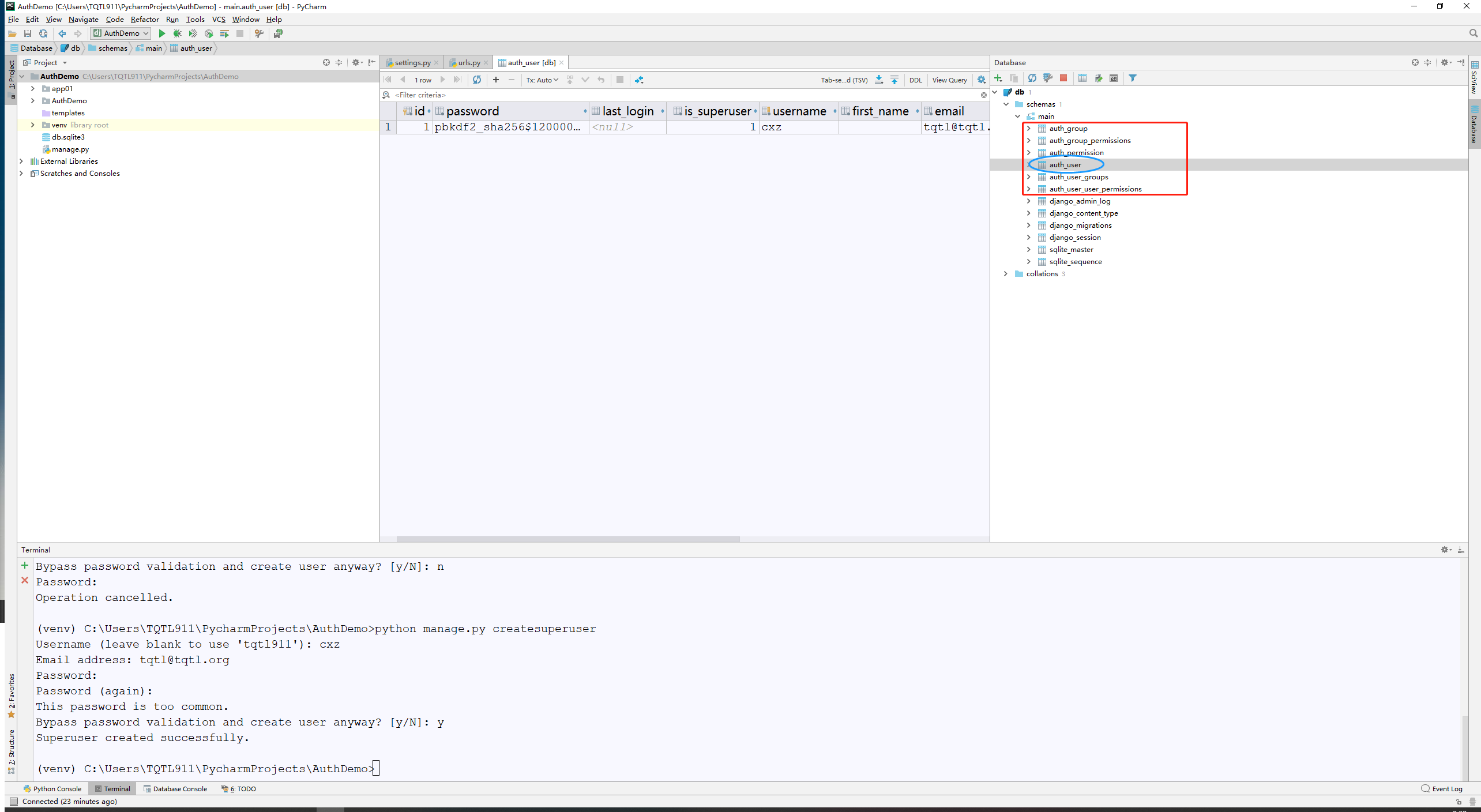
2、用户认证组件相关;
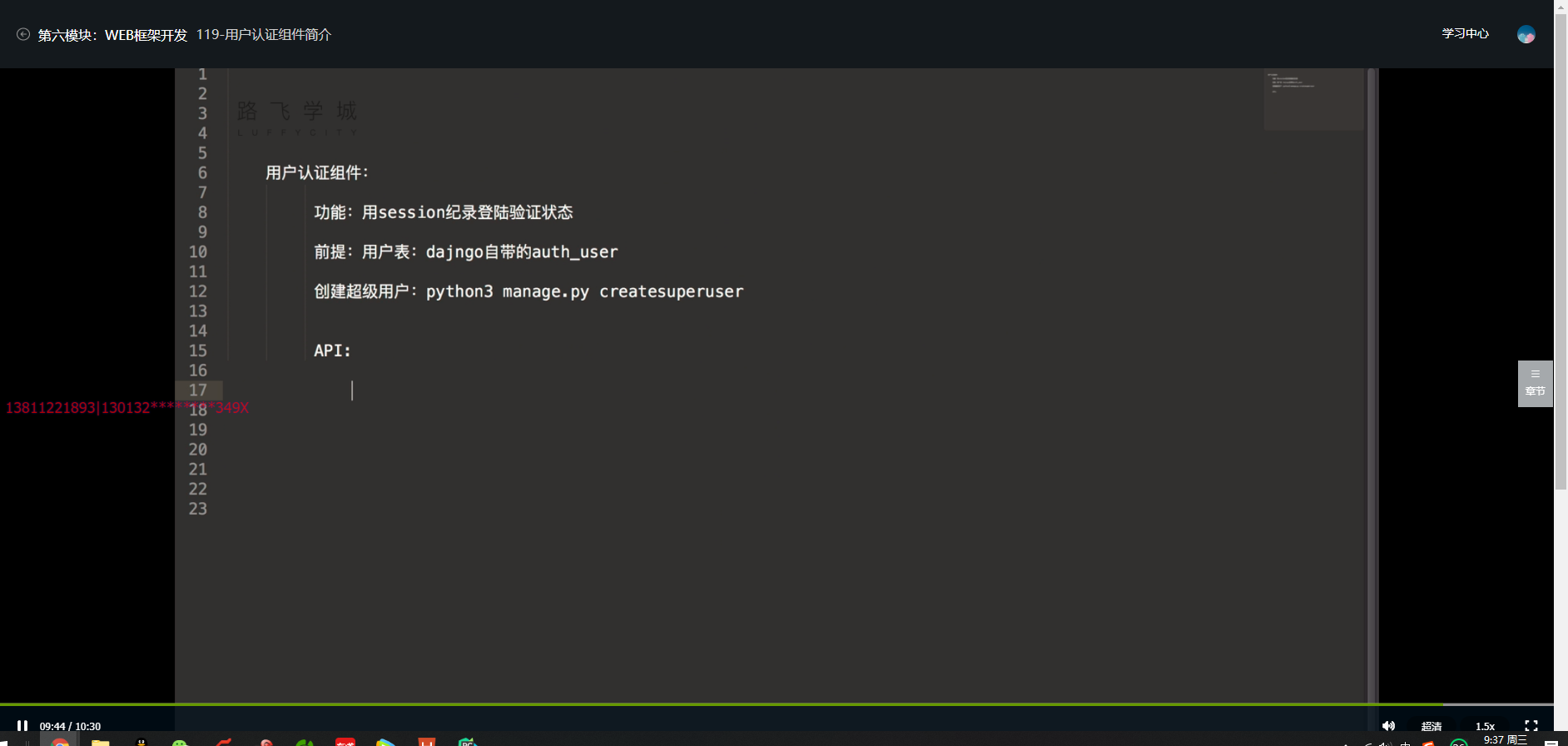
3、创建超级用户;
Python manage.py createsuperuser
Microsoft Windows [版本 10.0.17134.1] (c) 2018 Microsoft Corporation。保留所有权利。 (venv) C:\Users\TQTL911\PycharmProjects\AuthDemo>python manage.py makemigrations No changes detected (venv) C:\Users\TQTL911\PycharmProjects\AuthDemo>python manage.py migrate Operations to perform: Apply all migrations: admin, auth, contenttypes, sessions Running migrations: Applying contenttypes.0001_initial... OK Applying auth.0001_initial... OK Applying admin.0001_initial... OK Applying admin.0002_logentry_remove_auto_add... OK Applying admin.0003_logentry_add_action_flag_choices... OK Applying contenttypes.0002_remove_content_type_name... OK Applying auth.0002_alter_permission_name_max_length... OK Applying auth.0003_alter_user_email_max_length... OK Applying auth.0004_alter_user_username_opts... OK Applying auth.0005_alter_user_last_login_null... OK Applying auth.0006_require_contenttypes_0002... OK Applying auth.0007_alter_validators_add_error_messages... OK Applying auth.0008_alter_user_username_max_length... OK Applying auth.0009_alter_user_last_name_max_length... OK Applying sessions.0001_initial... OK (venv) C:\Users\TQTL911\PycharmProjects\AuthDemo>python manage.py createsuperuser Username (leave blank to use 'tqtl911'): cuixiaozhao Email address: Password: Password (again): This password is too short. It must contain at least 8 characters. This password is too common. This password is entirely numeric. Bypass password validation and create user anyway? [y/N]: n Password: Operation cancelled. (venv) C:\Users\TQTL911\PycharmProjects\AuthDemo>python manage.py createsuperuser Username (leave blank to use 'tqtl911'): cxz Email address: tqtl@tqtl.org Password: Password (again): This password is too common. Bypass password validation and create user anyway? [y/N]: y Superuser created successfully. (venv) C:\Users\TQTL911\PycharmProjects\AuthDemo>^A
120-基于用户认证组件的登录验证信息存储
1、创建Django项目-AuthDemo并添加应用app01;
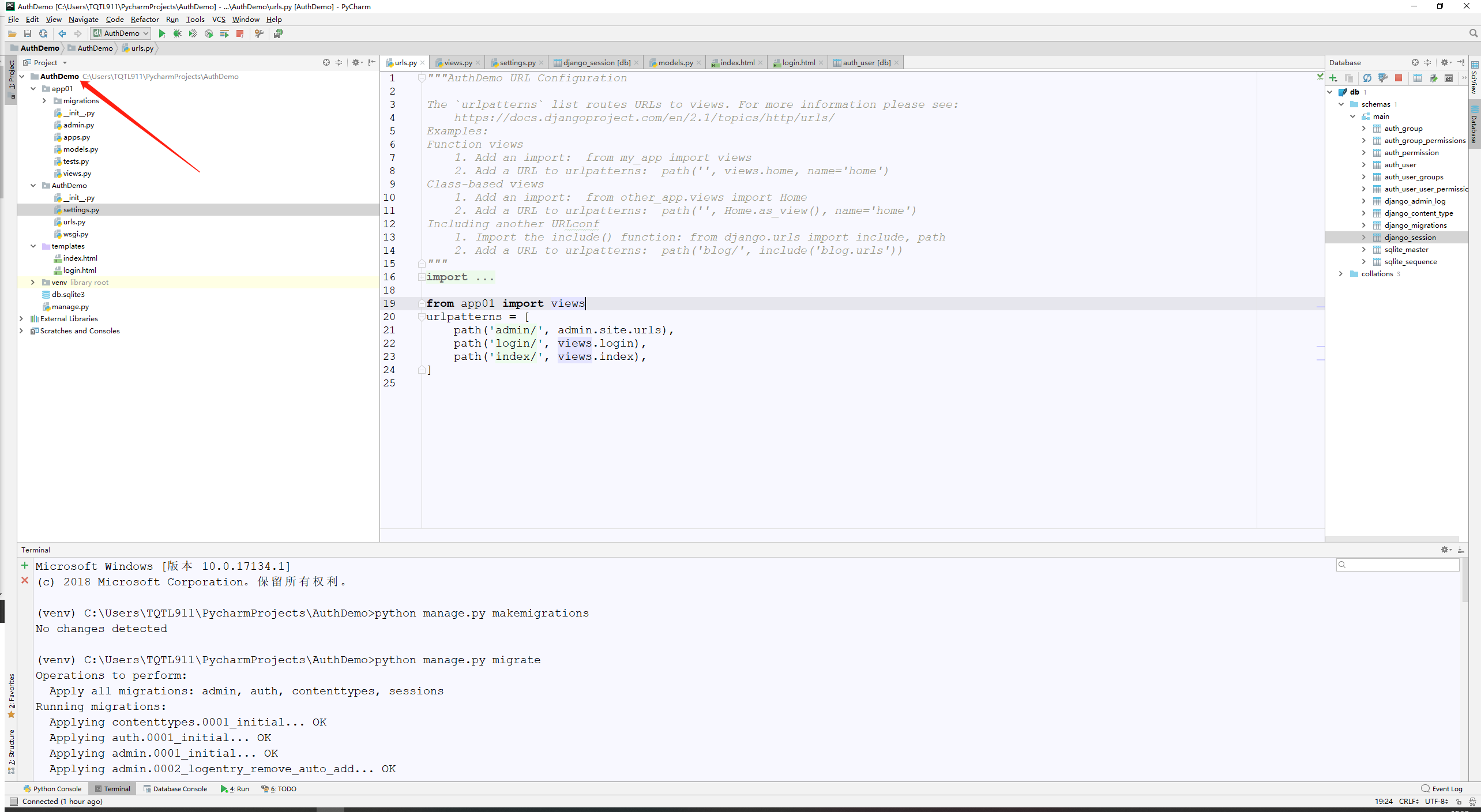
2、配置urls.py;
"""AuthDemo URL Configuration The `urlpatterns` list routes URLs to views. For more information please see: https://docs.djangoproject.com/en/2.1/topics/http/urls/ Examples: Function views 1. Add an import: from my_app import views 2. Add a URL to urlpatterns: path('', views.home, name='home') Class-based views 1. Add an import: from other_app.views import Home 2. Add a URL to urlpatterns: path('', Home.as_view(), name='home') Including another URLconf 1. Import the include() function: from django.urls import include, path 2. Add a URL to urlpatterns: path('blog/', include('blog.urls')) """ from django.contrib import admin from django.urls import path from app01 import views urlpatterns = [ path('admin/', admin.site.urls), path('login/', views.login), path('index/', views.index), ]
3、编写视图函数login、index等;
from django.shortcuts import render,redirect,HttpResponse # Create your views here. #导入用户认证模块 from django.contrib import auth from django.contrib.auth.models import User#User指代的就是django下的auth_user表; def login(request): if request.method == "POST": user = request.POST.get("user") pwd = request.POST.get("pwd") #如果验证成功,就返回User对象,否则返回None; user = auth.authenticate(username = user, password = pwd) if user: auth.login(request,user)#request.user:当前登录对象; return redirect("/index/") return render(request,"login.html",) def index(request): print("request.user:",request.user.username) print("request.user:",request.user.id) print("request.user:",request.user.is_anonymous) ''' request.user: request.user: None request.user: True ''' #判断是否登录; if request.user.is_anonymous: return redirect("/login/") return render(request,"index.html") #username = request.user.username #return render(request,"index.html",{"username":username})
4、创建超级用户;
python manage.py createsuperuser cxz
rosoft Windows [版本 10.0.17134.1] (c) 2018 Microsoft Corporation。保留所有权利。 (venv) C:\Users\TQTL911\PycharmProjects\AuthDemo>python manage.py makemigrations No changes detected (venv) C:\Users\TQTL911\PycharmProjects\AuthDemo>python manage.py migrate Operations to perform: Apply all migrations: admin, auth, contenttypes, sessions Running migrations: Applying contenttypes.0001_initial... OK Applying auth.0001_initial... OK Applying admin.0001_initial... OK Applying admin.0002_logentry_remove_auto_add... OK Applying admin.0003_logentry_add_action_flag_choices... OK Applying contenttypes.0002_remove_content_type_name... OK Applying auth.0002_alter_permission_name_max_length... OK Applying auth.0003_alter_user_email_max_length... OK Applying auth.0004_alter_user_username_opts... OK Applying auth.0005_alter_user_last_login_null... OK Applying auth.0006_require_contenttypes_0002... OK Applying auth.0007_alter_validators_add_error_messages... OK Applying auth.0008_alter_user_username_max_length... OK Applying auth.0009_alter_user_last_name_max_length... OK Applying sessions.0001_initial... OK (venv) C:\Users\TQTL911\PycharmProjects\AuthDemo>python manage.py createsuperuser Username (leave blank to use 'tqtl911'): cuixiaozhao Email address: Password: Password (again): This password is too short. It must contain at least 8 characters. This password is too common. This password is entirely numeric. Bypass password validation and create user anyway? [y/N]: n Password: Operation cancelled. (venv) C:\Users\TQTL911\PycharmProjects\AuthDemo>python manage.py createsuperuser Username (leave blank to use 'tqtl911'): cxz Email address: tqtl@tqtl.org Password: Password (again): This password is too common. Bypass password validation and create user anyway? [y/N]: y Superuser created successfully. (venv) C:\Users\TQTL911\PycharmProjects\AuthDemo>python manage.py createsuperuser Username (leave blank to use 'tqtl911'): ljp Email address: ljp@tqtl.org Password: Password (again): This password is too common. Bypass password validation and create user anyway? [y/N]: y Superuser created successfully. (venv) C:\Users\TQTL911\PycharmProjects\AuthDemo>python manage.py createsuperuser Username (leave blank to use 'tqtl911'): cxs Email address: cxs@tqtl.org Password: Password (again): This password is too common. Bypass password validation and create user anyway? [y/N]: n Password: Password (again): Error: Your passwords didn't match. Password: Password (again): Superuser created successfully. (venv) C:\Users\TQTL911\PycharmProjects\AuthDemo>
5、编写templates模本html文件;
index.html;
<!DOCTYPE html> <html lang="en"> <head> <meta charset="UTF-8"> <title>120-基于用户认证组件的登陆验证信息存储</title> <style type="text/css"> </style> </head> <body> <h1>Hi,{{ request.user.username }},Welcome to visit our website.</h1> </body> </html>
login.html;
<!DOCTYPE html> <html lang="en"> <head> <meta charset="UTF-8"> <title>120-基于用户认证组件的登陆验证信息存储</title> <style type="text/css"> </style> </head> <body> <form action="" method="post"> {% csrf_token %} 用户名: <input type="text" name="user"> 密码:<input type="password" name="pwd"> <input type="submit" value="submit" > </form> </body> </html>
6、启动Django项目并登陆验证;
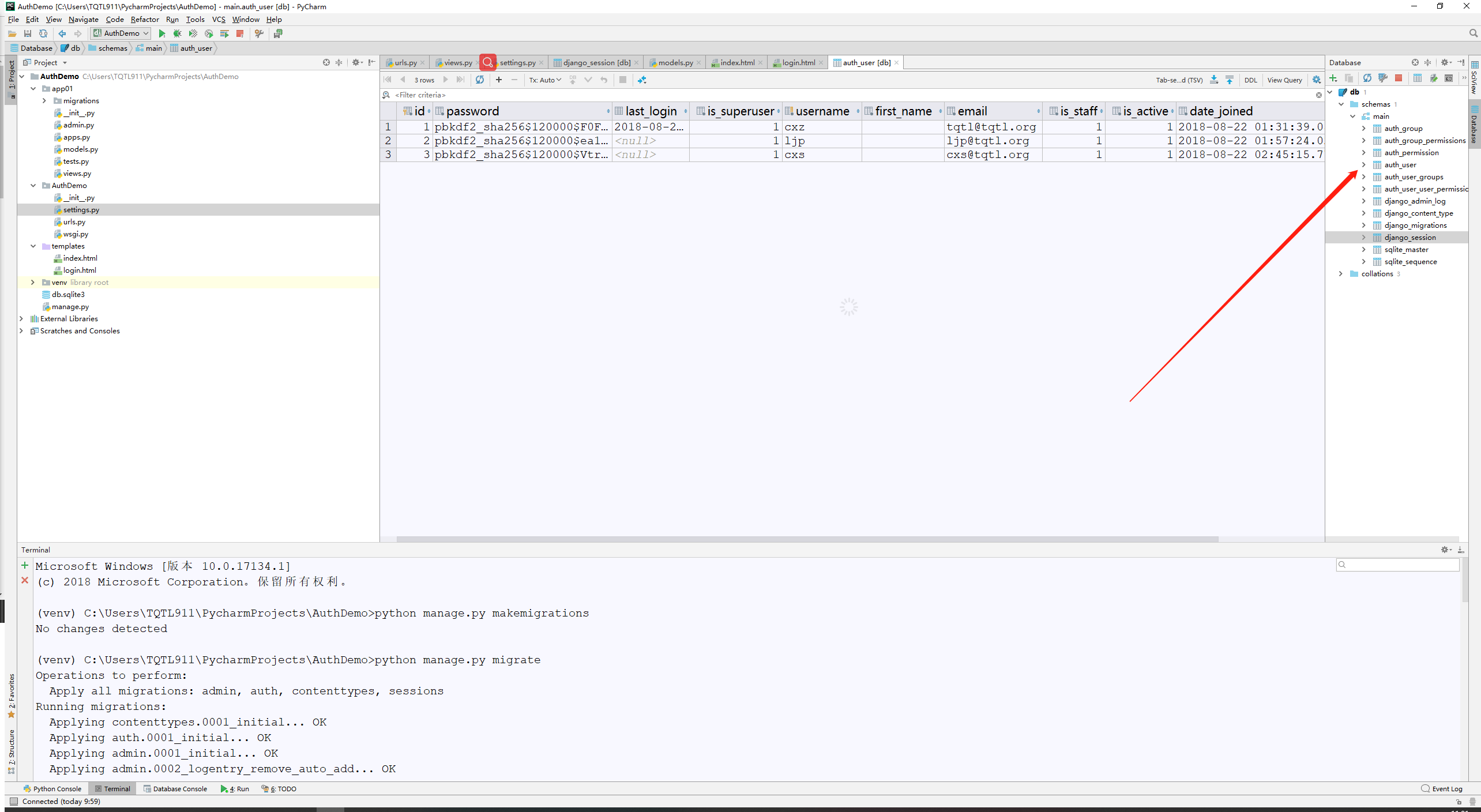
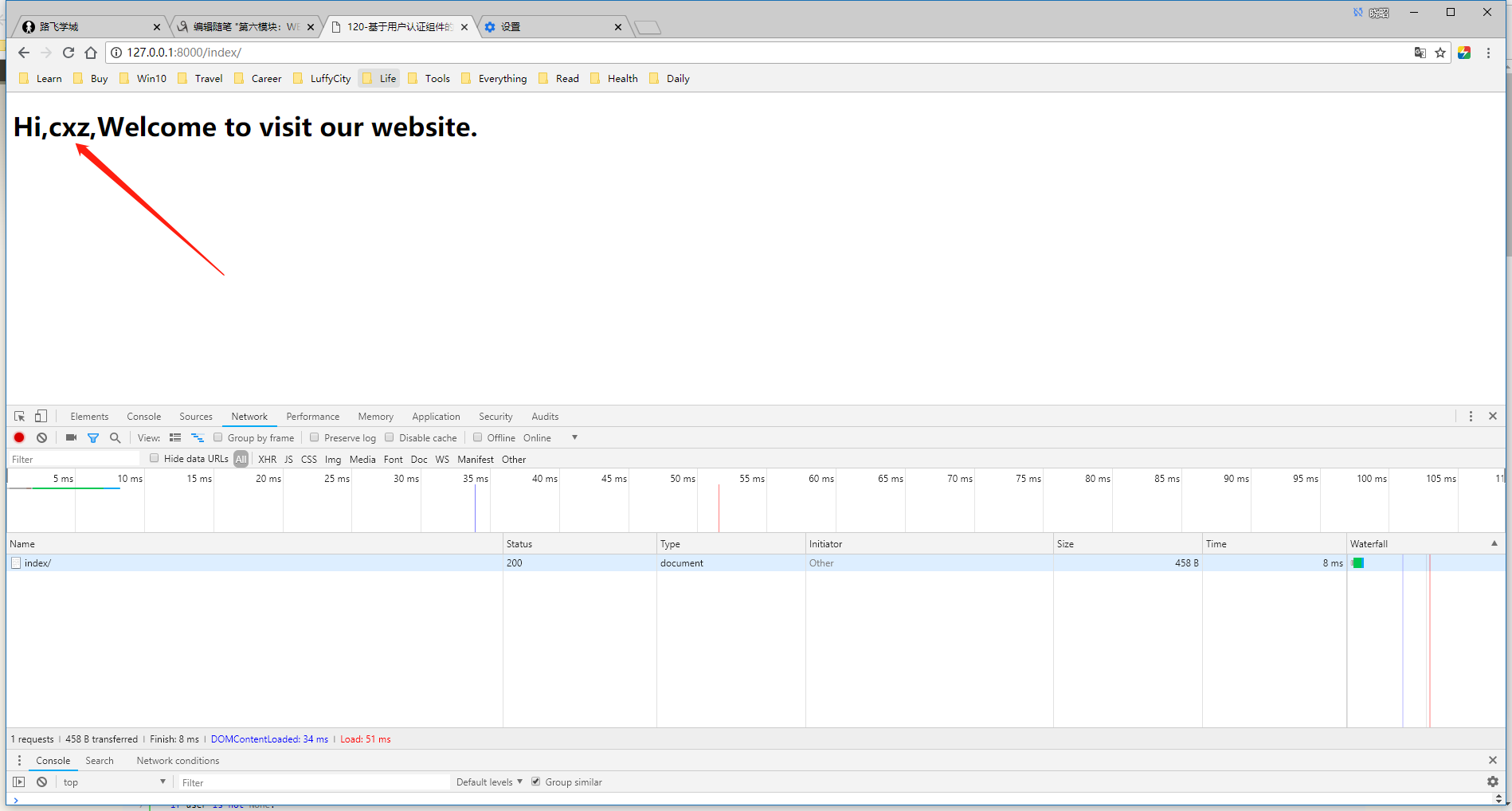
121-基于用户认证组件的注销功能
1、logout功能实现;
def logout(request): auth.logout(request) return redirect("/login/")
2、index.html;
<!DOCTYPE html> <html lang="en"> <head> <meta charset="UTF-8"> <title>120-基于用户认证组件的登陆验证信息存储</title> <style type="text/css"> </style> </head> <body> <h1>Hi,{{ request.user.username }},Welcome to visit our website.</h1> <a href="/logout/">注销</a> </body> </html>
122-基于用户认证组件的注册用户功能
1、基于用户认证组件的注册用户功能;
2、views.py;
from django.shortcuts import render,redirect,HttpResponse # Create your views here. #导入用户认证模块 from django.contrib import auth from django.contrib.auth.models import User#User指代的就是django下的auth_user表; def login(request): if request.method == "POST": user = request.POST.get("user") pwd = request.POST.get("pwd") #如果验证成功,就返回User对象,否则返回None; user = auth.authenticate(username = user, password = pwd) if user: auth.login(request,user)#request.user:当前登录对象; return redirect("/index/") return render(request,"login.html",) def index(request): print("request.user:",request.user.username) print("request.user:",request.user.id) print("request.user:",request.user.is_anonymous) ''' request.user: request.user: None request.user: True ''' #判断是否登录; #if request.user.is_anonymous: if not request.user.is_authenticated: return redirect("/login/") return render(request,"index.html") #username = request.user.username #return render(request,"index.html",{"username":username}) def logout(request): auth.logout(request) return redirect("/login/") def reg(request): if request.method == "POST": user = request.POST.get("user") pwd = request.POST.get("pwd") #User.objects.create(username= user,password=pwd)#不能使用该方式插入数据,因为此方法密码是明文传输的; User.objects.create_user(username = user,password=pwd) return redirect("/login/") return render(request,"reg.html")
3、urls.py;
"""AuthDemo URL Configuration The `urlpatterns` list routes URLs to views. For more information please see: https://docs.djangoproject.com/en/2.1/topics/http/urls/ Examples: Function views 1. Add an import: from my_app import views 2. Add a URL to urlpatterns: path('', views.home, name='home') Class-based views 1. Add an import: from other_app.views import Home 2. Add a URL to urlpatterns: path('', Home.as_view(), name='home') Including another URLconf 1. Import the include() function: from django.urls import include, path 2. Add a URL to urlpatterns: path('blog/', include('blog.urls')) """ from django.contrib import admin from django.urls import path from app01 import views urlpatterns = [ path('admin/', admin.site.urls), path('login/', views.login), path('index/', views.index), path('logout/', views.logout), path('reg/', views.reg), ]
4、reg.html;
<!DOCTYPE html> <html lang="en"> <head> <meta charset="UTF-8"> <title>122-基于用户认证组件的注册用户功能</title> <style type="text/css"> </style> </head> <body> <h3>注册</h3> <form action="" method="post"> {% csrf_token %} 用户名: <input type="text" name="user"> 密码:<input type="password" name="pwd"> <input type="submit" value="submit" > </form> </body> </html>
5、小结;
用户认证组件:
- 功能:使用session记录登陆验证状态;
- 前提:用户表,使用Django自带的auth_user;
- 创建超级用户:Python manage.py createsuperuser;
- API:
- from django.contrib import auth
- 如果验证成功则返回user对象,否则返回None;user = auth.authenticate(username =user,password = pwd)
- auth.login(request,user)#request.user 当前登陆对象
- auth.logout(request)
- from django.contrib,auth.models import User#User = auth_user表;
- request.user.is_authenticated()
- user = User.objects.create_user(Username = ' ',password = ' ',email = ' ' )
- 补充
- 匿名用户对象
- class models.AnonymousUser
- django.contrib.auth.models.AnonymousUser 类实现了django.contrib.auth.models.User接口,但是有如下几个不同点:
- id 永远为None;
- username永远为空字符串;
- get_username()永远返回空字符串;
- is_staff和is_superuser 永远为False;
- is_active 永远为False;
- groups和user_permissions永远为空;
- is_anonymous()返回True而不是False;
- is_authenticated()、check_password()、save()和delete()引发NotImplementedError
- 在Django1.8中,新增AnonymousUser.get_username()以更好地模拟django.contrib.auth.models.User
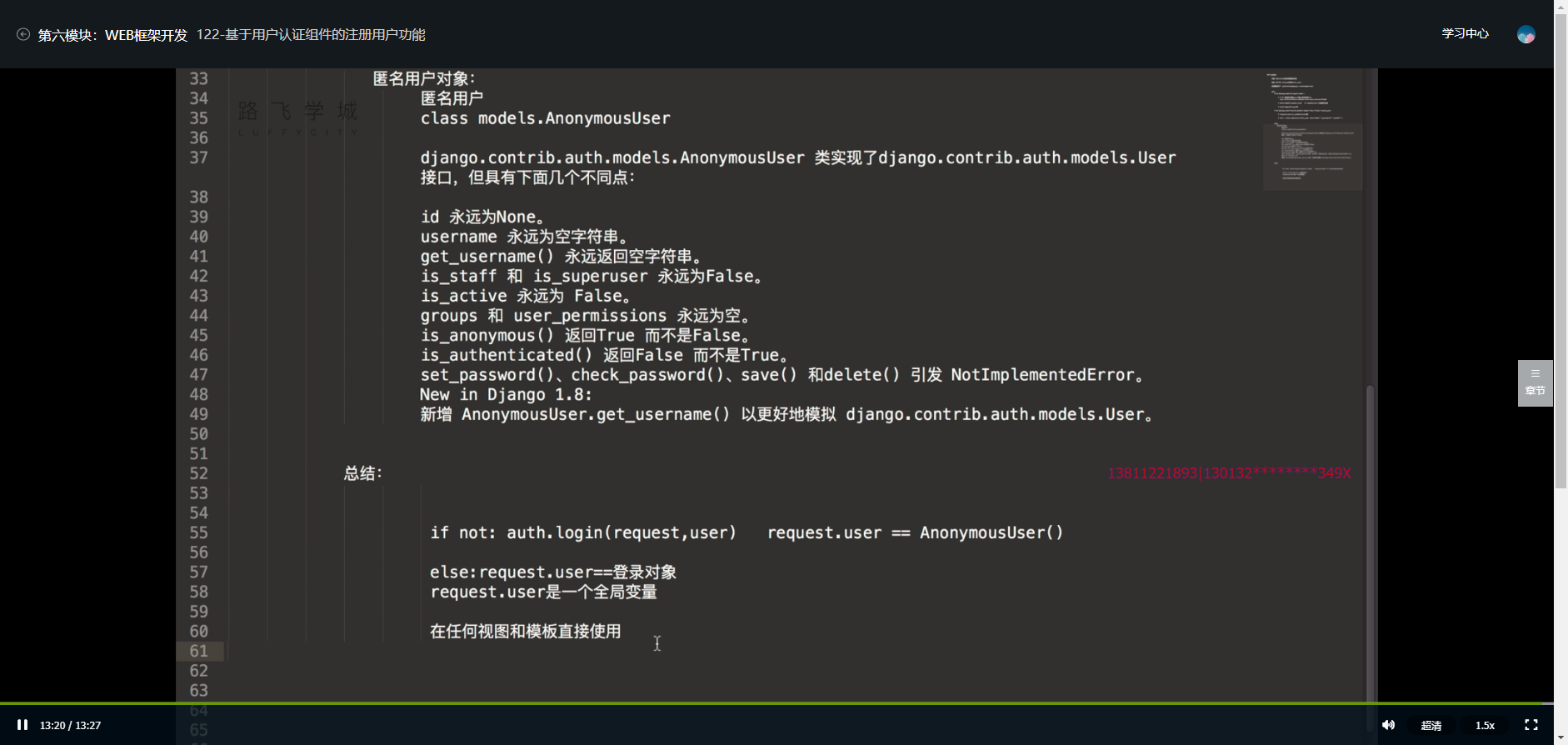
123-基于用户认证组件的认证装饰器
1、用户认证组件装饰器初识;
用户无序再在函数中写代码逻辑,通过顶部引入装饰器,来添加功能;
from django.contrib.auth.decorators import login_required
2、settings.py;
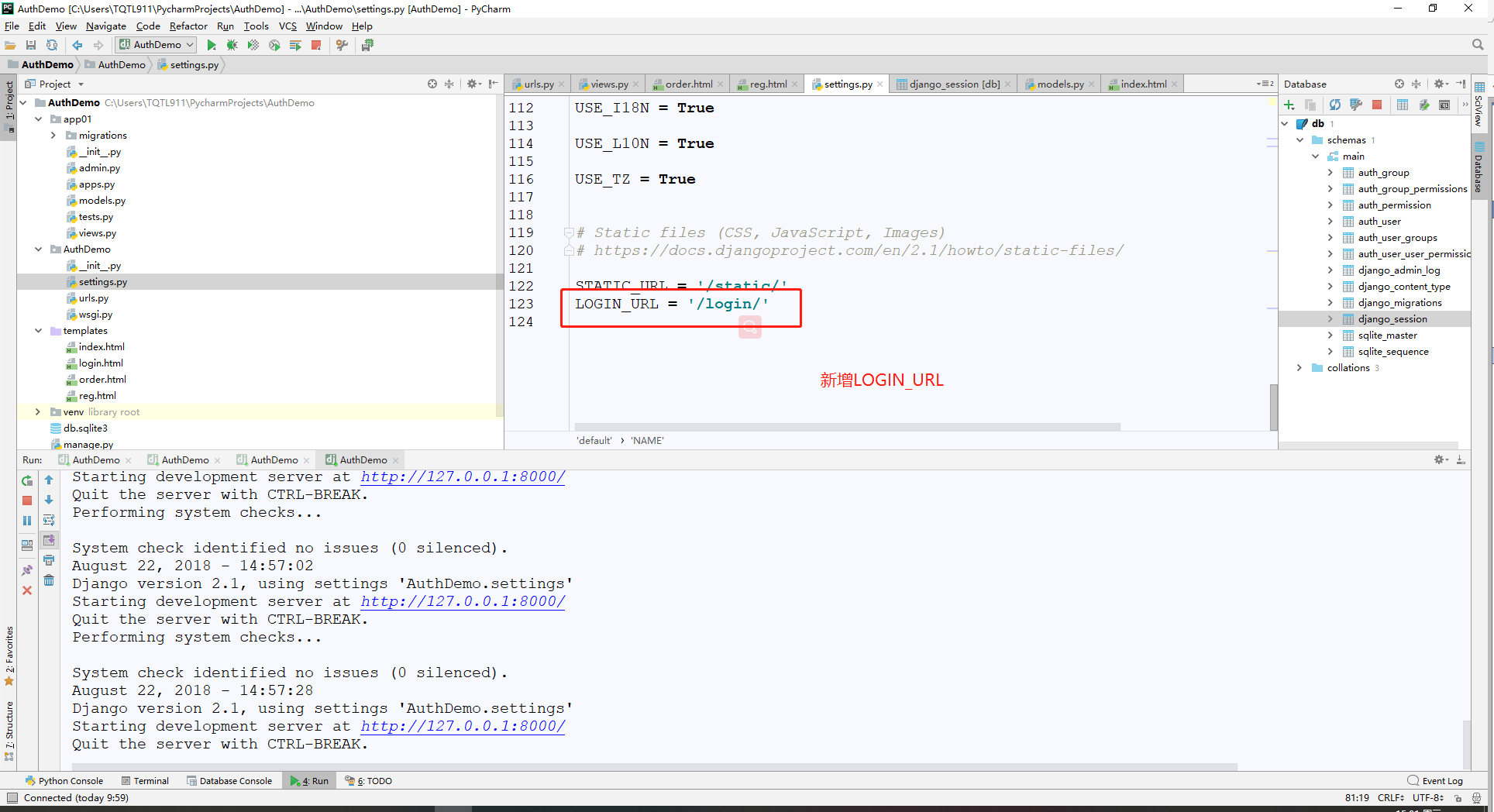
3、views.py;
from django.shortcuts import render,redirect,HttpResponse # Create your views here. #导入用户认证模块 from django.contrib import auth from django.contrib.auth.models import User#User指代的就是django下的auth_user表; #导入django的装饰器; from django.contrib.auth.decorators import login_required def login(request): if request.method == "POST": user = request.POST.get("user") pwd = request.POST.get("pwd") #如果验证成功,就返回User对象,否则返回None; user = auth.authenticate(username = user, password = pwd) if user: auth.login(request,user)#request.user:当前登录对象; next_url = request.GET.get("next","/index/") return redirect(next_url) return render(request,"login.html",) @login_required def index(request): print("request.user:",request.user.username) print("request.user:",request.user.id) print("request.user:",request.user.is_anonymous) ''' request.user: request.user: None request.user: True ''' #判断是否登录; #if request.user.is_anonymous: # if not request.user.is_authenticated: # return redirect("/login/") return render(request,"index.html") # username = request.user.username # return render(request,"index.html",{"username":username}) def logout(request): auth.logout(request) return redirect("/login/") def reg(request): # if request.method == "POST": # user = request.POST.get("user") # pwd = request.POST.get("pwd") # # #User.objects.create(username= user,password=pwd)#不能使用该方式插入数据,因为此方法密码是明文传输的; # User.objects.create_user(username = user,password=pwd) # return redirect("/login/") return render(request,"reg.html") @login_required def order(request): # if not request.user.is_authenticated: # return redirect("/login/") return render(request,"order.html")
4、urls.py;
"""AuthDemo URL Configuration The `urlpatterns` list routes URLs to views. For more information please see: https://docs.djangoproject.com/en/2.1/topics/http/urls/ Examples: Function views 1. Add an import: from my_app import views 2. Add a URL to urlpatterns: path('', views.home, name='home') Class-based views 1. Add an import: from other_app.views import Home 2. Add a URL to urlpatterns: path('', Home.as_view(), name='home') Including another URLconf 1. Import the include() function: from django.urls import include, path 2. Add a URL to urlpatterns: path('blog/', include('blog.urls')) """ from django.contrib import admin from django.urls import path from app01 import views urlpatterns = [ path('admin/', admin.site.urls), path('login/', views.login), path('index/', views.index), path('order/', views.order), path('logout/', views.logout), path('reg/', views.reg), ]
5、order.html;
<!DOCTYPE html> <html lang="en"> <head> <meta charset="UTF-8"> <title>order</title> <style type="text/css"> </style> </head> <body> <h3>order</h3> </body> </html>
6、跳转的URL详情;
http://127.0.0.1:8000/login/?next=/order/
http://127.0.0.1:8000/login/?next=/index/
124-中间件的实现流程
1、Django中中间件的概念;
中间件顾名思义,是介于request与response处理之间的一道处理过程,相对比较轻量级,并且在全局上改变django的输入与输出。因为改变的是全局,所以需要谨慎实用,用不好会影响到性能。
Django的中间件的定义:
Middleware is a framework of hooks into Django’s request/response processing. <br>It’s a light, low-level “plugin” system for globally altering Django’s input or output.
2、Django中默认的Middleware;
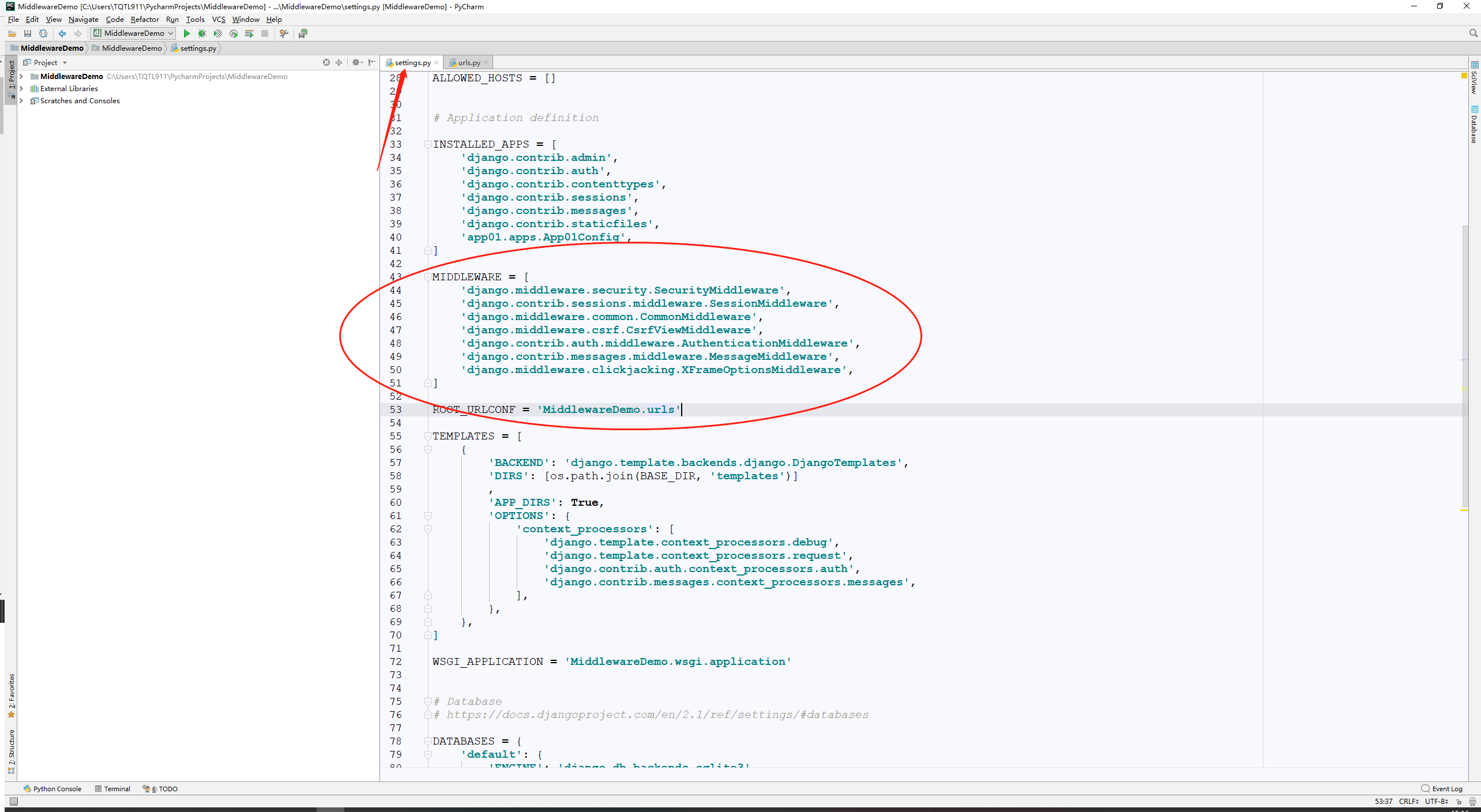
3、请求流程图,如下:
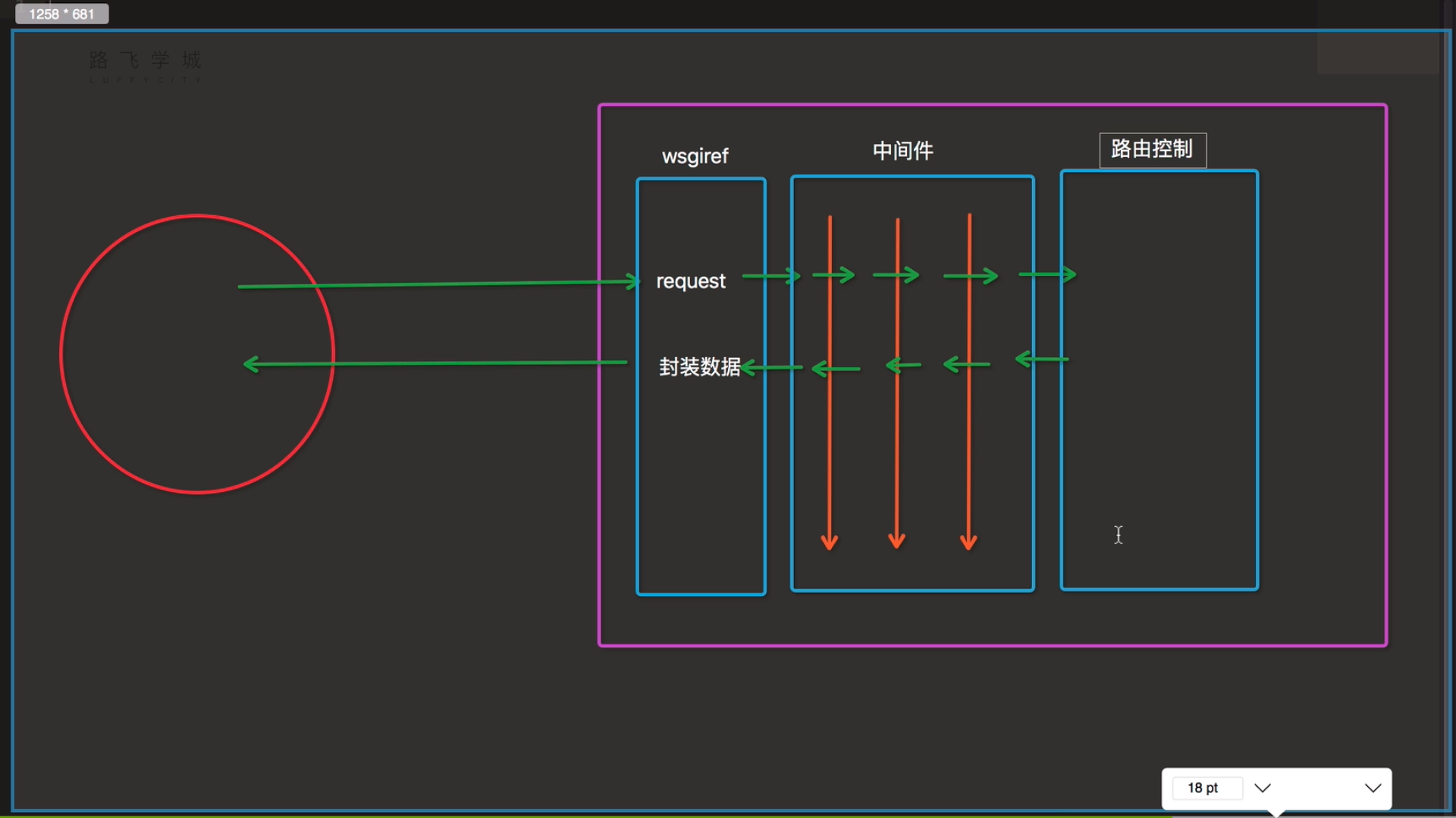
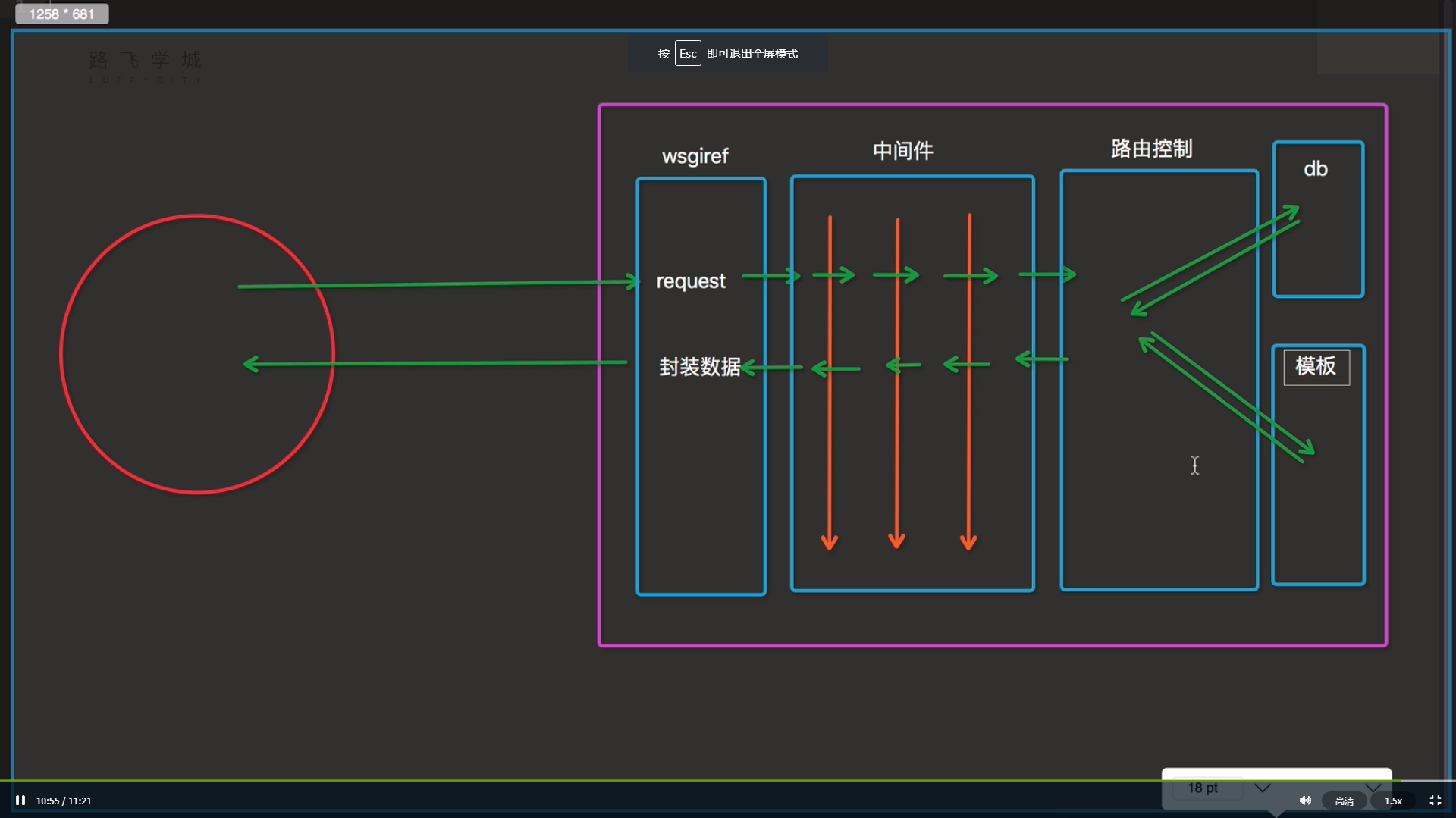
125-中间件的process_request和process_response方法
1、应用app01下新增my_middleware.py文件;
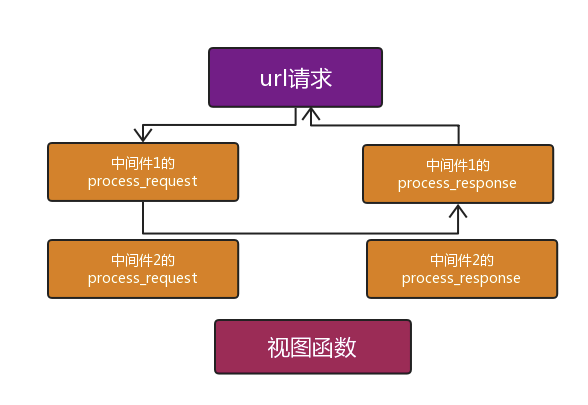
#!/usr/bin/env python3 # -*- coding:utf-8 -*- # __Author__:TQTL911 # Version:python3.6.6 # Time:2018/8/22 15:20 #导入MiddlewareMixin中间件; from django.utils.deprecation import MiddlewareMixin class CustomerMiddleware(MiddlewareMixin): def process_request(self,request): print("CustomMiddleWare process_request......") def process_response(self,request,response): print("CustomMiddleWare process_response......") return response class CustomerMiddleware2(MiddlewareMixin): def process_request(self,request): print("CustomMiddleWare process_request222......") def process_response(self,request,response): print("CustomMiddleWare process_response222......") return response class CustomerMiddleware3(MiddlewareMixin): def process_request(self,request): print("CustomMiddleWare process_request3333......")
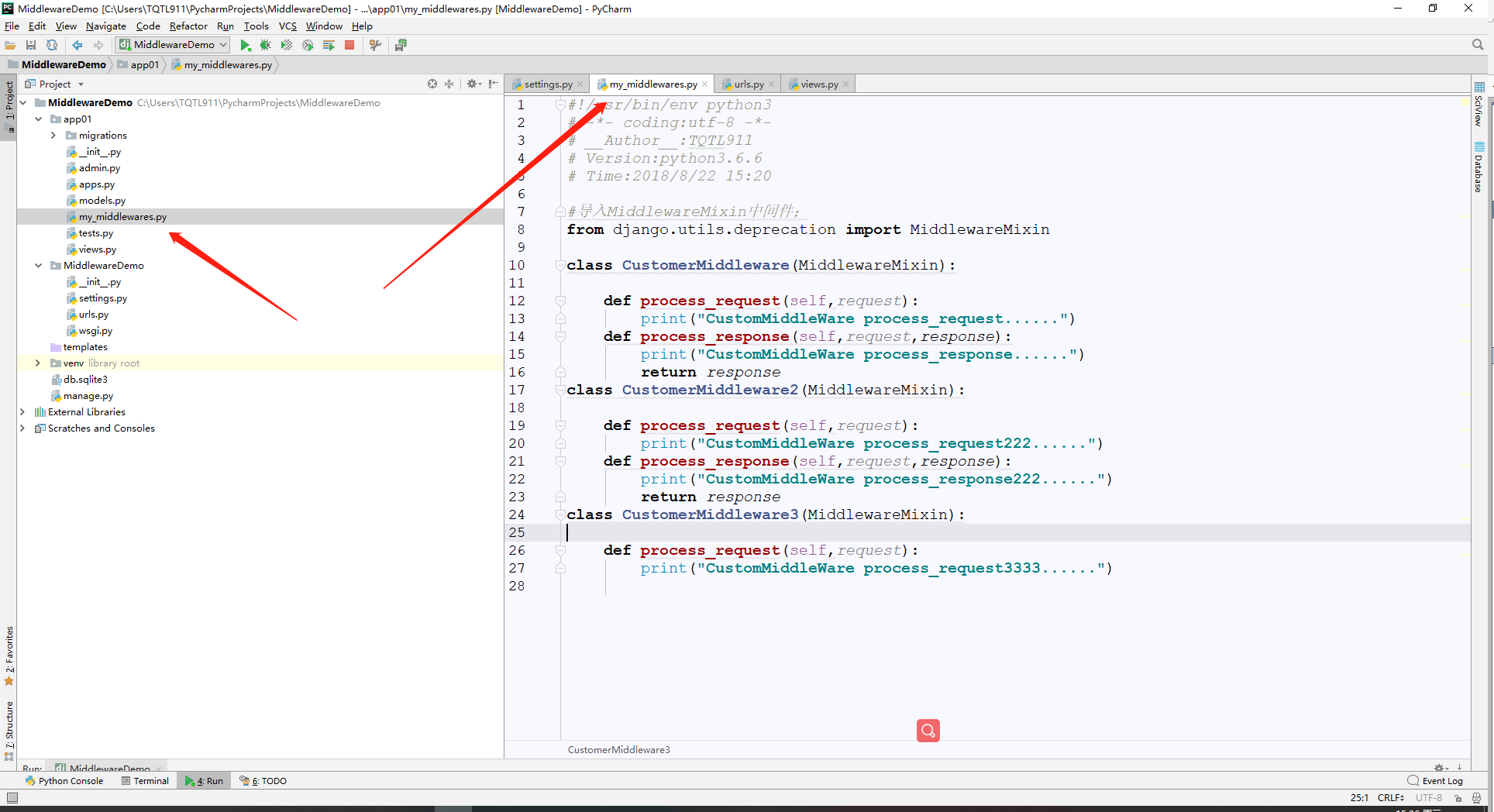
2、settings.py中配置引入自定义“中间件”;
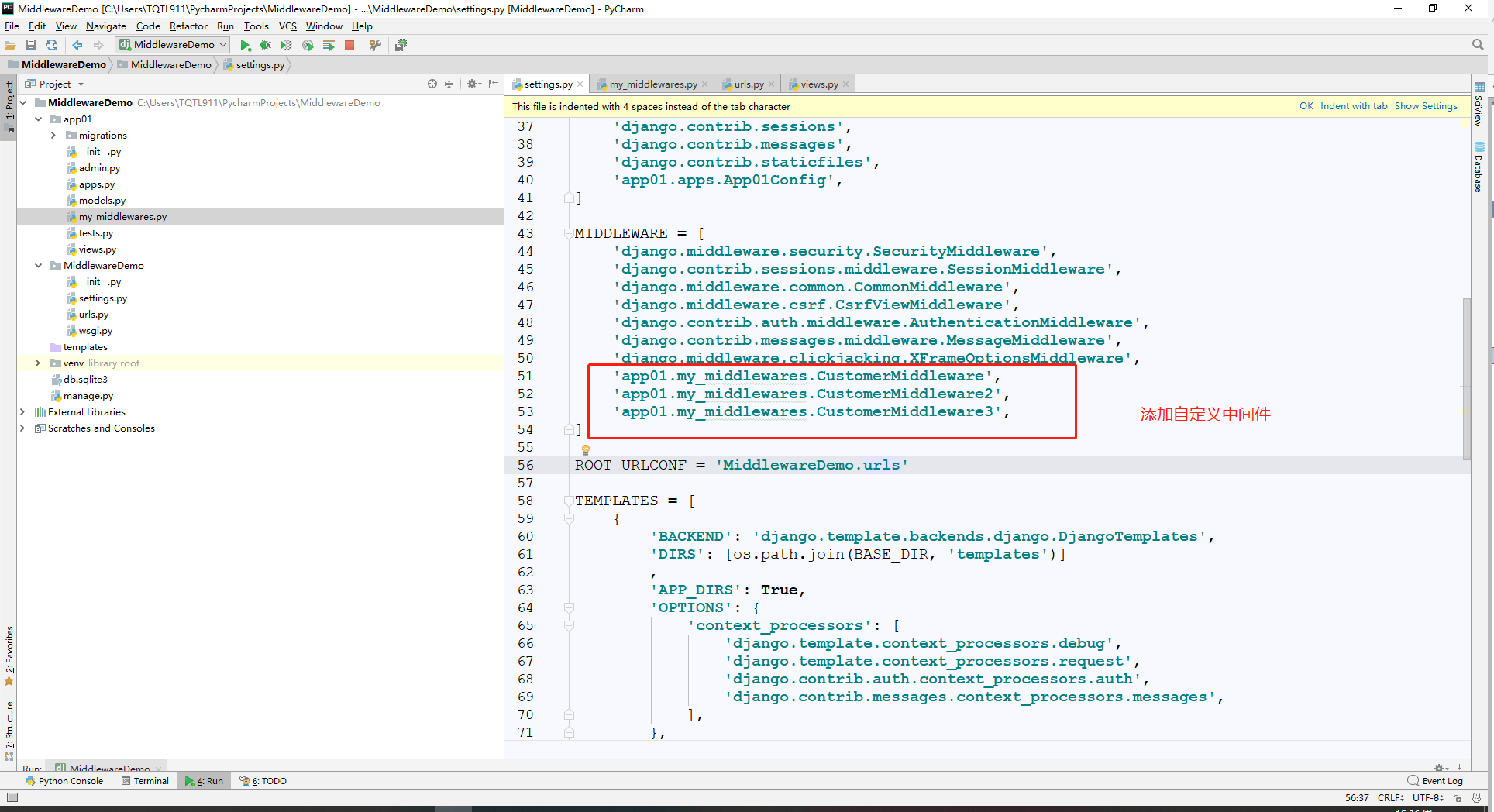
3、urls.py配置路径;
"""MiddlewareDemo URL Configuration The `urlpatterns` list routes URLs to views. For more information please see: https://docs.djangoproject.com/en/2.1/topics/http/urls/ Examples: Function views 1. Add an import: from my_app import views 2. Add a URL to urlpatterns: path('', views.home, name='home') Class-based views 1. Add an import: from other_app.views import Home 2. Add a URL to urlpatterns: path('', Home.as_view(), name='home') Including another URLconf 1. Import the include() function: from django.urls import include, path 2. Add a URL to urlpatterns: path('blog/', include('blog.urls')) """ from django.contrib import admin from django.urls import path from app01 import views urlpatterns = [ path('admin/', admin.site.urls), path('index/', views.index), path('index_new/', views.index_new), ]
4、编写视图函数views.py;
from django.shortcuts import render,redirect,HttpResponse # Create your views here. def index(request): return HttpResponse("Index") def index_new(request): return HttpResponse("Index_new")
5、进行验证;
You have 15 unapplied migration(s). Your project may not work properly until you apply the migrations for app(s): admin, auth, contenttypes, sessions. Run 'python manage.py migrate' to apply them. August 22, 2018 - 15:33:20 Django version 2.1, using settings 'MiddlewareDemo.settings' Starting development server at http://127.0.0.1:8000/ Quit the server with CTRL-BREAK. CustomMiddleWare process_request...... [22/Aug/2018 15:33:22] "GET /index_new/ HTTP/1.1" 200 9 CustomMiddleWare process_request222...... CustomMiddleWare process_request3333...... CustomMiddleWare process_response222...... CustomMiddleWare process_response...... Performing system checks... System check identified no issues (0 silenced). You have 15 unapplied migration(s). Your project may not work properly until you apply the migrations for app(s): admin, auth, contenttypes, sessions. Run 'python manage.py migrate' to apply them. August 22, 2018 - 15:39:35 Django version 2.1, using settings 'MiddlewareDemo.settings' Starting development server at http://127.0.0.1:8000/ Quit the server with CTRL-BREAK.
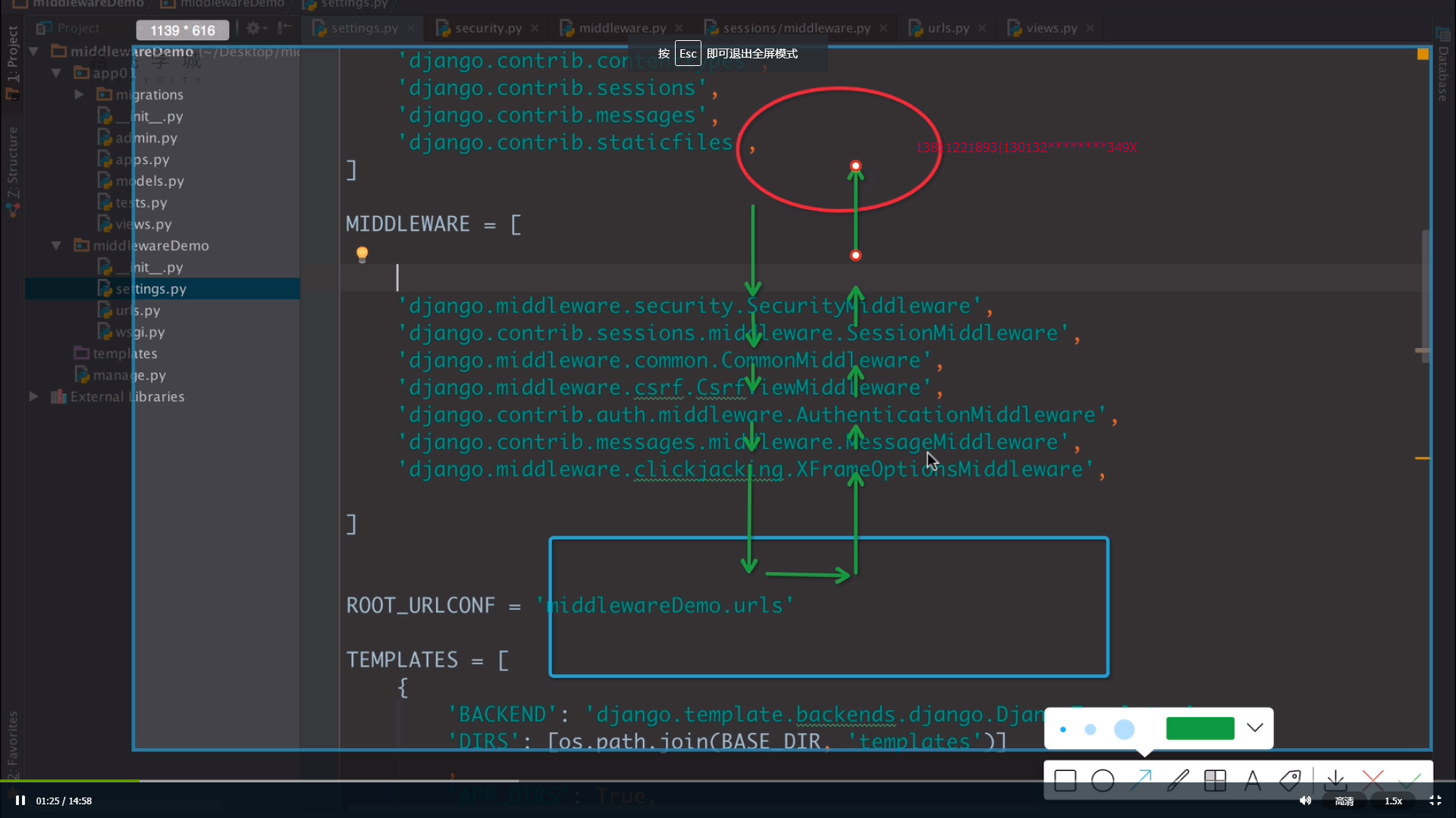
126-中间件之process_view方法
1、process-view的执行顺序;
#!/usr/bin/env python3 # -*- coding:utf-8 -*- # __Author__:TQTL911 # Version:python3.6.6 # Time:2018/8/22 15:20 #导入MiddlewareMixin中间件; from django.utils.deprecation import MiddlewareMixin from django.shortcuts import HttpResponse class CustomerMiddleware(MiddlewareMixin): def process_request(self,request): print("CustomMiddleWare process_request......") #return HttpResponse("forbidden") def process_response(self,request,response): print("CustomMiddleWare process_response......") return response def process_view(self,request, callback, callback_args, callback_kwargs): #print("=====>",callback(callback_args)) print("process_view") class CustomerMiddleware2(MiddlewareMixin): def process_request(self,request): print("CustomMiddleWare process_request222......") def process_response(self,request,response): print("CustomMiddleWare process_response222......") return response def process_view(self,request, callback, callback_args, callback_kwargs): print("22222process_view") class CustomerMiddleware3(MiddlewareMixin): def process_request(self,request): print("CustomMiddleWare process_request3333......")
操作日志:
System check identified no issues (0 silenced). You have 15 unapplied migration(s). Your project may not work properly until you apply the migrations for app(s): admin, auth, contenttypes, sessions. Run 'python manage.py migrate' to apply them. August 22, 2018 - 15:49:19 Django version 2.1, using settings 'MiddlewareDemo.settings' Starting development server at http://127.0.0.1:8000/ Quit the server with CTRL-BREAK. CustomMiddleWare process_request...... [22/Aug/2018 15:50:51] "GET /index_new/ HTTP/1.1" 200 9 CustomMiddleWare process_request222...... CustomMiddleWare process_request3333...... process_view 22222process_view CustomMiddleWare process_response222...... CustomMiddleWare process_response......
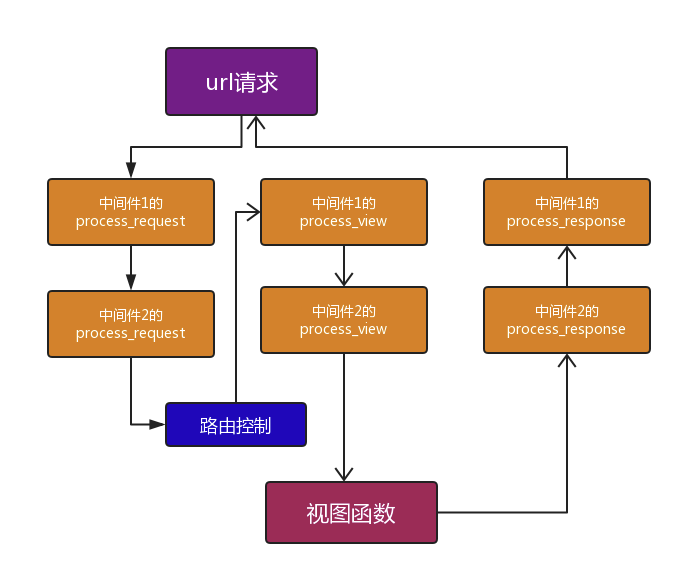
127-中间件之process_exception
1、Django中间件之process_exception;
#!/usr/bin/env python3 # -*- coding:utf-8 -*- # __Author__:TQTL911 # Version:python3.6.6 # Time:2018/8/22 15:20 #导入MiddlewareMixin中间件; from django.utils.deprecation import MiddlewareMixin from django.shortcuts import HttpResponse class CustomerMiddleware(MiddlewareMixin): def process_request(self,request): print("CustomMiddleWare process_request......") #return HttpResponse("forbidden") def process_response(self,request,response): print("CustomMiddleWare process_response......") return response def process_view(self,request, callback, callback_args, callback_kwargs): #print("=====>",callback(callback_args)) print("process_view") def process_exception(self,request, exception): print("CustomMiddleware exception11111") class CustomerMiddleware2(MiddlewareMixin): def process_request(self,request): print("CustomMiddleWare process_request222......") def process_response(self,request,response): print("CustomMiddleWare process_response222......") return response def process_view(self,request, callback, callback_args, callback_kwargs): print("22222process_view") def process_exception(self,request, exception): print("CustomMiddleware exception22222") class CustomerMiddleware3(MiddlewareMixin): def process_request(self,request): print("CustomMiddleWare process_request3333......")
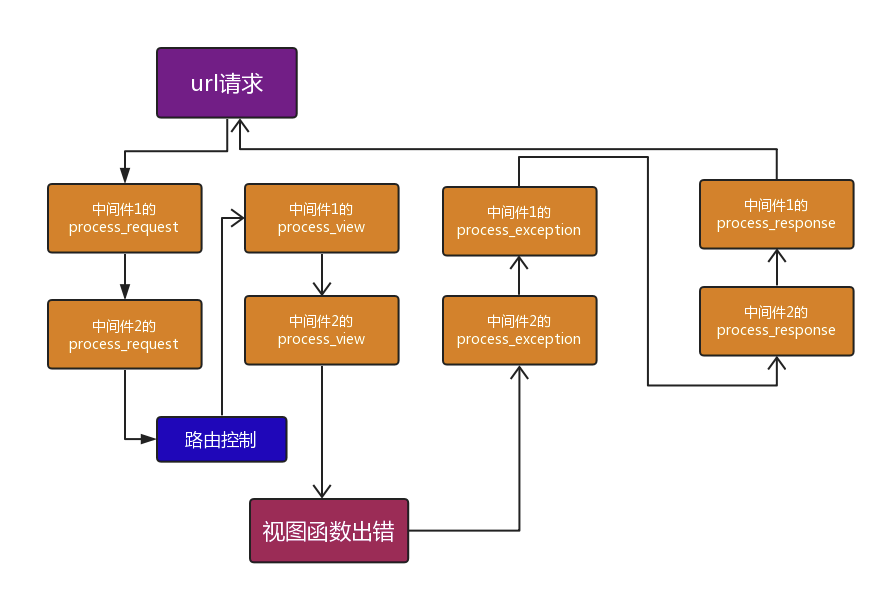
128-中间之应用
1、做IP访问频率的限制(比如防爬虫);
2、URL访问过滤;
3、middleware是一把双刃剑,具体使用装饰器还是middleware要结合具体业务场景;
mymiddleware.py;
from django.utils.deprecation import MiddlewareMixin from django.shortcuts import HttpResponse,redirect from AuthDemo import settings class AuthMiddleware(MiddlewareMixin): def process_request(self,request): white_list = settings.WHITE_LIST if request.path in white_list: return None if not request.user.is_authenticated: return redirect("/login/")
settings.py中引入白名单;
WHITE_LIST = ['/login/','/reg/','logout']
